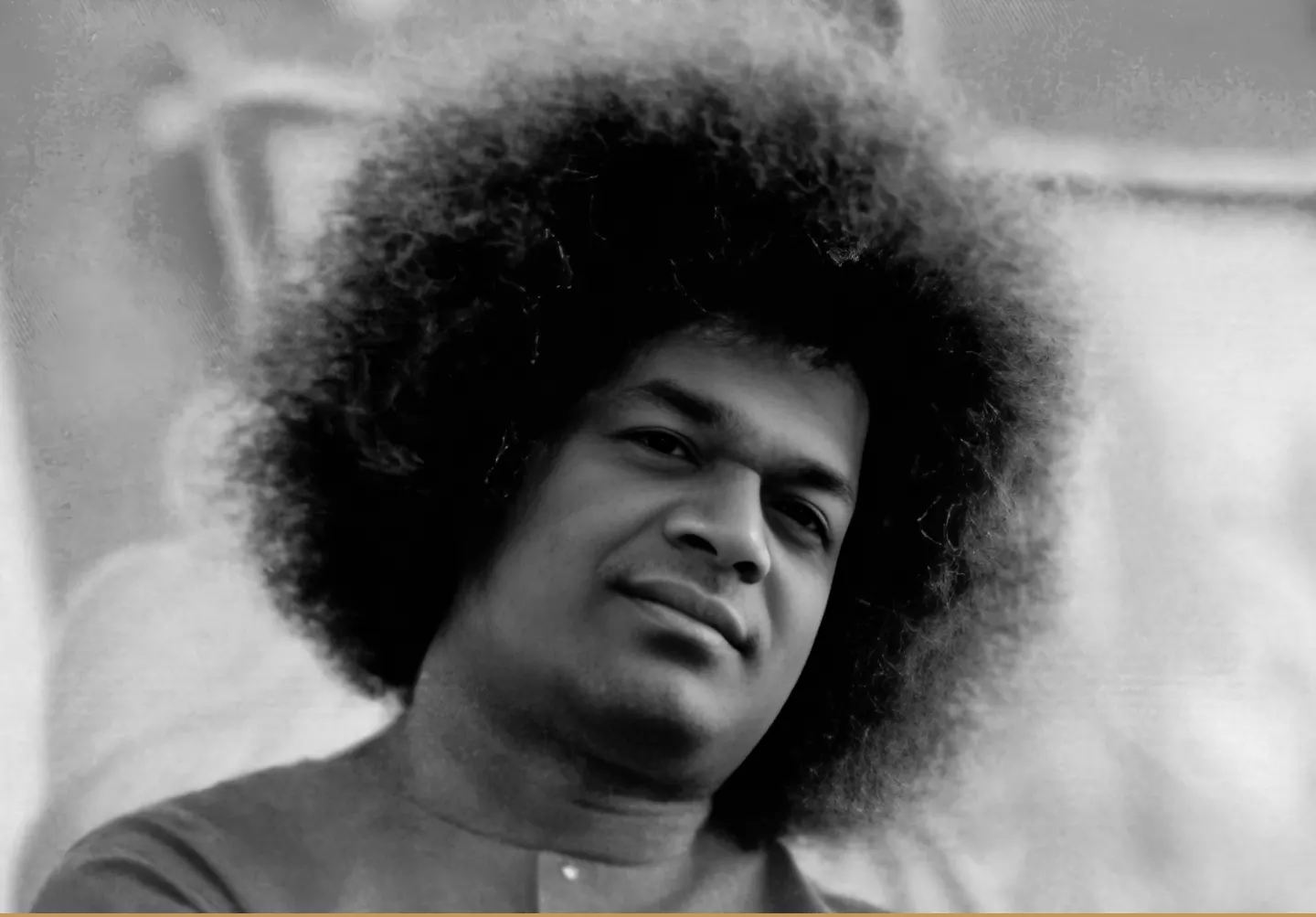
Timeline
1926 - 1950
1926
Venkata Sathya Narayana Raju is born as the fourth child of Srimati Easwaramma and Sri Pedda Venkappa Raju of Puttaparthi.
1939
Sathya writes and directs the play, “Cheppinattu Chesthara?” (Do you act as you speak?) to remind the village folk the importance of unity of thought, word, and deed.
1940
October 20: Fourteen-year-old Sathya reveals his Avataric identity as the reincarnation of the Sai Baba of Shirdi. He teaches his first Bhajan, Manasa Bhajare Guru Charanam, Dustara Bhavasagara Taranam. Ever since, this day is celebrated as Avatar Declaration Day.
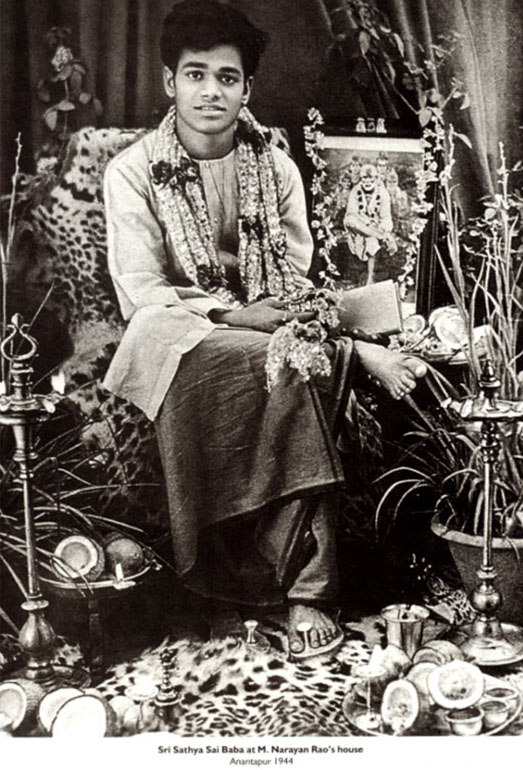
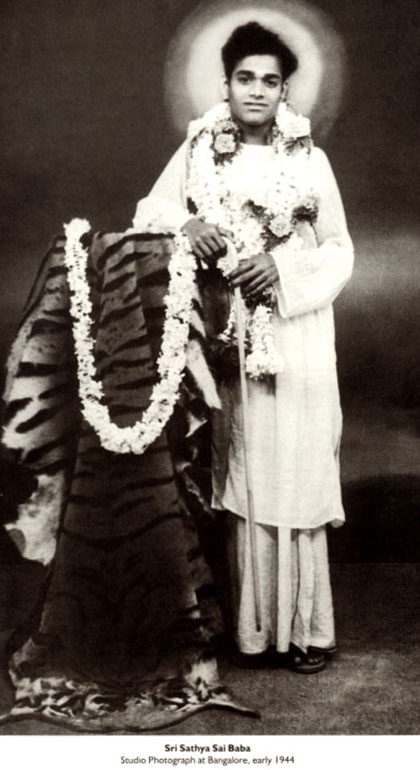


1945
On Vaikuntha Ekadashi day (December 14th), the first Mandir of Baba is inaugurated in Puttaparthi.

1942 - 1946
Baba’s first visits to Anantapur, Hospet, Madras, Bangalore, Mysore, Bellary, Tirupati and Hyderabad.
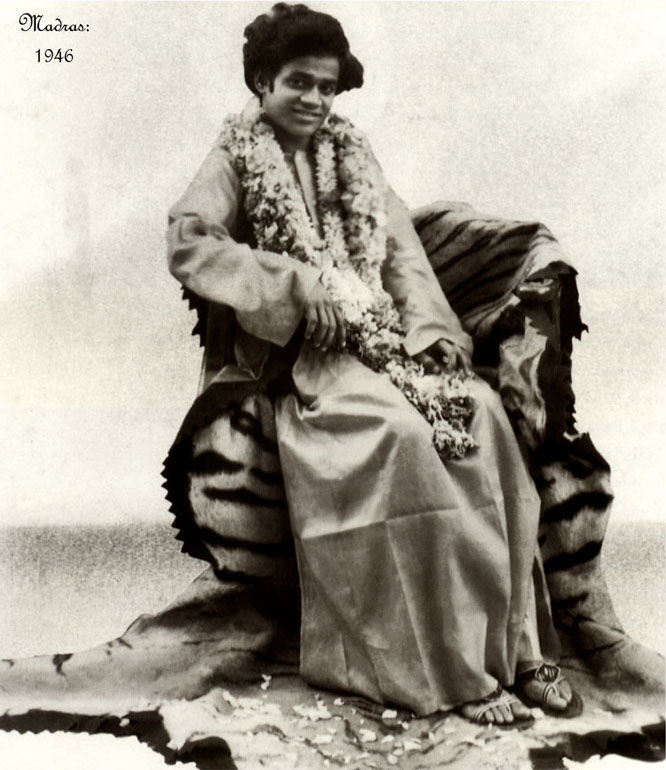

1946
July 10: Baba lays the foundation stone for the Shirdi Sai temple in Guindy, a suburb of Madras.
October 6: First Dasera celebrations at Puttaparthi
October 7: The Royal family of Mysore invited Baba to visit them, and He responded to the invitation by visiting them in the same month.
1947
- March 2: The first Lingodbhavam took place during the Mahashivaratri Celebrations at Puttaparthi
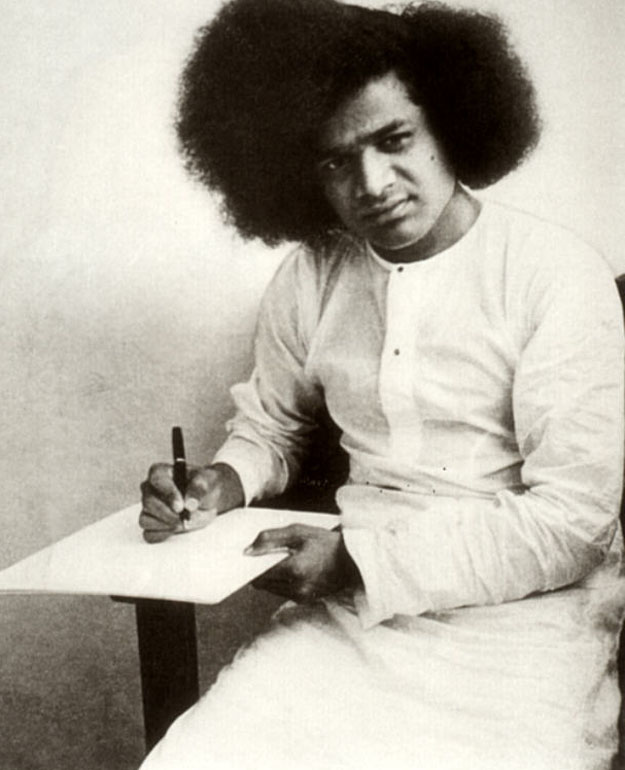
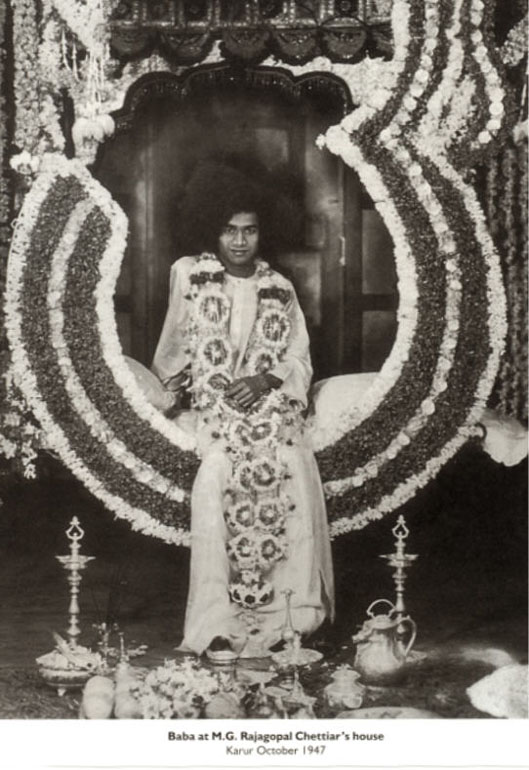
1947
- May 25: Baba writes a landmark letter to his brother, Sri Seshama Raju, outlining the purpose of his incarnation and the tasks to be achieved in the years ahead.
- October 25: Baba delivers his first-ever public speech in Karur, in Tamil Nadu, starting the tradition of instructing through discourses.

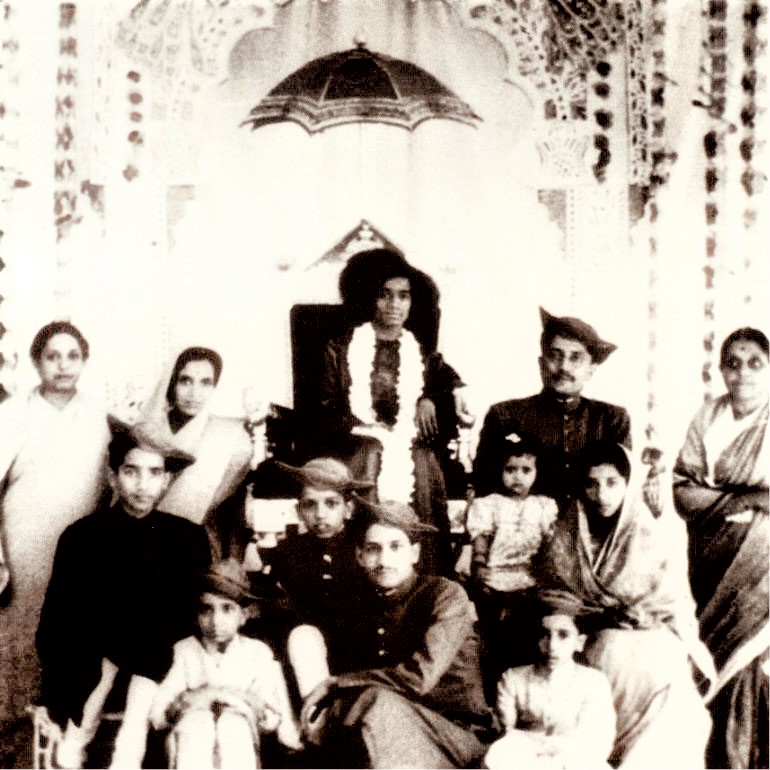
1948
- January 14: The foundation stone for the Prasanthi Nilayam Mandir was laid.
- June 17: Baba visits the Royal Family of Sandur at their invitation
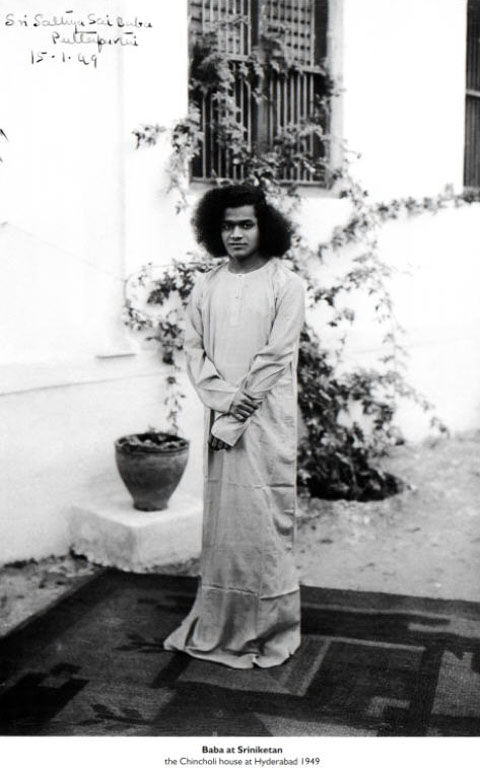
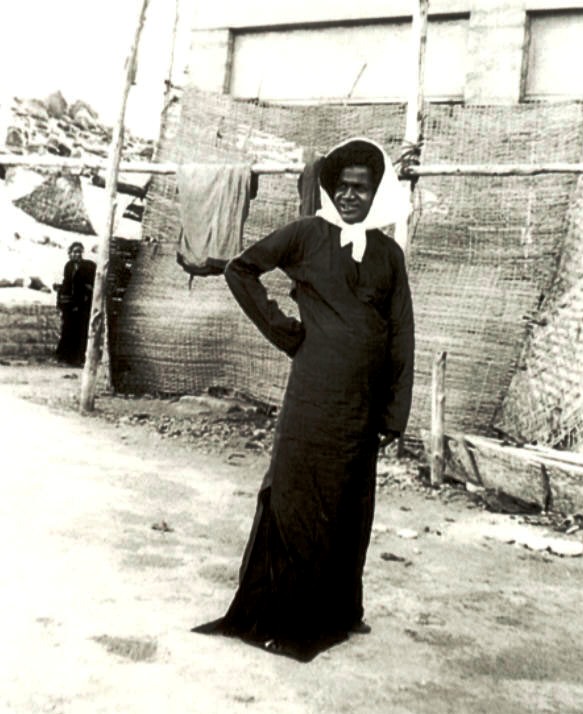

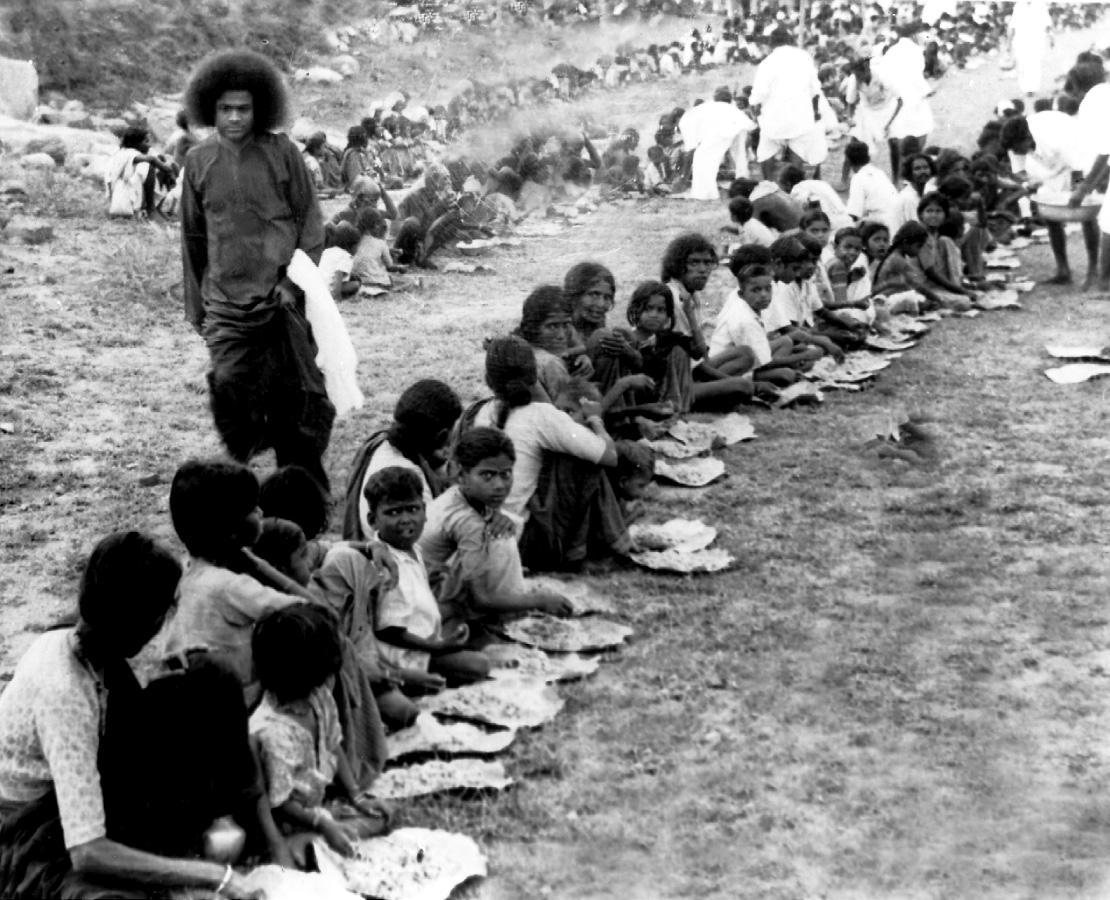
1950
On Baba’s 25th birthday (November 23rd), Prasanthi Nilayam Mandir is inaugurated.
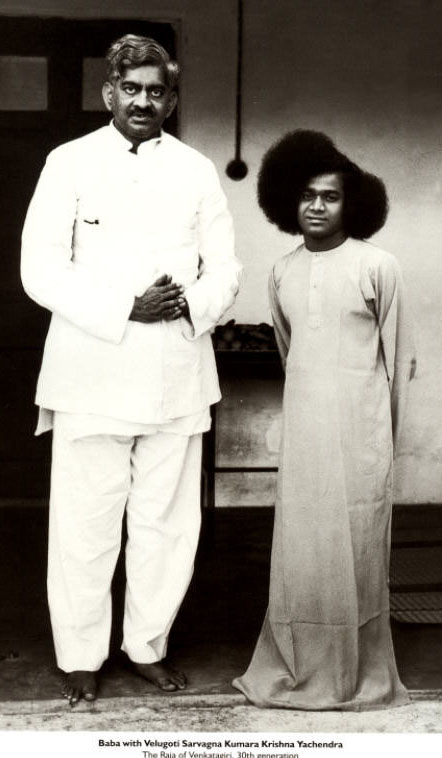
1950
Baba visits the Royal Family at Venkatagiri Palace for the first time.
1951 - 1960
1953
December 29: Maharaja of Travancore has Baba’s Darshan during his visit to Allepey, Kerala on Vaikuntha Ekadashi

1954
November 23: Baba lays the foundation stone of the Sri Sathya Sai General Hospital at Prasanthi Nilayam, making it the first medical care facility in the entire region.
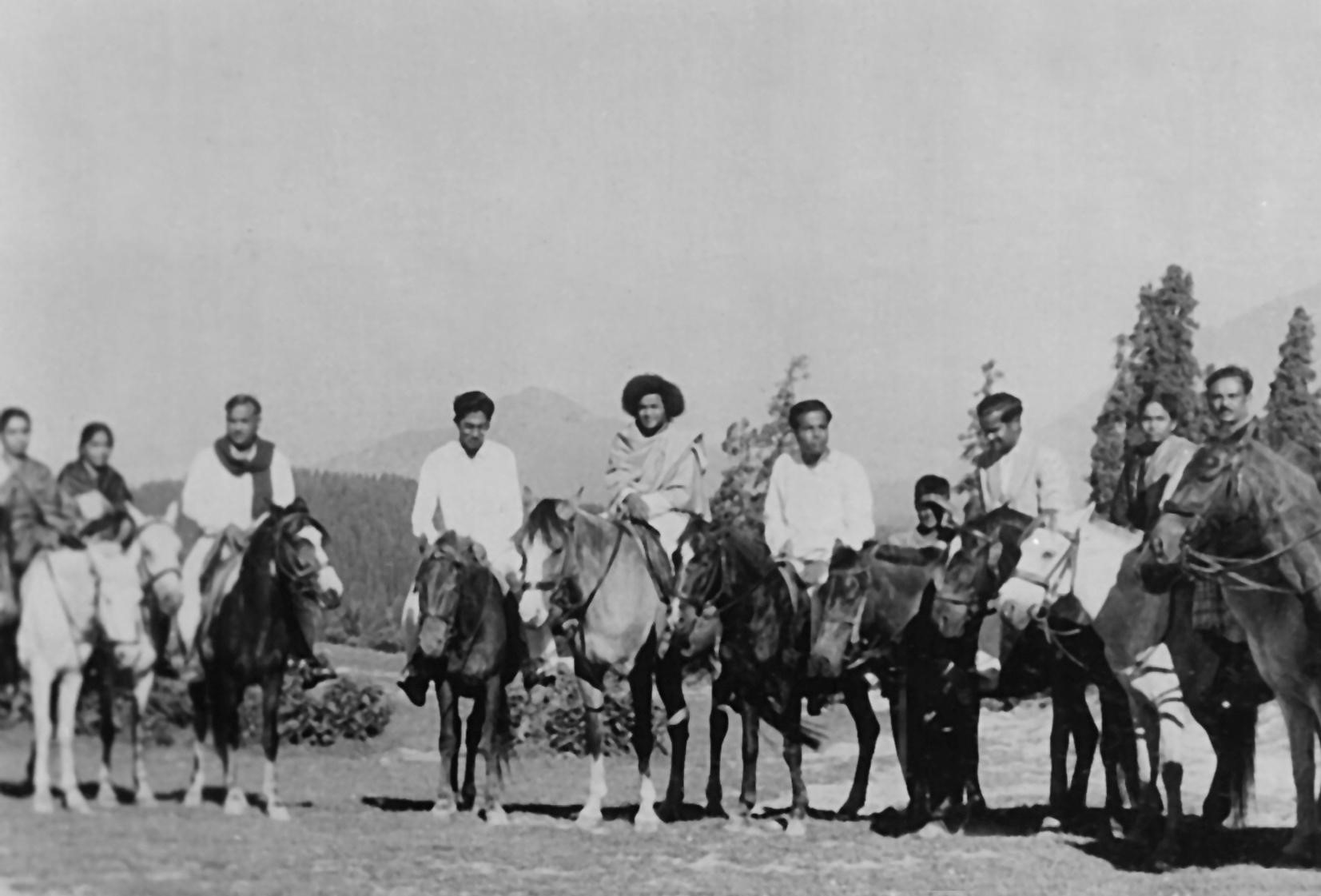
1957
- March 16: Baba presides over the 9thAll India Divine Life Convention at Venkatagiri, Andhra Pradesh which is attended by spiritual leaders from across the country. Thereafter, Baba visited Kodaikanal for the first time.
- July 14 – August 14: Baba stays at the Ashram of Swami Sivananda in Rishikesh and cures him of his ailing health. Baba also meets Swami Purushottamananda at Vasishta Guha. Baba visits Mathura-Brindavan and Kashmir with his entourage
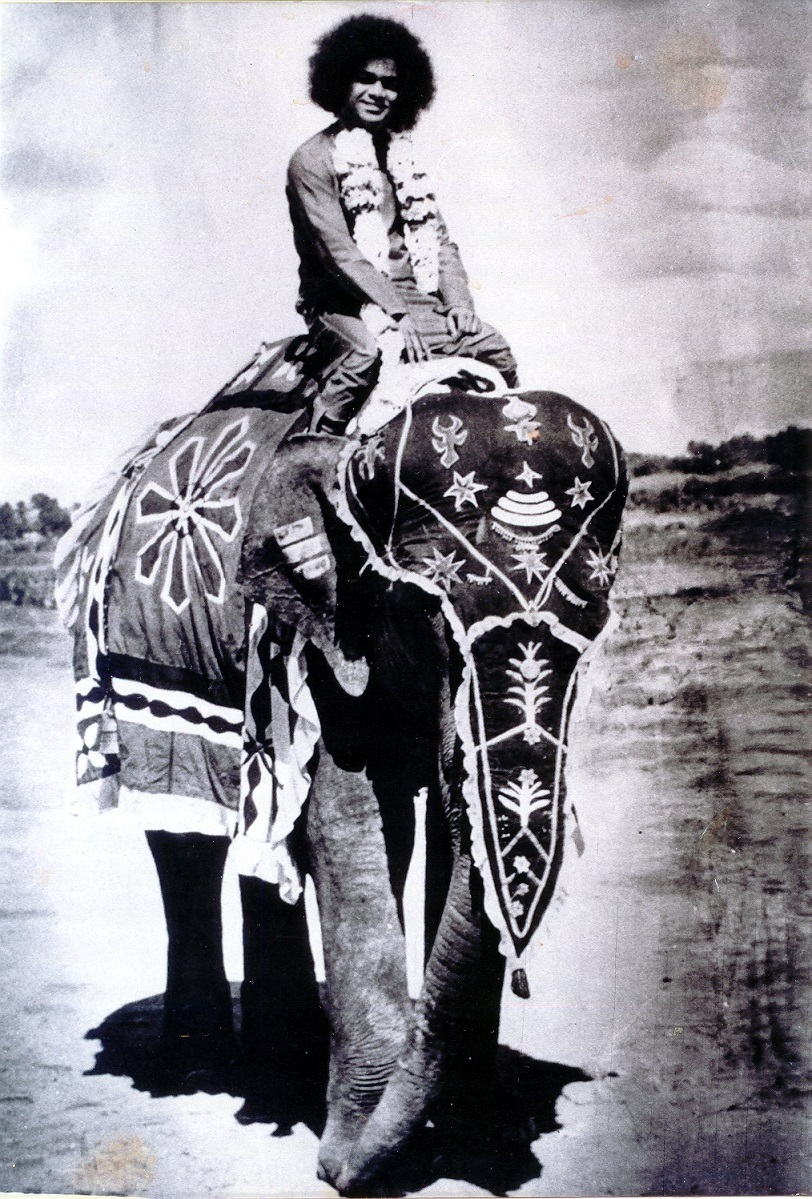
1958
- February 16: Baba commences the publication of the Ashram’s monthly magazine Sanathana Sarathi on Mahashivaratri Day to spread his message of love and service across the country and overseas. Baba himself writes for the magazine every month uninterruptedly for 25 yrs. These articles are later published as the Vahini series.
- July 12: Baba graces the sanctum sanctorum of Lord Sri Venkateshwara Temple at Tirumala, Tirupati

1958
December 14-31: At the request of Governor of Kerala, Baba tours Kerala and visits Kanyakumari
1959
June 29: Baba plants the Meditation Tree behind the Prasanthi Nilayam Mandir
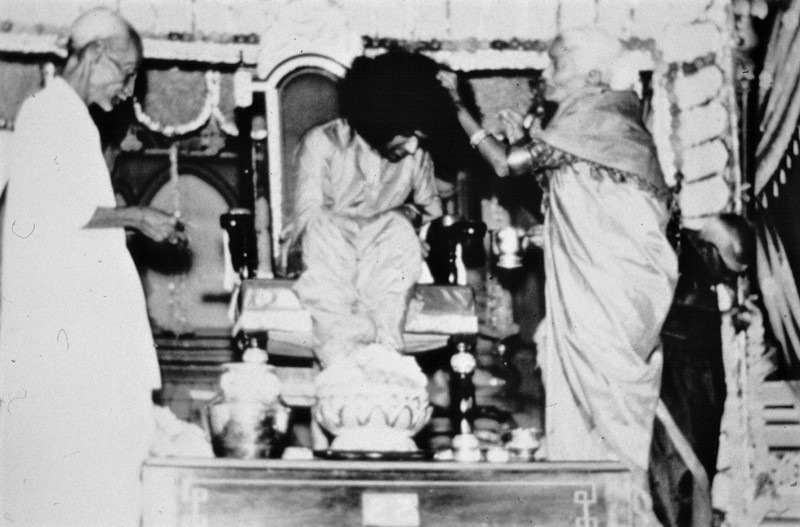
1960
September 30: The first volume of Baba’s biography – Sathyam, Shivam Sundaram, authored by Prof. Kasturi, is brought out.
1961 - 1970
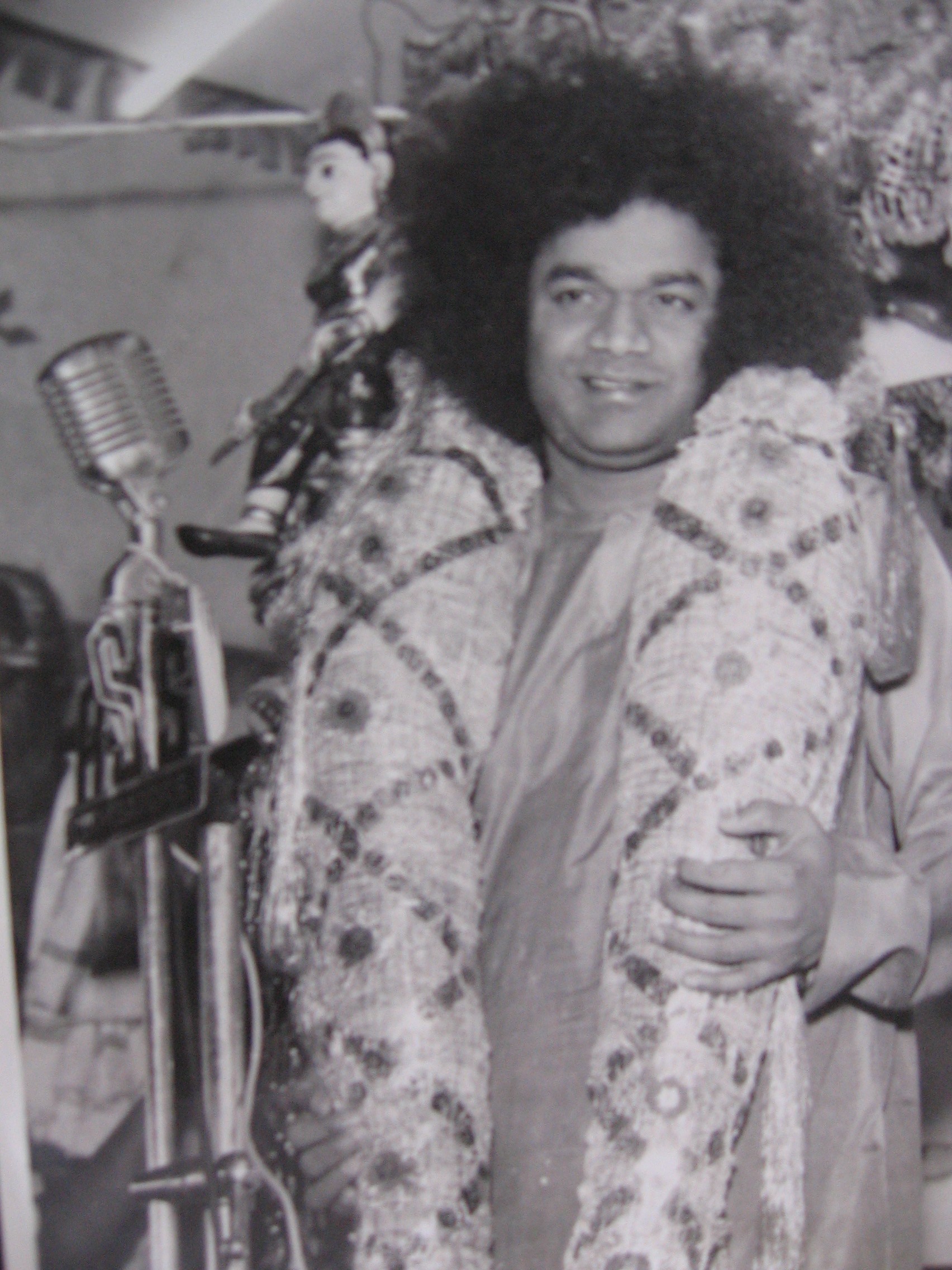


1961
- March 23 – April 8: Baba visits Ayodhya, Prayag, and Kashi. At the Vishwanath Temple, Baba materialises Vibhuti and sandal paste and applies them on the Linga. At Lucknow Raj Bhavan, he is hosted by the Governor of Uttar Pradesh; meets General Thimmayya, Chief of Army Staff
- November 23: The second volume of ‘Sathyam, Shivam, Sundaram’ is released.

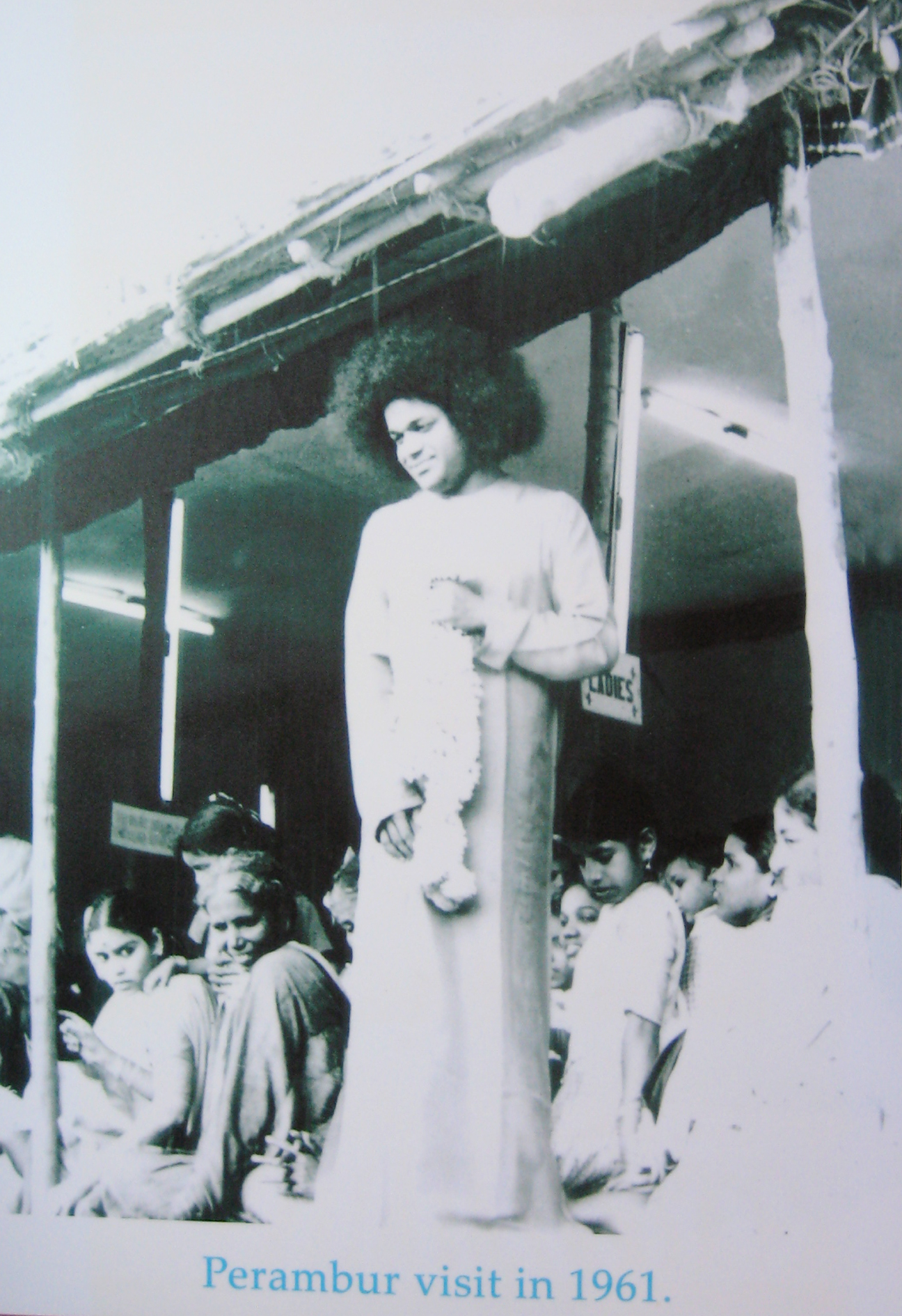
1961
- June 7 – July 4: Along with Dr. B. Ramakrishna Rao, Governor of Uttar Pradesh, Baba visits Badrinath. Enroute to Badrinath, Swami visited Brahmakund, Srinagar and Joshimath. At the Badrinath Temple, Baba materializes the Netralingam that Sri Adi Shankara had procured from Kailash.
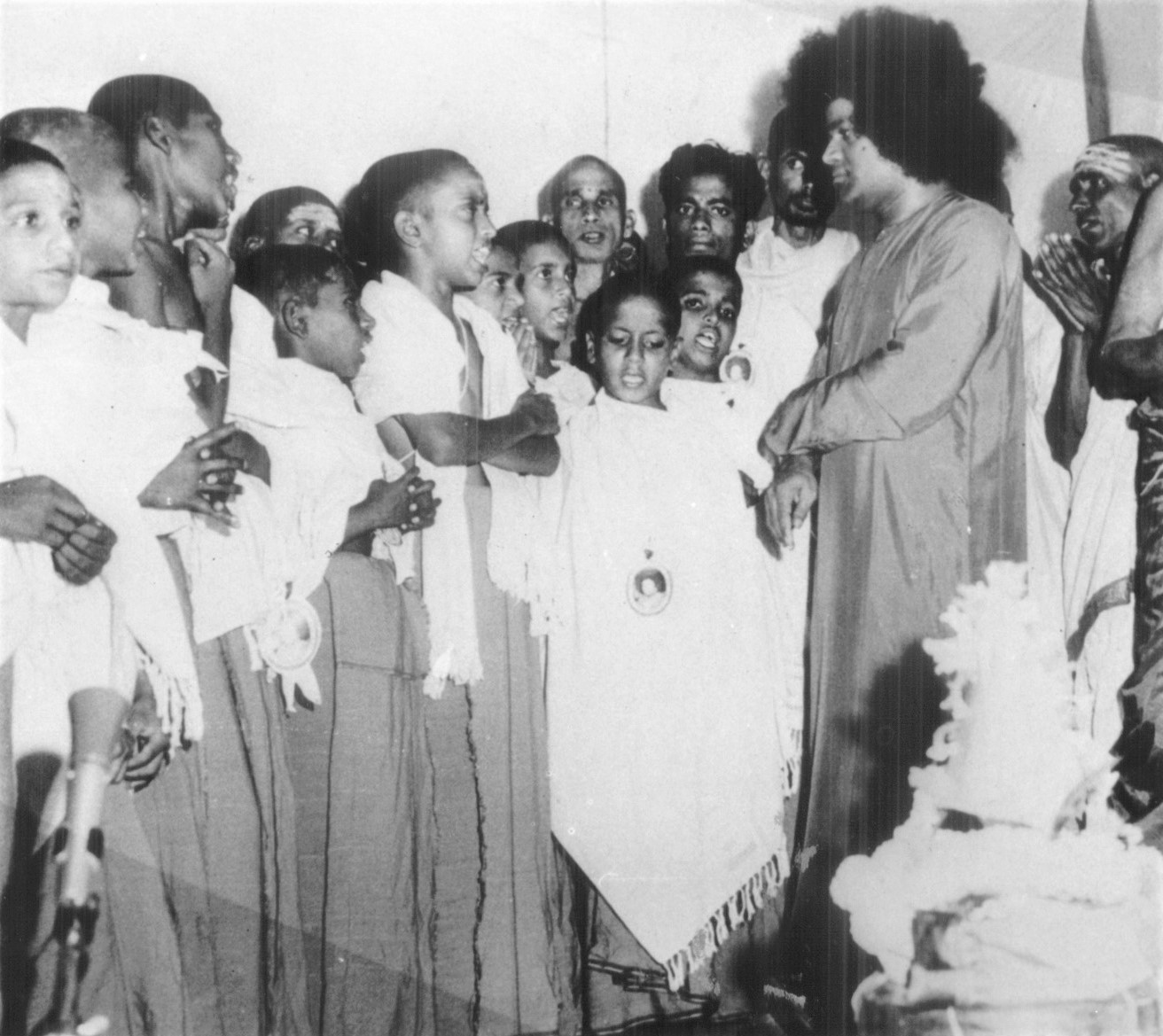
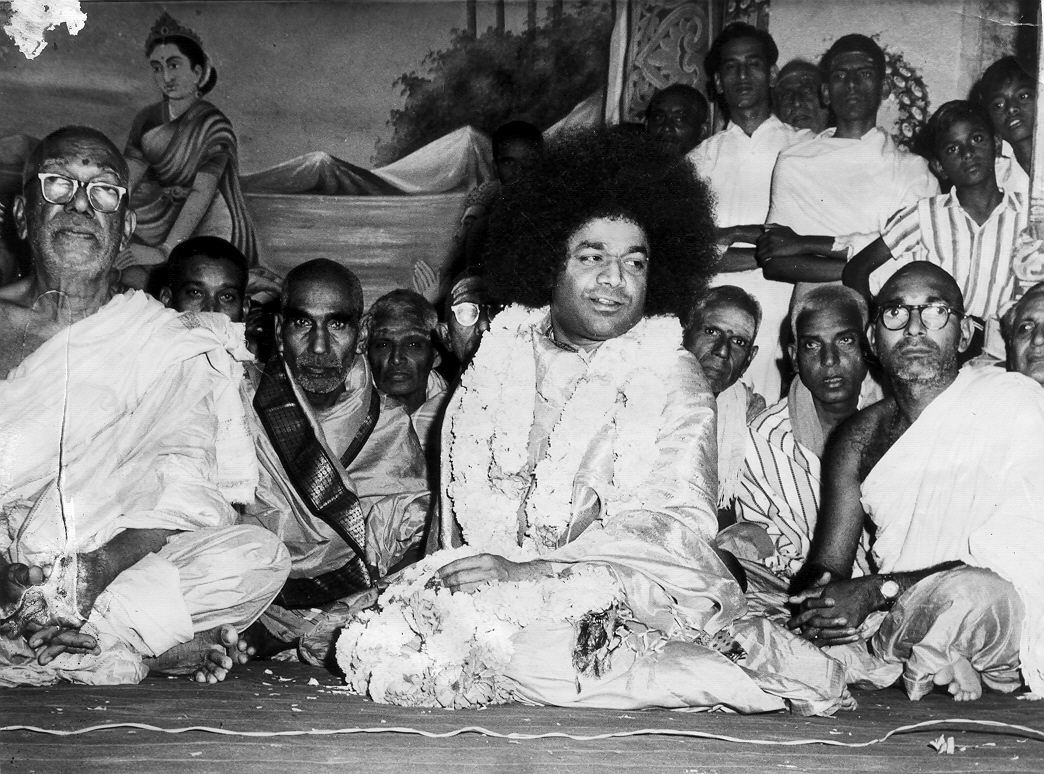
1962
- April 5: Baba inaugurates the Tyagaraja Utsava at Tirupati
- October 1:The first Veda Purusha Jnana Saptaha Yajna is conducted during the Dassera Festival at Prasanthi Nilayam. Vedic scholars from across India discourse on the universality of the Sanatana Dharma as a harmonious way of life.
- November 23: Baba inaugurates the Vedashastra Pathashala at Prasanthi Nilayam
1963
- July 6: Baba cures himself of paralysis and cerebral thrombosis during the Guru Pournima festival and declares that he is the Shiva-Shakti Principle. He also declares for the first time about the triune Avatars of Shirdi Sai, Sathya Sai and Prema Sai.
- November 4: Father Pedda Venkappa Raju concludes his earthly sojourn at Puttaparthi
- December 6: Baba visits the Jyotirlinga of Mallikarjuna at Srisailam
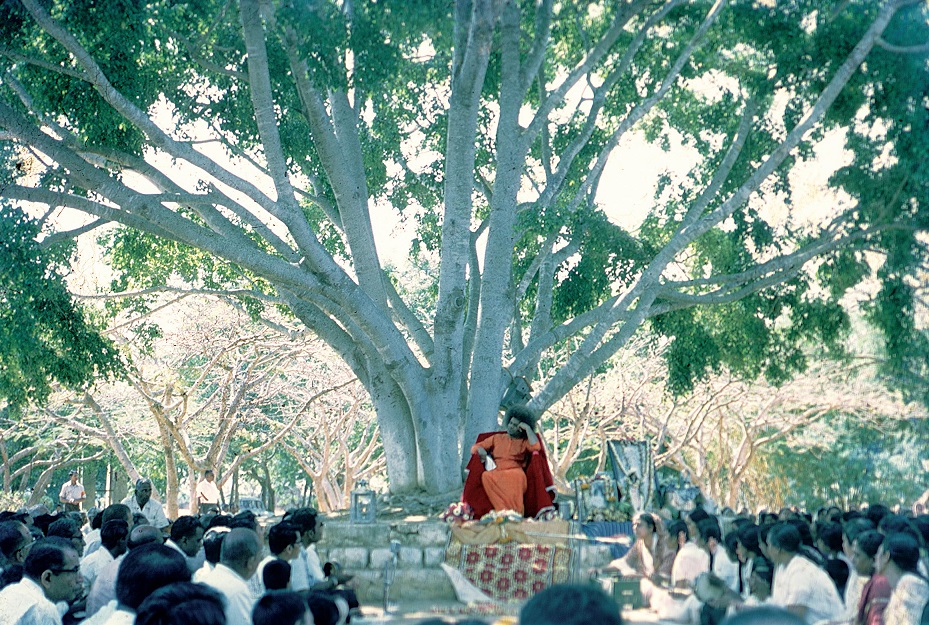
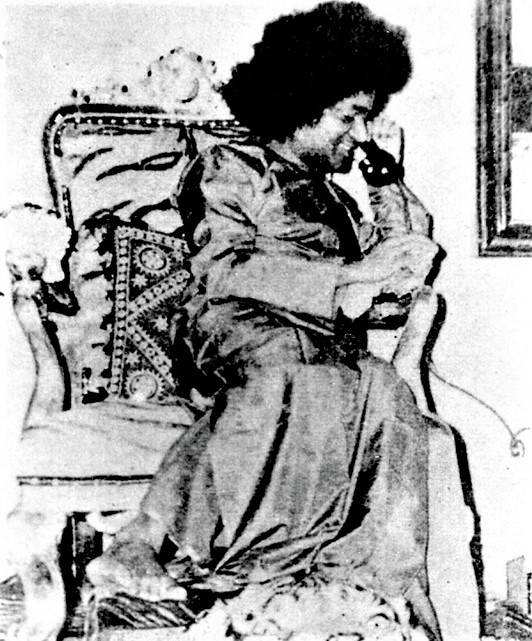
1964
- April 13: Baba inaugurates the Brindavan Ashram at Whitefield, Bangalore
- July 29: Baba inaugurates the first telephone connection at Puttaparthi
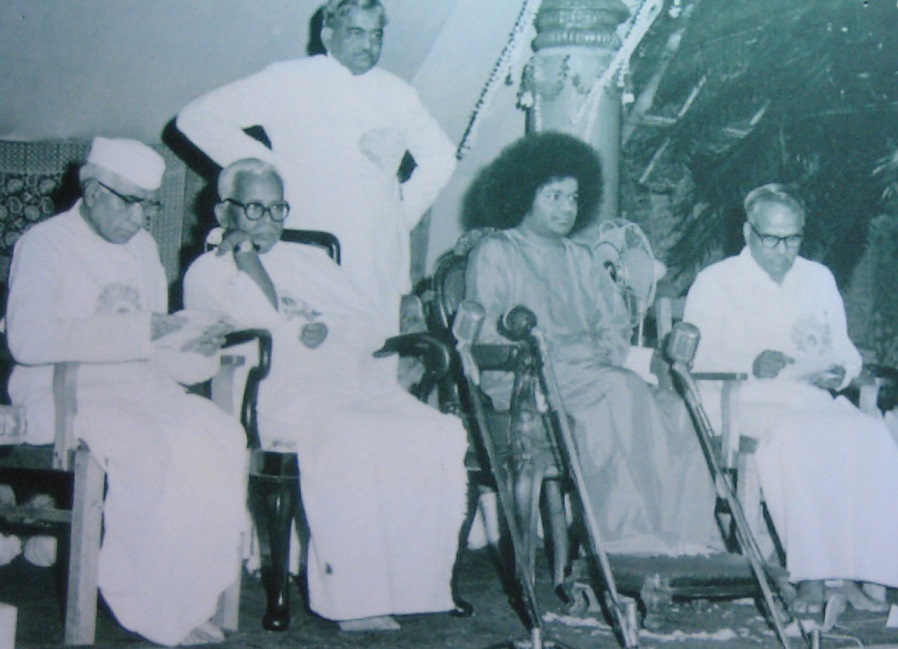
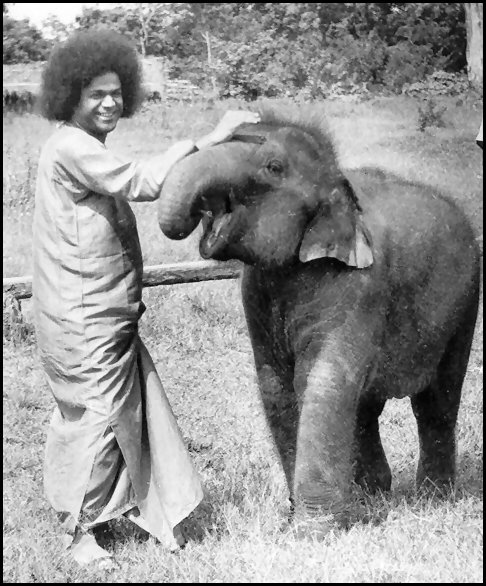

1964
- August 13: Baba inaugurates the Prashanti Vidwan Maha Sabha at Madras in the presence of the Chief Minister and dozens of Vedic scholars
- October 1: Sai Geeta, Baba’s pet elephant brought to Prasanthi Nilayam
1965
- June 7: The Maharashtra Branch of the Akhila Bharata Prashanti Vidwan Maha Sabha inaugurated at Shanmukhananda Auditorium, Bombay
- June 13: Baba visits the Vitthala Temple at Pandharpur
- July 3: The Heads of Palimar Math (Udupi) and of Edaneer (Kerala) visit Prashanti Nilayam
1965
- July 5: The first Sai Centre, ‘Sri Sathya Sai Seva Samiti,’ started in India.
- September: Baba visits the Royal Family of Jamnagar
- October 5: The Governor of Andhra Pradesh Sri Pattom Thanu Pillai inaugurates the Shanti Vedika in Prasanthi Nilayam Mandir


1966
- February 1: A new canteen, ‘Sathya Sai Baba Sahayaka Sangha,’ began functioning at Prasanthi Nilayam. The Sathya Sai Trust is also formed.
- July 14: Baba inaugurated the Prasanthi Nilayam branch of the State Bank of India
- August 4: Prasanthi Nilayam is declared an administrative unit called ‘Prashanti Nilayam Township’




1967
- March 16 – April 4: Baba visits Bombay, Jamnagar, Bhavnagar, Rajkot, Navsari, Surat, and Vadodara.



1967
- April 20-21: The 1stAll India Conference of office bearers of all organisations bearing Baba’s name is held at Madras in Baba’s presence. (The Seva Dal Organisation began functioning as an organised unit thereafter. Until then, Baba used to select devotees who could do volunteer Seva during celebrations at Prashanti Nilayam.)

1968
- May 12: Baba Inspecting Dharmakshetra, the Sai headquarters at Andheri, Bombay on the occasion of Buddha Poornima.
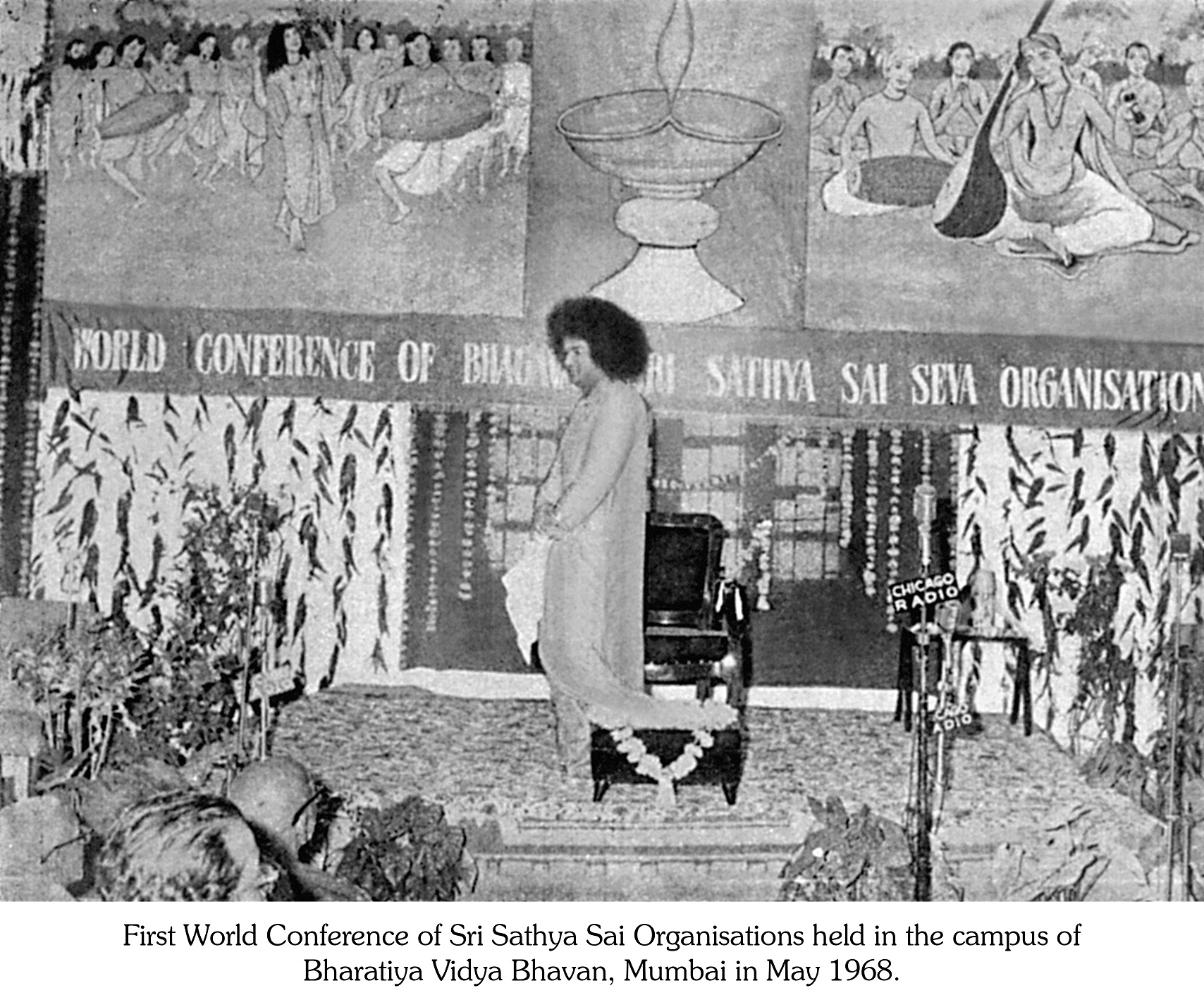
1968
- May 16-19: The First World Conference of Sri Sathya Sai Seva Organisations is organized at the Bharatiya Vidya Bhavan Campus in Bombay. The event is attended by Dr. K.M. Munshi, founder of Bharatiya Vidya Bhavanand Sri Morarji Desai, Deputy Prime Minister of India. Devotees from Ceylon, Singapore, Philippines, Kuwait, Dubai, Casablanca, Mombasa, Nairobi, Kampala, Hong Kong, Fiji, Tehran, Tokyo, West Indies, Peru, Brazil and the Pacific and Atlantic coasts of America attend.



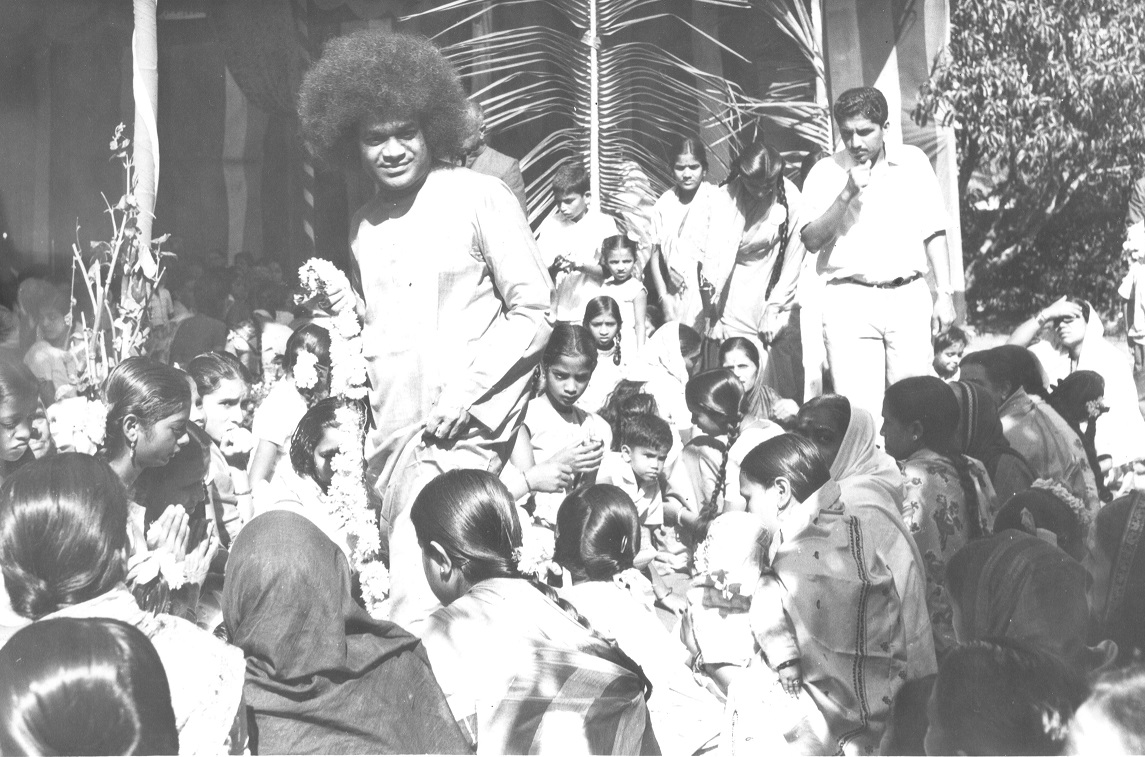
1968
- June 30 – July 15: Baba goes on his first and only international tour to the East African countries of Uganda, Kenya and Tanzania. Chief of Uganda Army Idi Amin visits Baba.
- July 22:Sri Sathya Sai Arts and Science College for Women is inaugurated at Anantapur.
- October 20 – 28: Baba visits Uttara Kannada and Goa; calls it ‘Amarapuriya Ananda Yatra’.
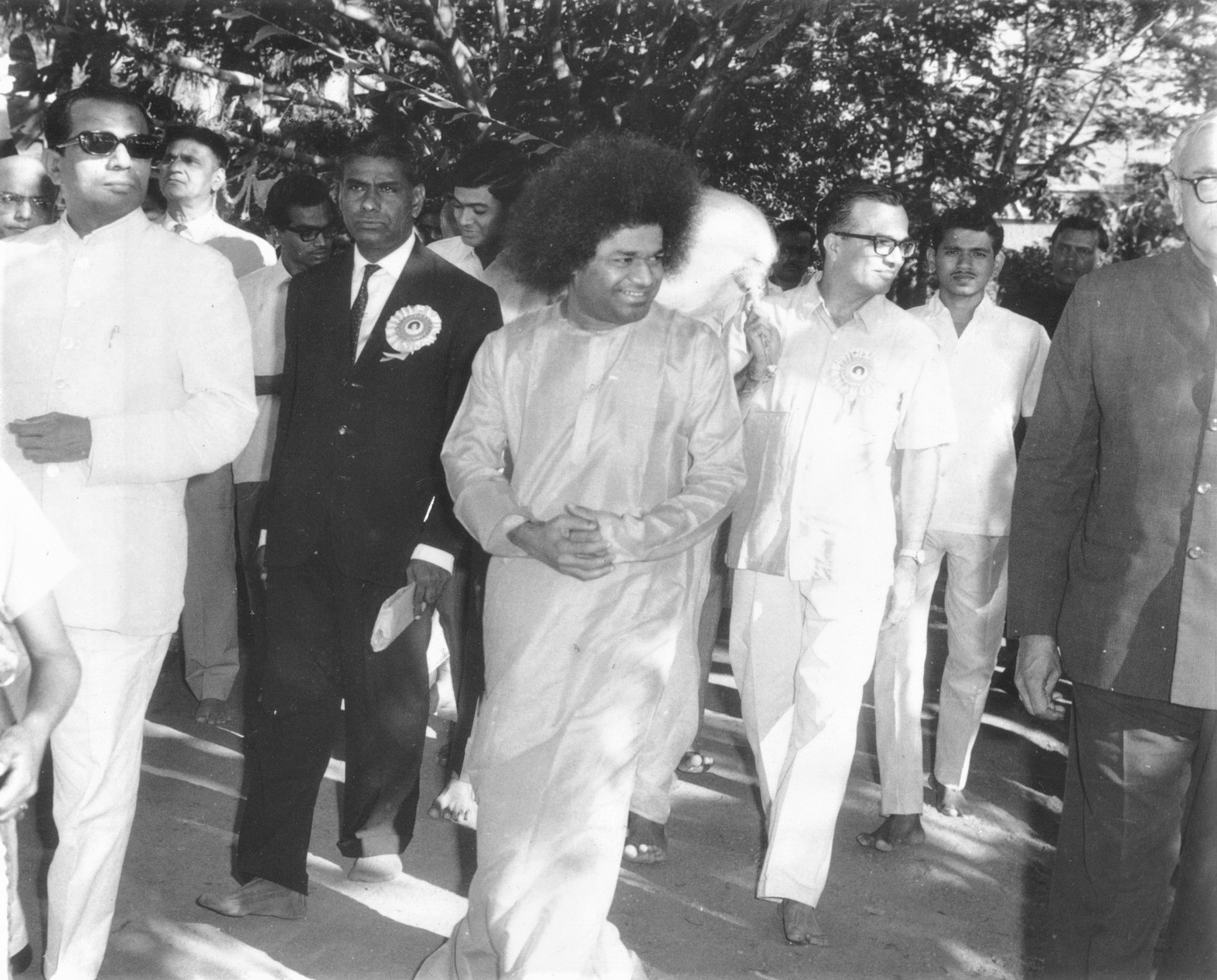

1969
- May 16: Baba visits Ahmedabad. Chief Justice, Governor, and Chief Minister receive private audience with Swami.
- June 9: Sri Sathya Sai Arts and Science College for Men starts at Brindavan, Whitefield, Bangalore. Veerandra Patil, Chief Minister of Karnataka is the Chief Guest for the function.
1970
- March 6-7: On the occasion of the Mahashivaratri festival, Baba draws the figure with holy symbols of five major religions of the World [Hinduism (Sanatana Dharma), Islam, Christianity, Buddhism and Zoroastrianism] with the Lotus Pillar in the centre. This drawing becomes the ‘Sarva Dharma’ emblem of the Sathya Sai Mission

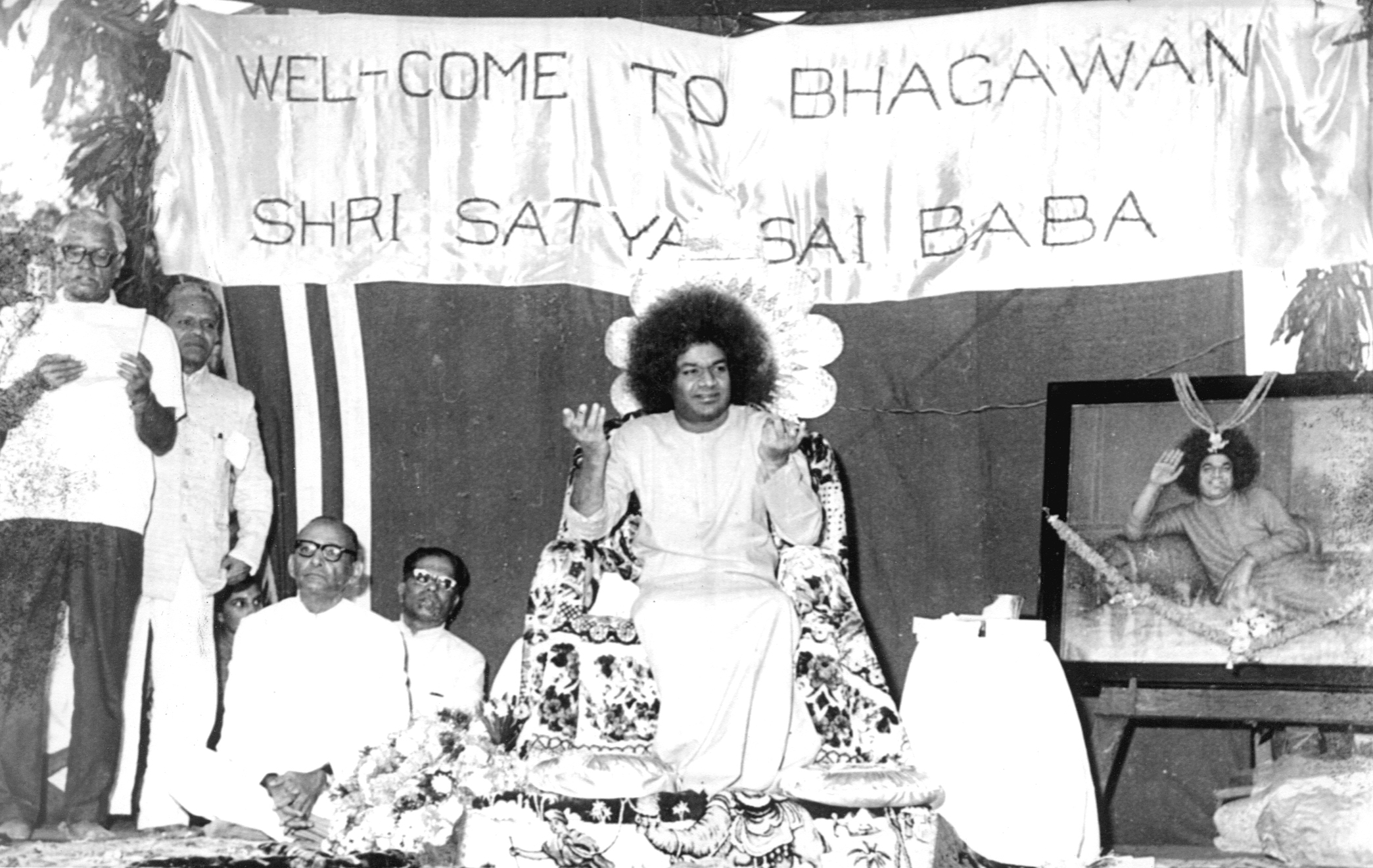
1970
- May 15-16: Baba visits the Krishna Temple at Dwaraka and the Somnath Jyotirlinga. He inaugurates the ‘Digvijaya Dwar’ at the entrance of the Somnath Temple.
- December 6-21: Baba cures himself of a burst appendix at the residence of Sri Nakul Sen, the Lieutenant Governor of Goa at the Raj Bhavan.
1971 - 1980
1971
- July 8: President of India, Sri V.V. Giri inaugurates the new complex of Sri Sathya Sai Women’s College at Anantapur.
1972
- March 25 – April 2: Baba visits Delhi. Prime Minister of India Smt. Indira Gandhi, Vice President of India, Sri G. S. Pathak, General Manekshaw, Chief of the Army Staff and Air Marshal Lal, Chief Justice of India, Sri S. N. Sikri and dozens of dignitaries have a private audience with him.

1972
- May 1 – 31: The first Summer Course in Indian Culture and Spirituality is conducted by Baba at the Whitefield College for a month. Over 1,000 college students from across India attend. These continue every year till 1979 and then again from 1990 till 2002.
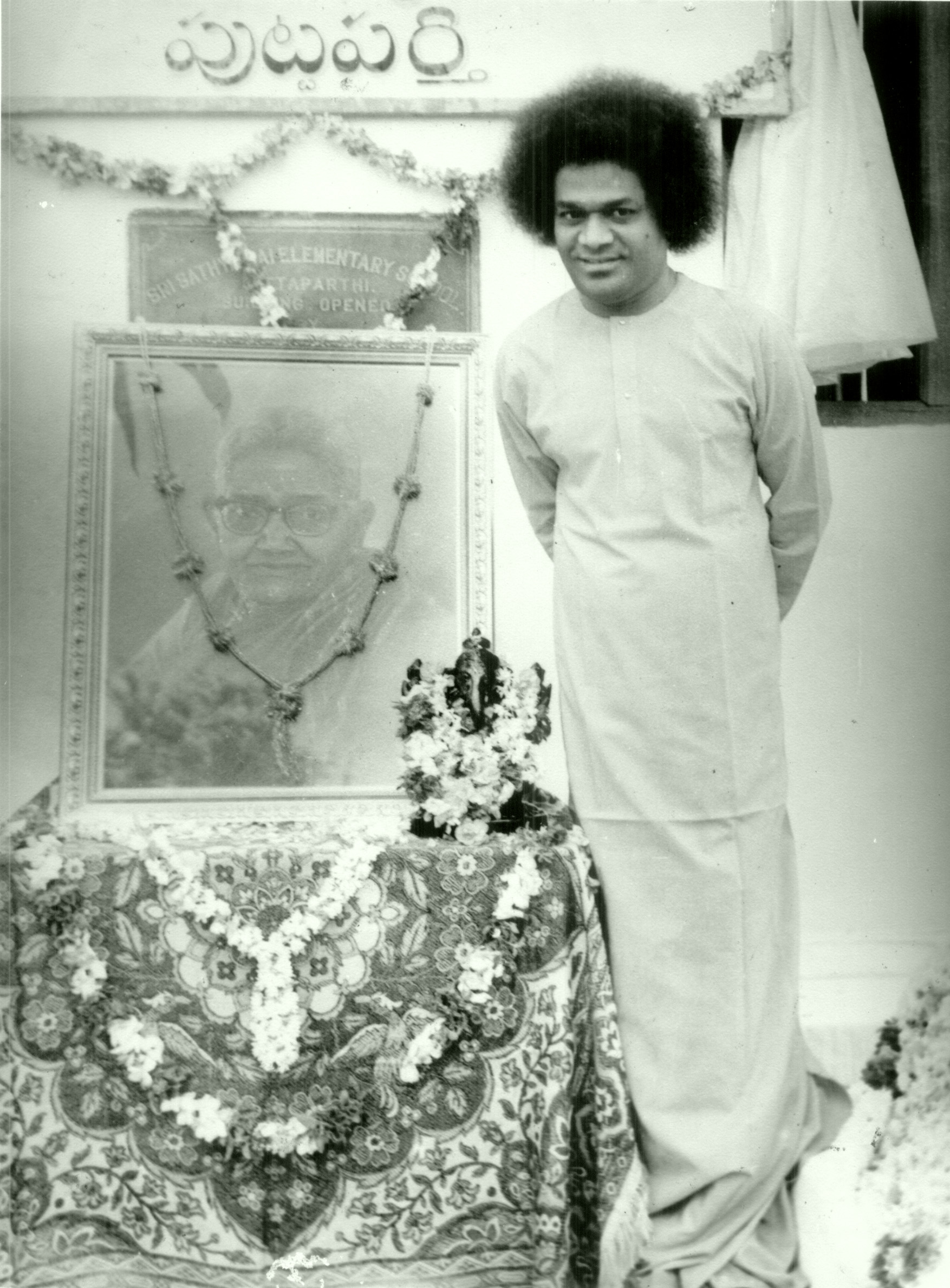
1972
- May 6: Mother Easwaramma culminates her earthly sojourn at Brindavan.
- July 20: The Easwaramma High School is inaugurated in Puttaparthi is memory of Smt. Easwaramma
- September:Sri Sathya Sai Central Trust established for charitable social welfare projects.
- October 17: Baba inaugurates the Poornachandra Auditorium at Prasanthi Nilayam


1973
- March 14 – April 3: Baba visits Delhi, Amritsar, Shimla, Jaipur, Bombay, Pune, Rajkot, and Jamnagar.
- April 4: Baba inaugurates Sivam, his residence in Hyderabad
- December 24: Sri Gandikota V. Subramanyam Shastry recites the Sai Gayatri composed for the first time in the Divine Presence at Brindavan.

1973
- May 7: Baba graces the Inaugural Function of the Second National Gita Jnana Yajna at Bangalore along with Swami Chinmayananda
- May 30: Baba visits Dakshina Kannada
- September 9: The first Onam Celebrations by devotees from Kerala at Prasanthi Nilayam
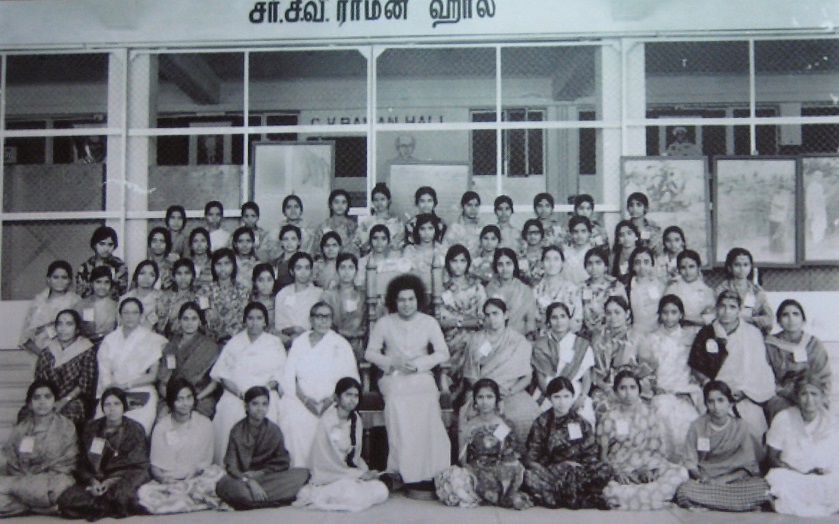
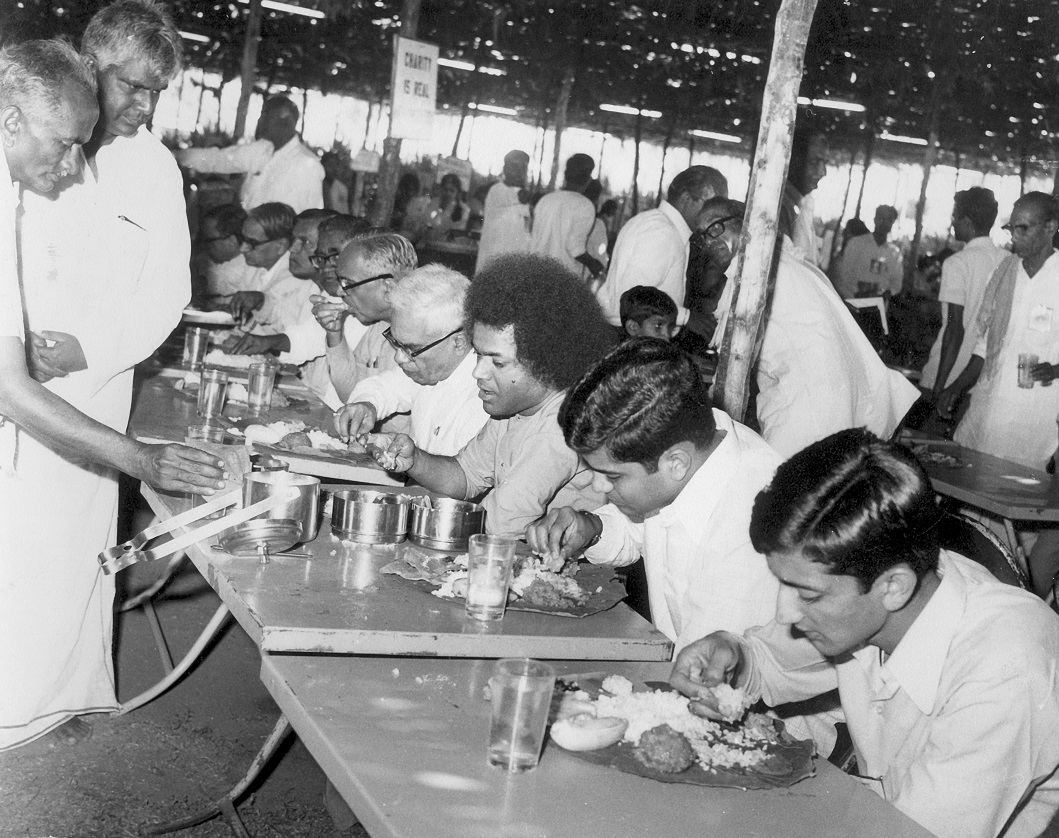


1974
- November 20: Baba blesses the Silver Jubilee of the Akhanda Bhajans organised by Dr. R. S. Padmanabhan’s family at the Golden Jubilee Hall in Bangalore. He declares that, in future, the entire world would conduct it on the same day and at the same time (Global Akhanda Bhajan).
- December 30: Baba visits the Winter Course conducted at Coimbatore by SSSSO and spends the last week of the year in Ooty.
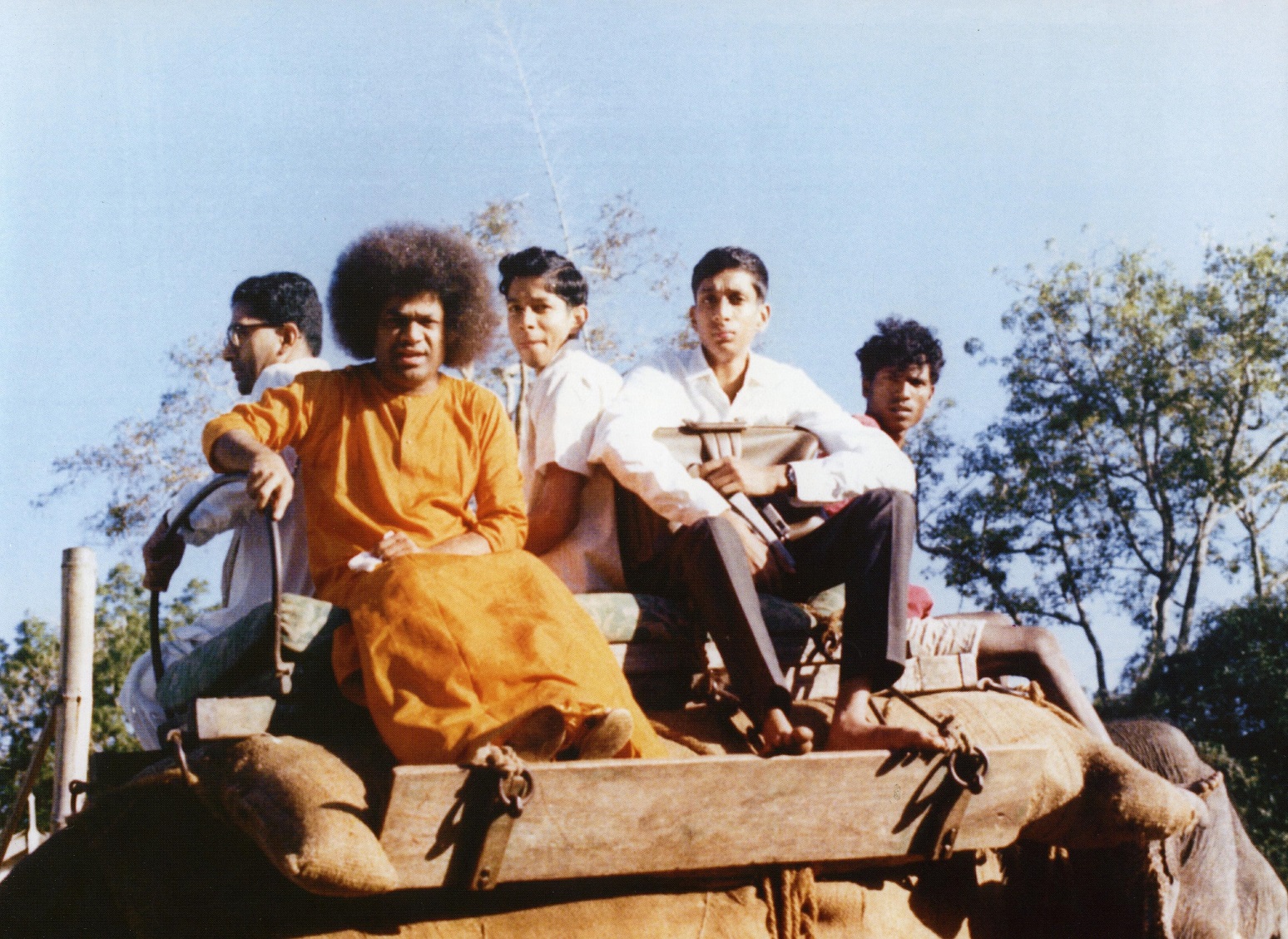
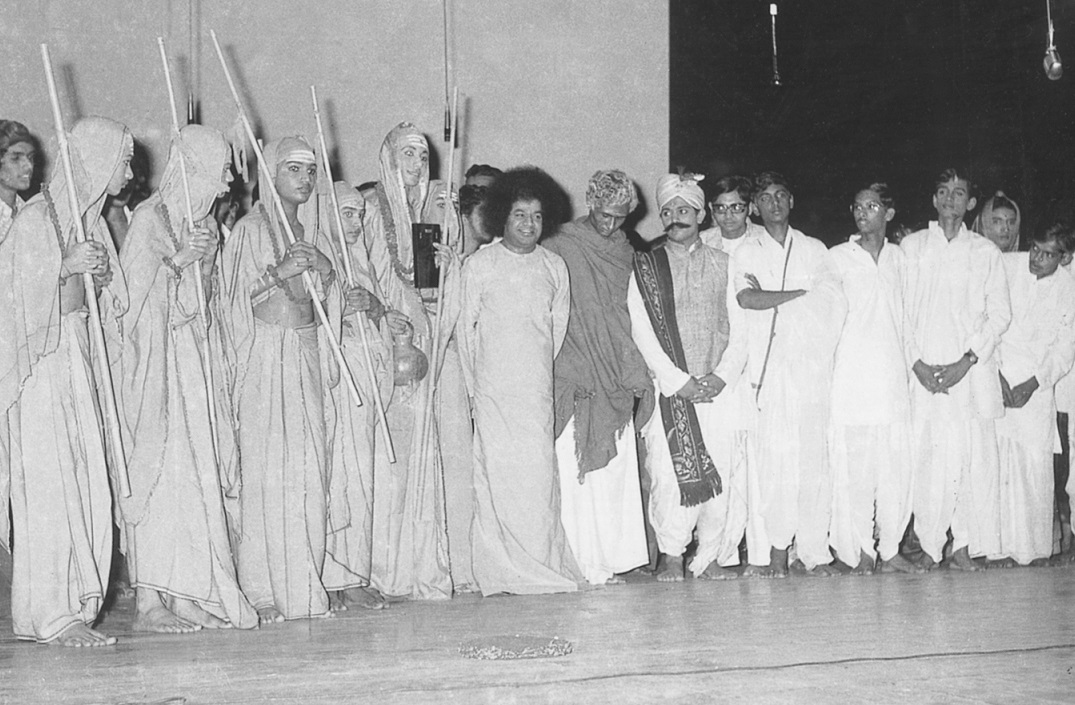
1975
- March 17: Baba visits the Abhayaranya Sanctuary, Kerala
- May 11: Baba inaugurates the first Sarva Dharma Stupa at Dharmakshetra. Students of Sri Sathya Sai Arts and Science College, Brindavan, enact a play entitled ‘Bhaja Govindam’ at Shanmukhananda Hall.
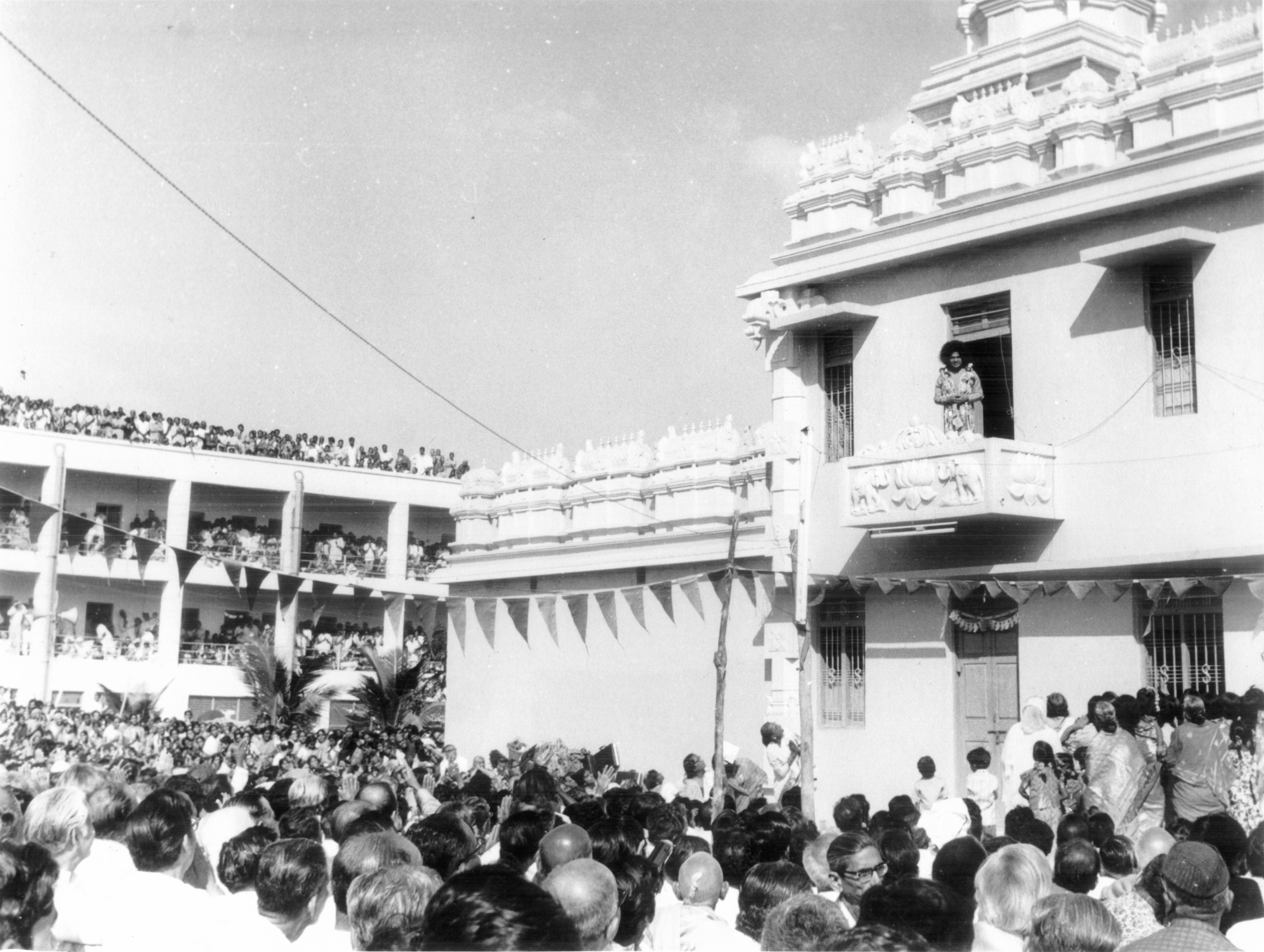
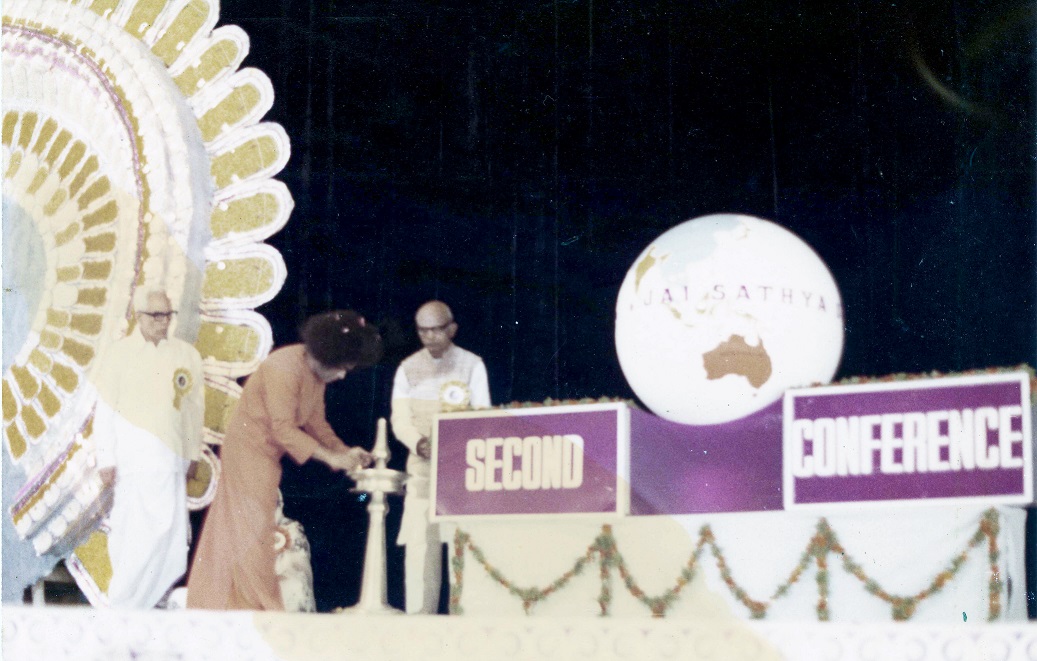

1975
- August 29: The Sathya Sai Gokulam at Puttaparthi at Puttaparthi
- November 23: Baba inaugurates the Sarva Dharma Stupa in Prasanthi Nilayam – symbolising the unity of world religions, on his 50th Birthday.
- The 2nd World Conference of Sri Sathya Sai Organisations is organised at Prasanthi Nilayam.
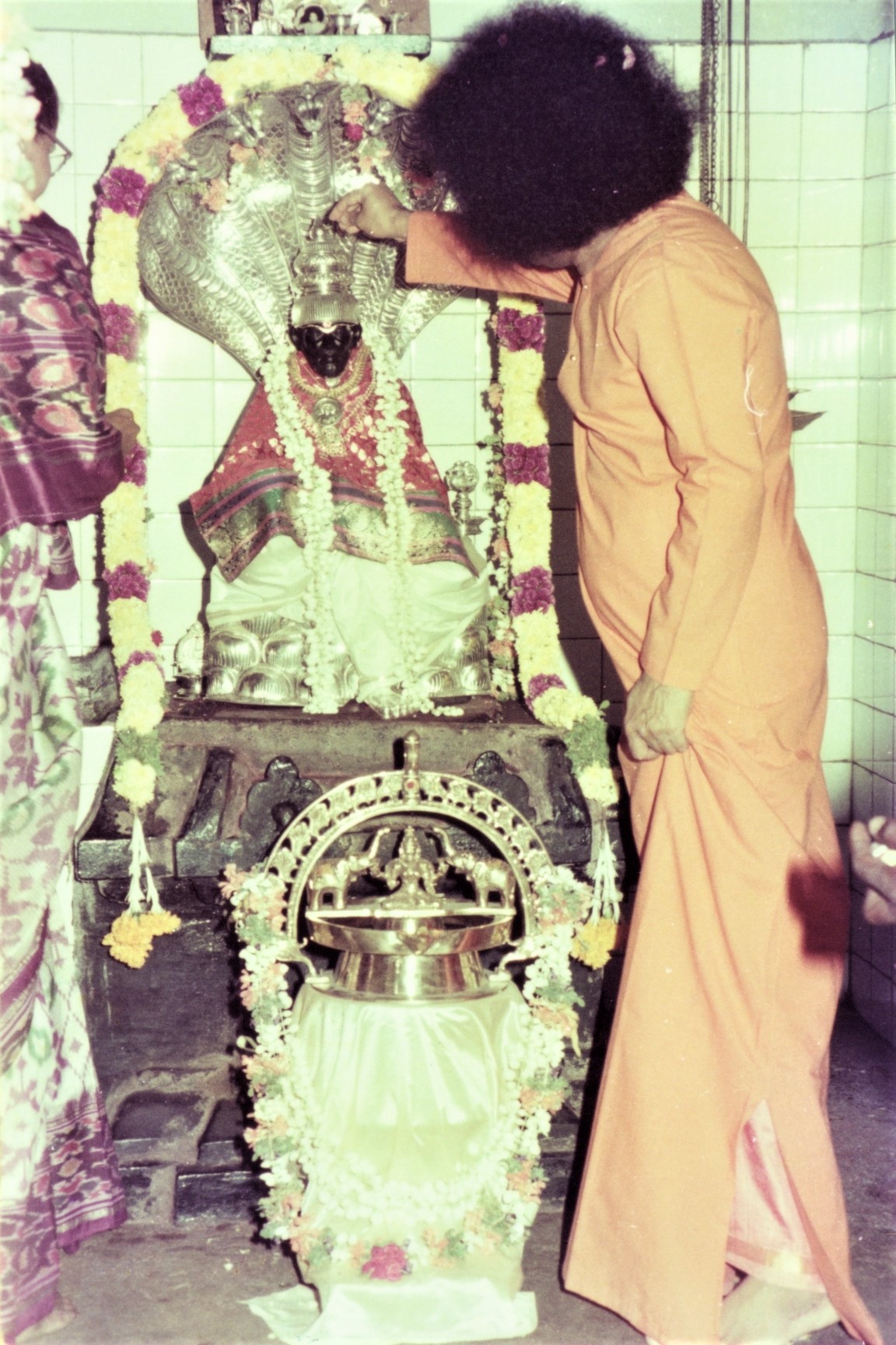
1976
- May 20 – June 9: The first and only Summer Course in Indian Culture and Spirituality conducted at Baba’s residence, Nandanavanam, at Ooty. On that occasion, Baba also materialised a medallion with a map of India in which the future years of Swami’s earthly sojourn and events and achievements of the Sai Mission were engraved in Sanskrit verses.
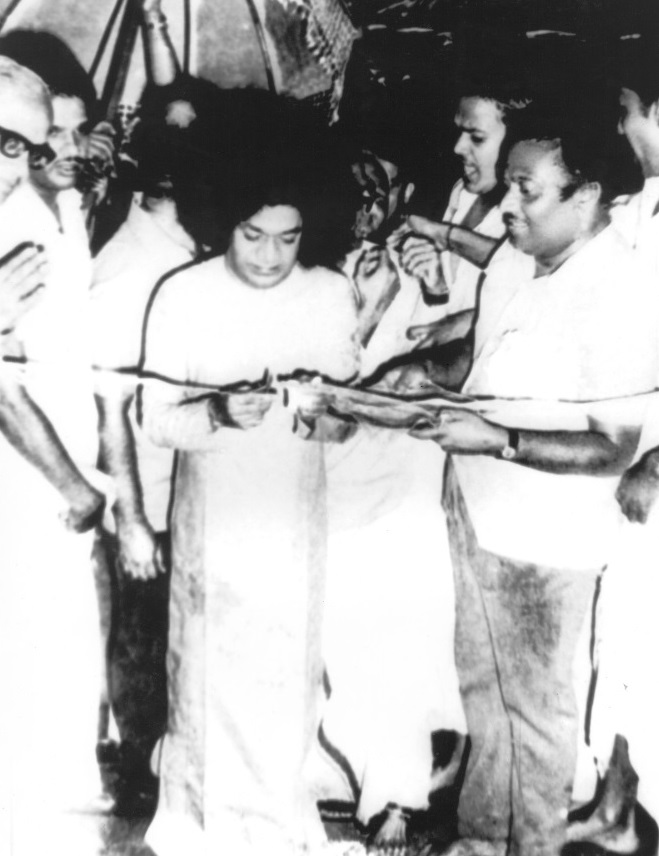
1976
- May 23: Baba laid the foundation stone for Sri Sathya Sai School at Srisailam, Kerala
- August 28: Baba inaugurates the Sri Sathya Sai General Hospital for women and children at Whitefield, Bangalore
- November 13: The first ever 24-hour Akhanda Bhajan held at Prasanthi Nilayam.
1977
- April 28: President of India, Sri B.D.Jatti inaugurated The Walter Cowan Block of Sri Sathya Sai Hostel, Brindavan
- May 6: The first Easwaramma Day Celebrations commence as Children’s Day across Sathya Sai Seva Organisations
- December 24: Sri Gandikota V. Subramanyam Shastry recites the Sai Gayatri composed for the first time in the Divine Presence at Brindavan.
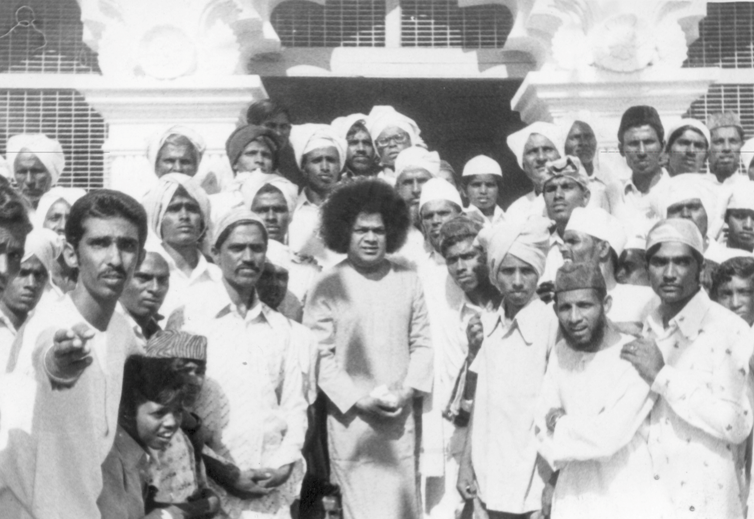
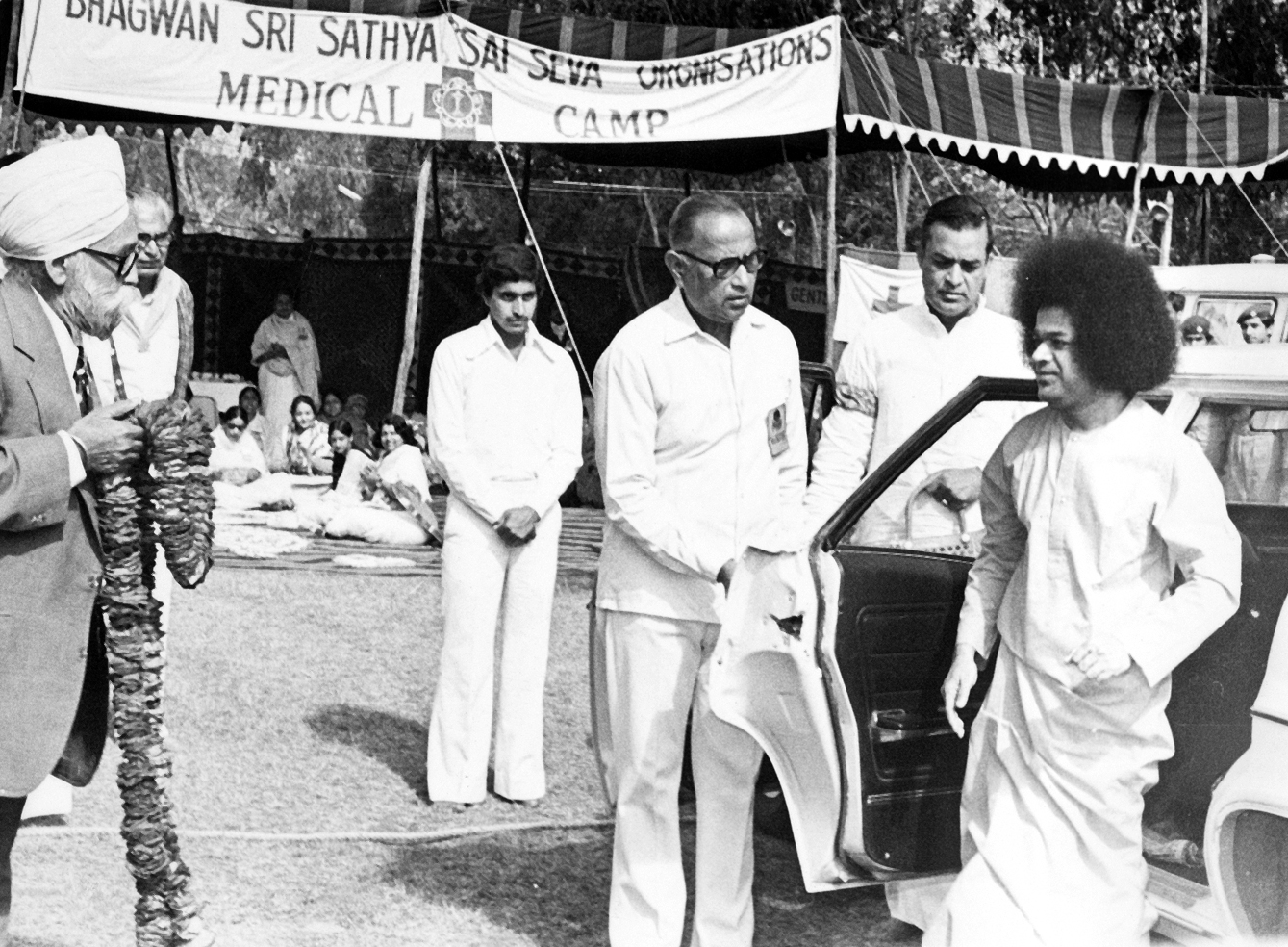
1978
- August: Baba inaugurates a mosque built for the Muslims of Puttaparthi on Ramzan Day.
1979
- March 29: Baba addresses the police officers at the National Police Academy, Hyderabad
- July 1: Sri Sathya Sai College of Arts, Science and Commerce for men established in Puttaparthi
- November 23: Baba consecrates the Shiva Temple at his birthplace in Puttaparthi with marble idols of Shiva and Nandi
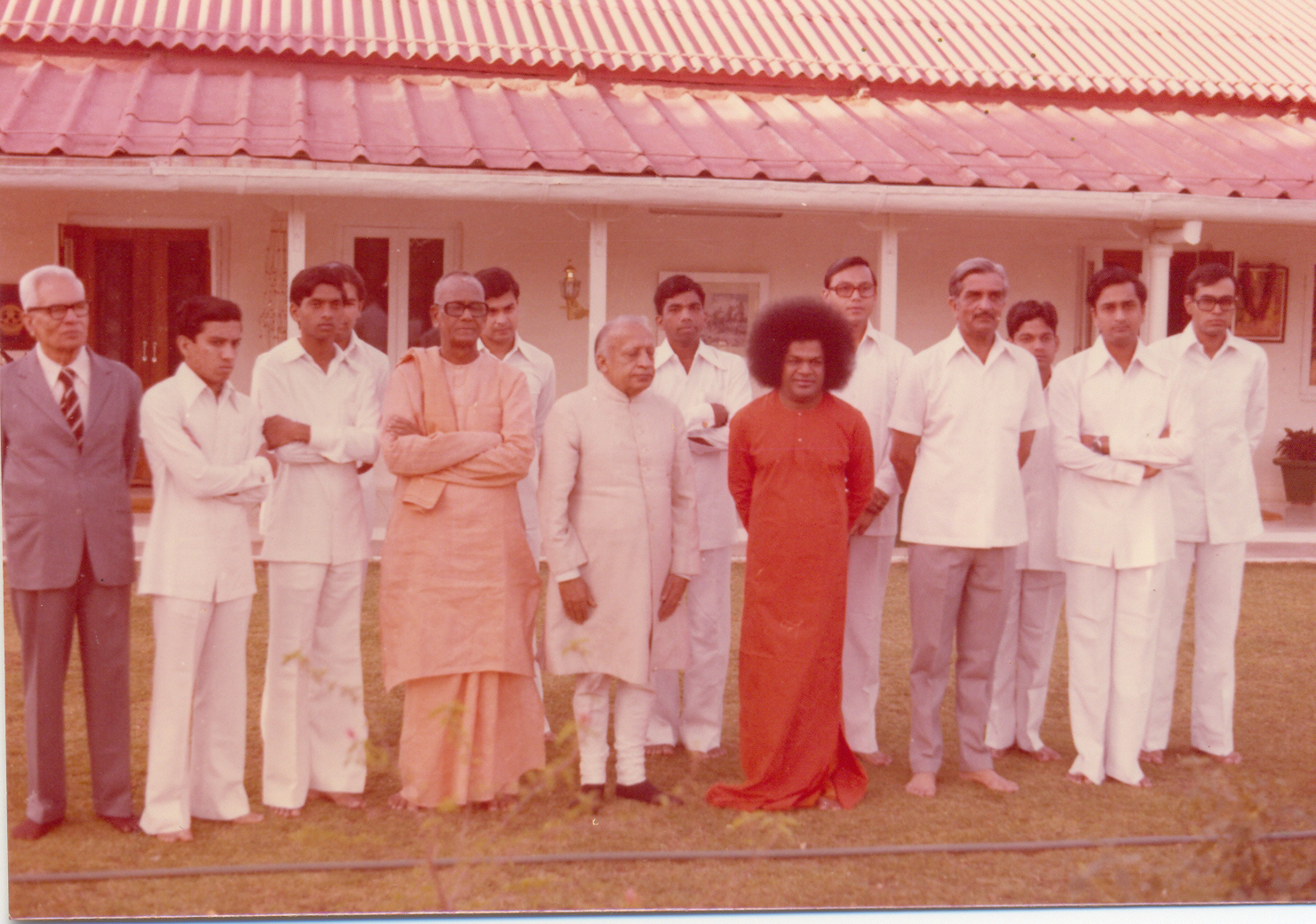
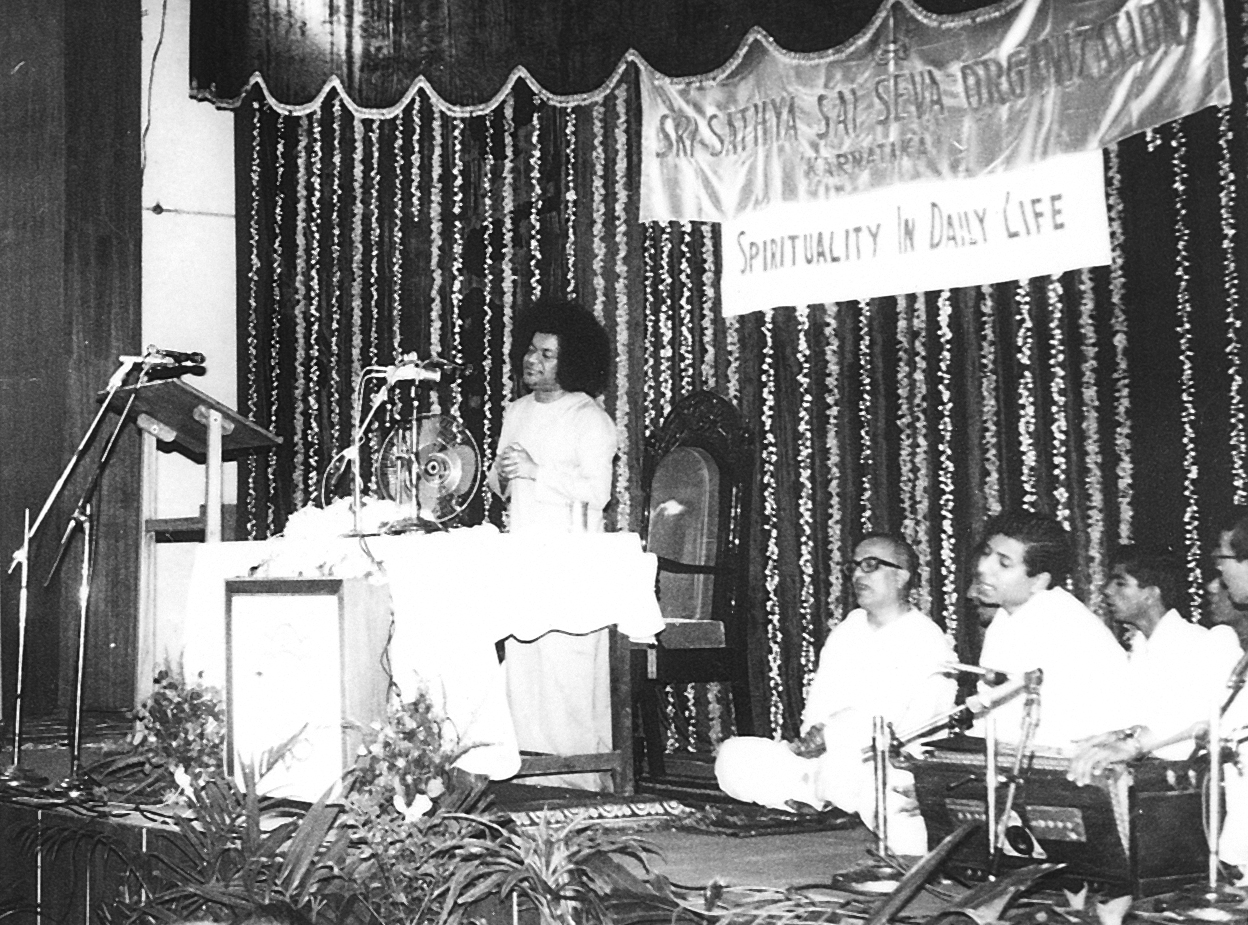
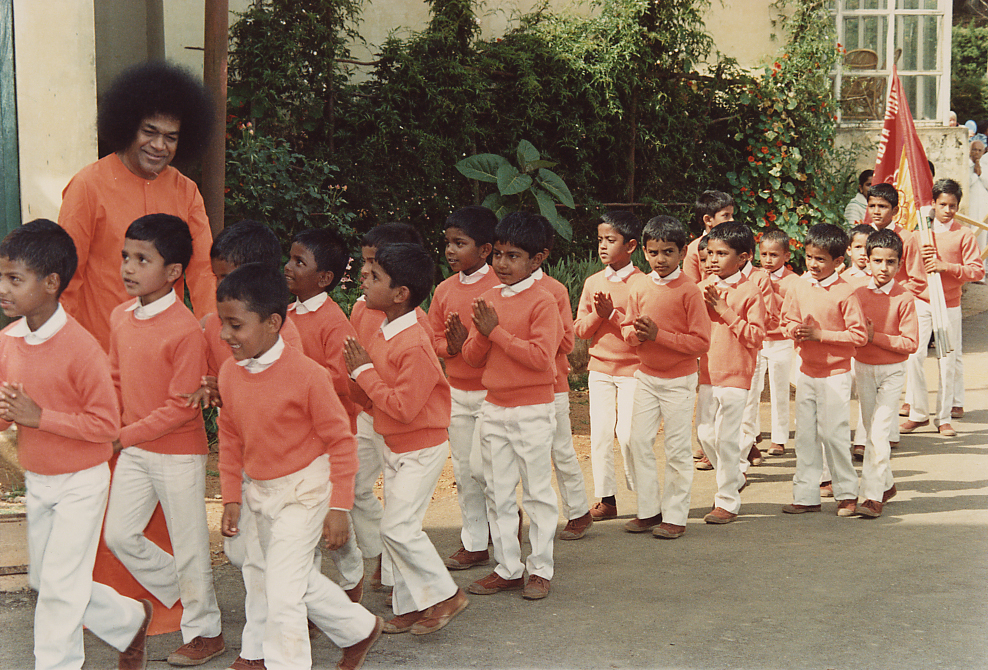
1980
- June 1 – 17: Baba visits Kashmir along with his students; meets Governor Jha and Chief Minister Sheikh Abdullah.
- November 1: The Government of Andhra Pradesh forms a new Administrative Division named Sri Sathya Sai Taluka
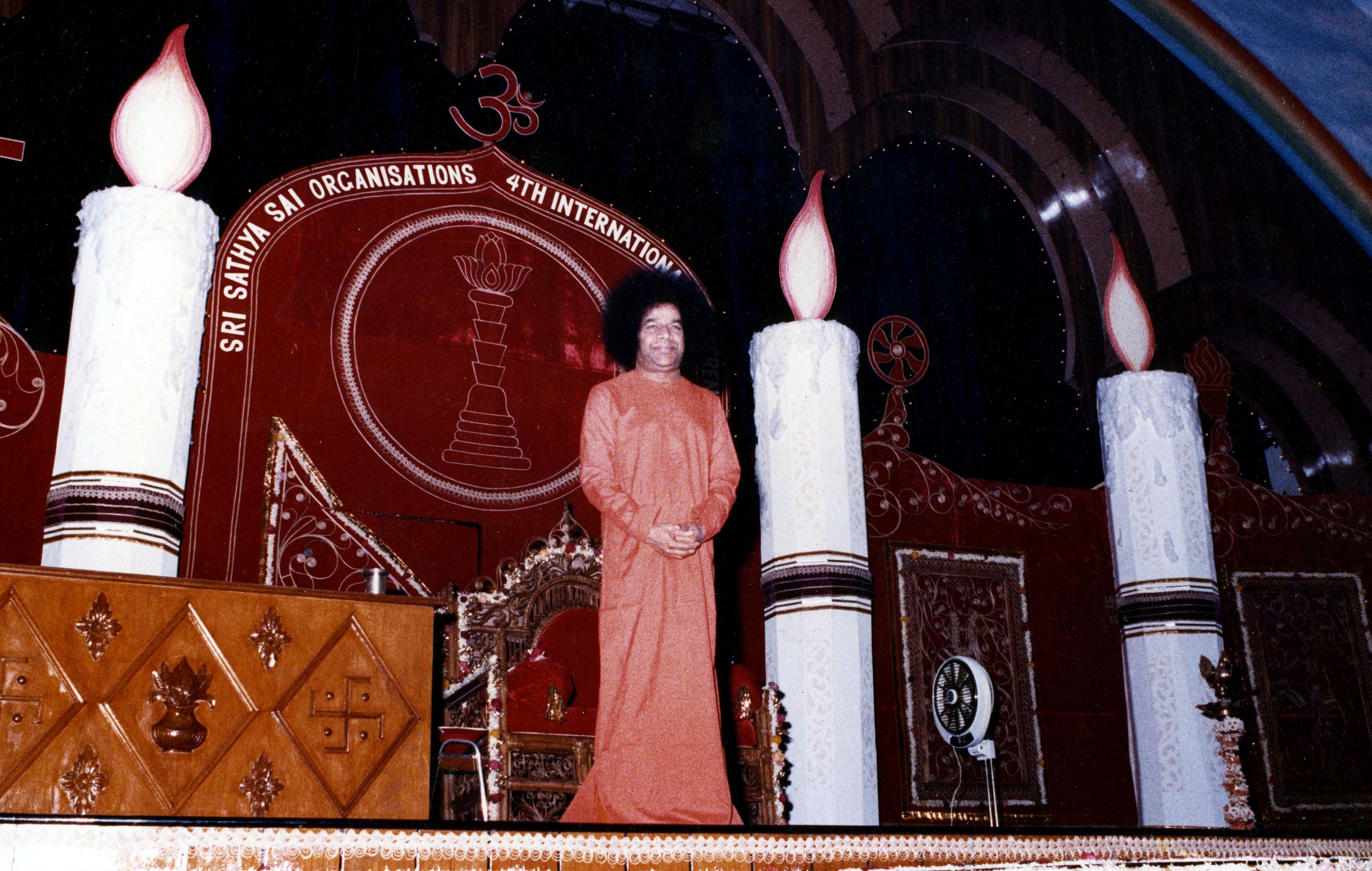

1980
- November 19-25: The 3rd World Conference of Sri Sathya Sai Organisations held at Prashanti Nilayam on the occasion of the 55thBirthday Celebrations
- December 3: Baba adds the symbol of Judaism in the international emblem of Sri Sathya Sai Organisations
1981 - 1990
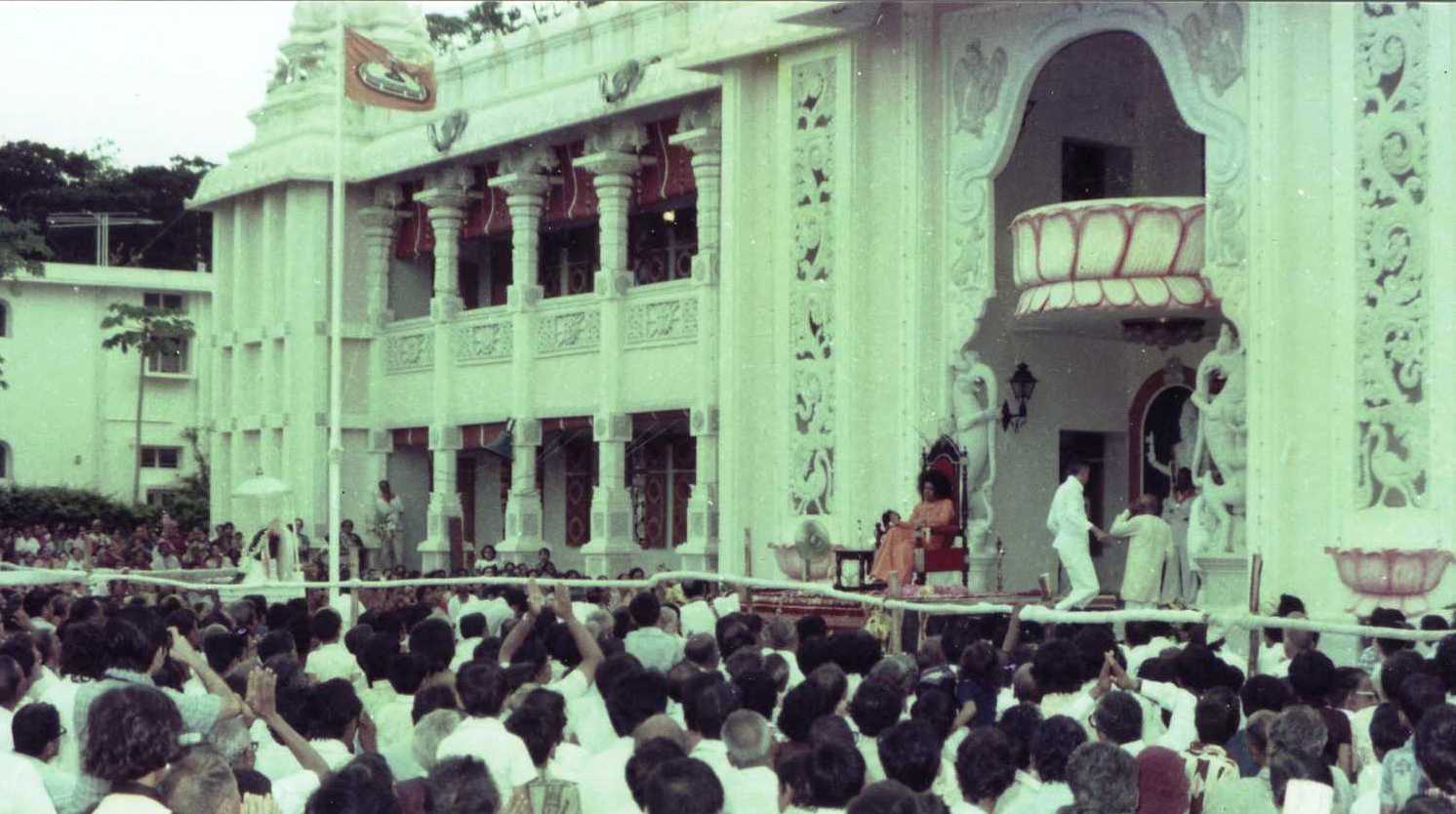
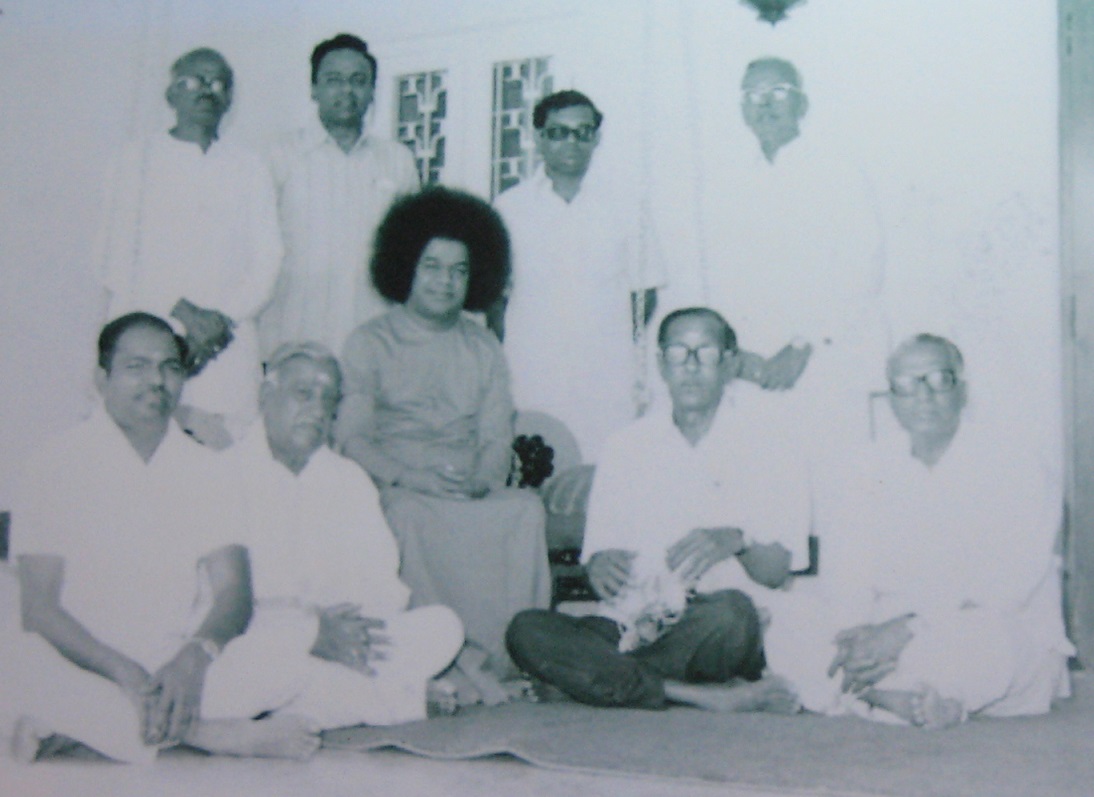
1981
- January 4: Central Office of the World Council of Sri Sathya Sai Organisations inaugurated at Prasanthi Nilayam
- January 14: A permanent charter granted to Sri Sathya Sai Organisation to be administered by Sri Sathya Sai Central Trust
- January 19: Baba inaugurates Sundaram, his residence in Madras
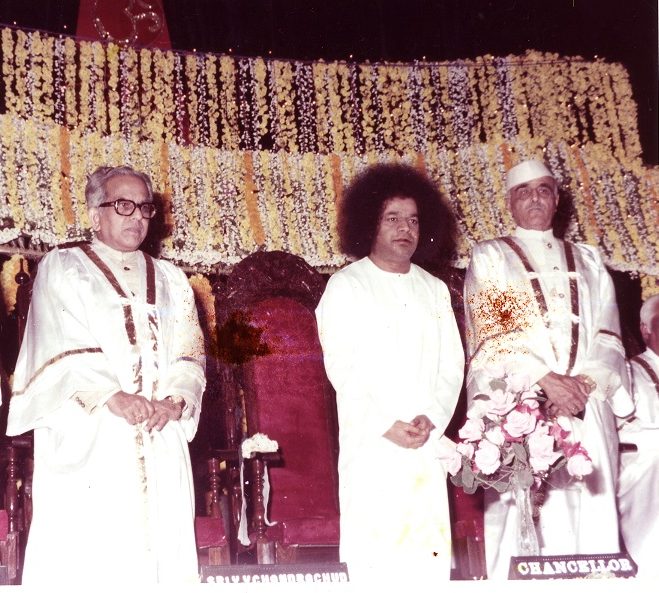
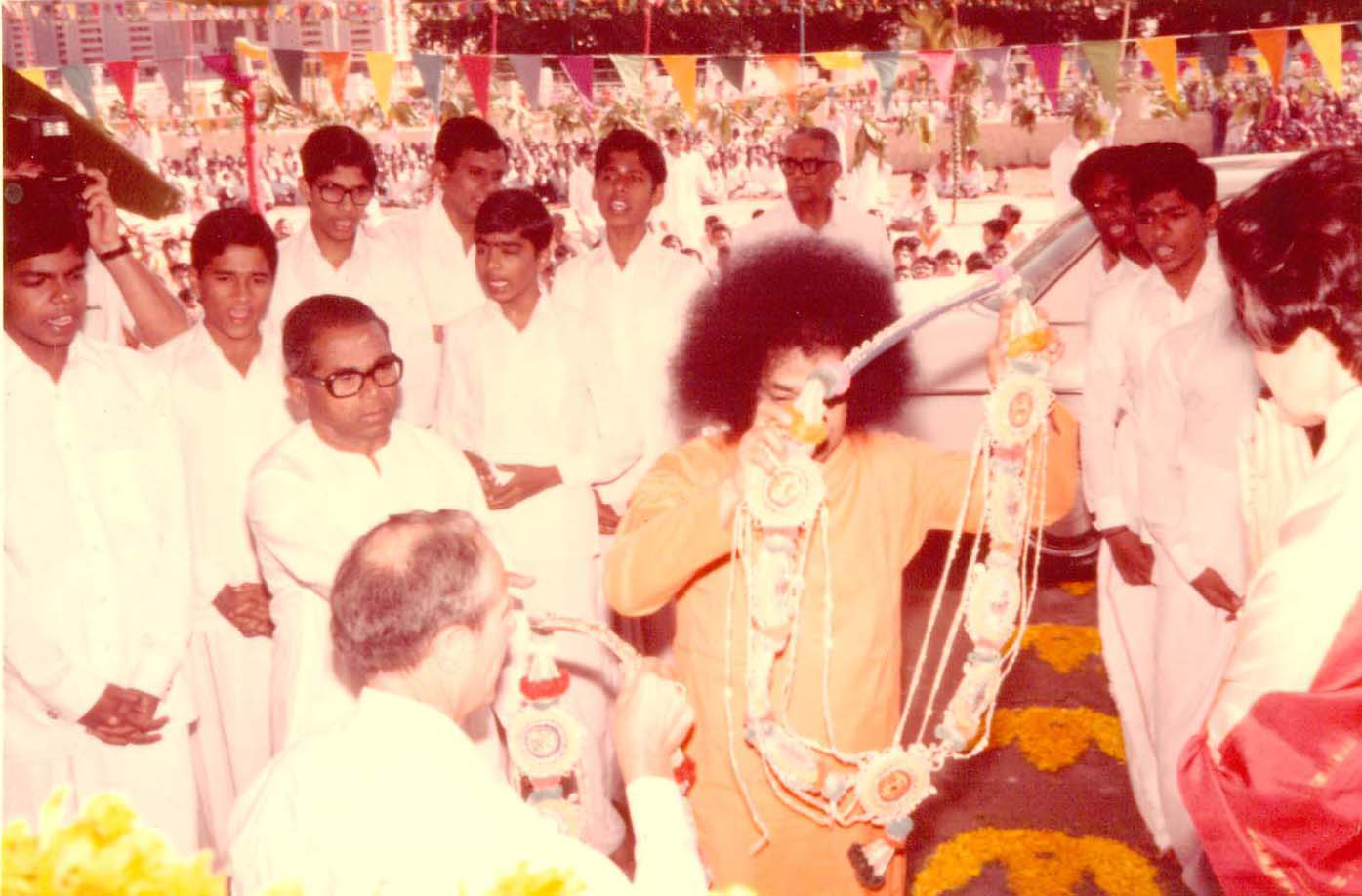
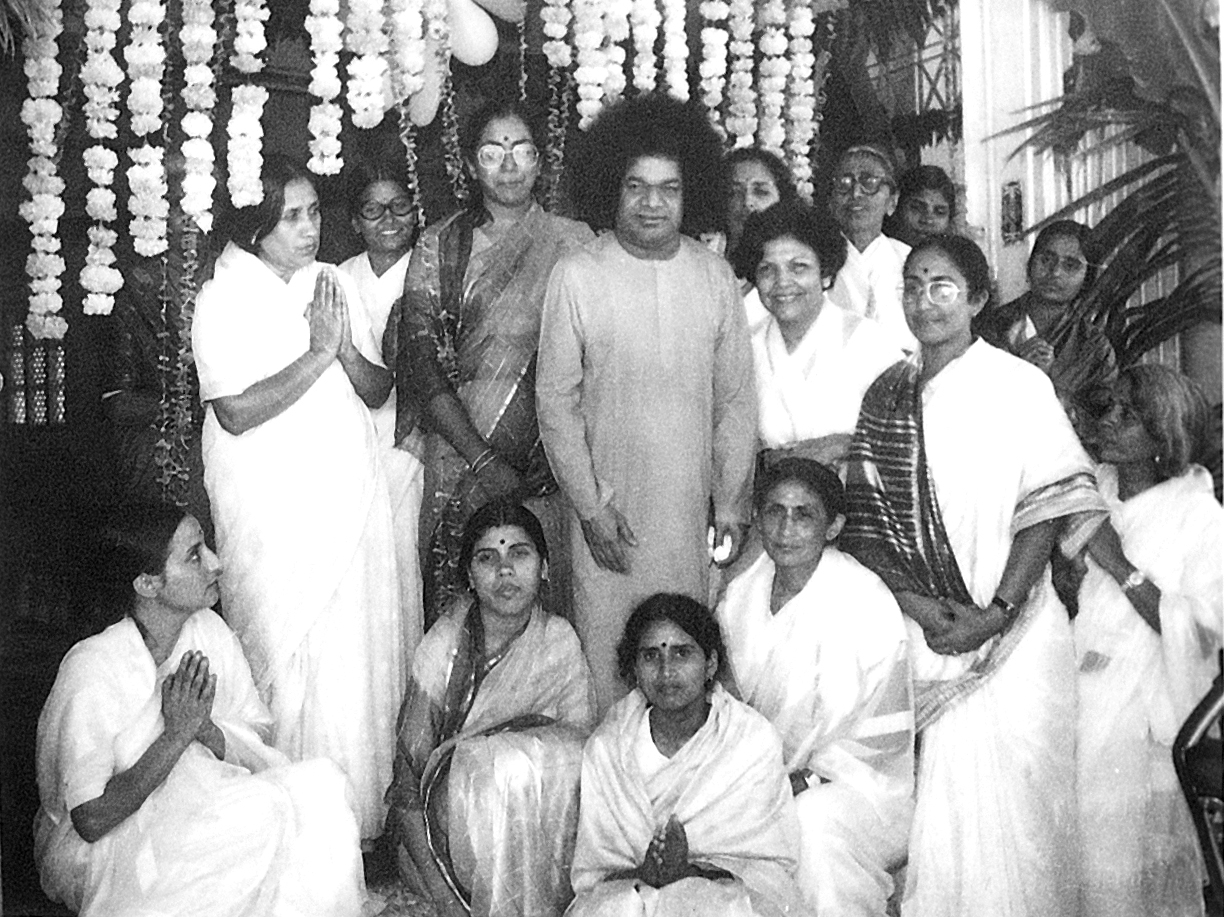
1981
- May 15: Baba visits Rajahmundry and accepts the Navbharat Gurukulam into the Sai Mission
- June 15:Sri Sathya Sai Primary and Higher Secondary School inaugurated at Prasanthi Nilayam.
- November 22: Sri Sathya Sai Institute of Higher Learning(Deemed University) inaugurated in Prasanthi Nilayam by Chief Justice of India, Y.V. Chandrachud.

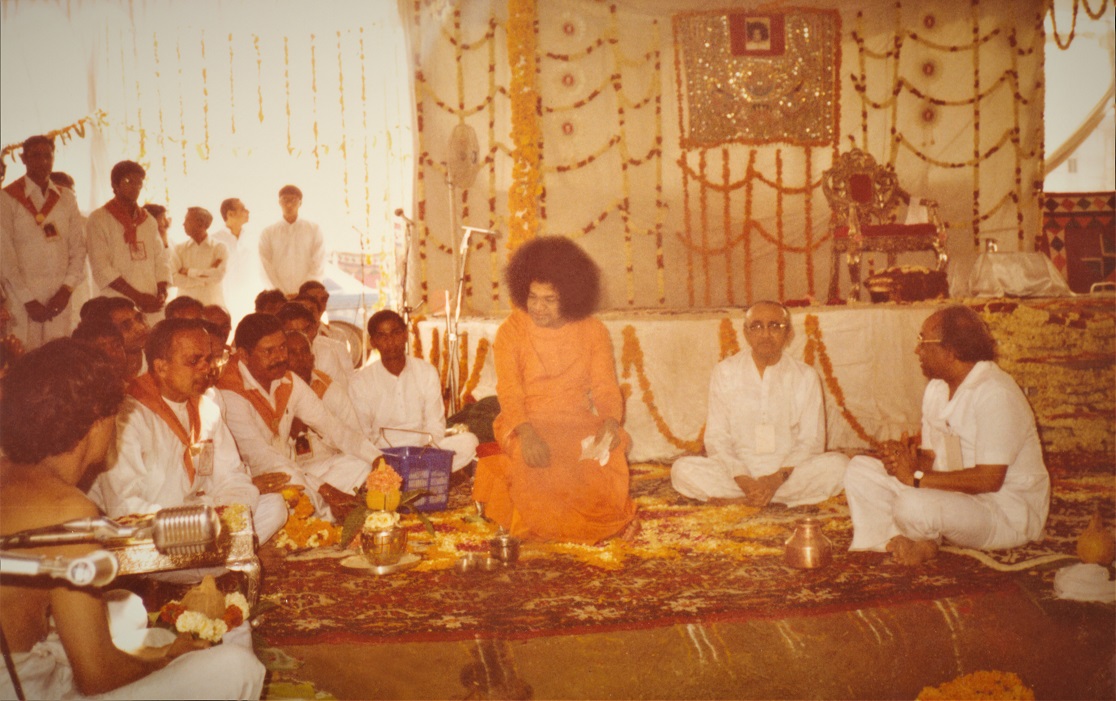
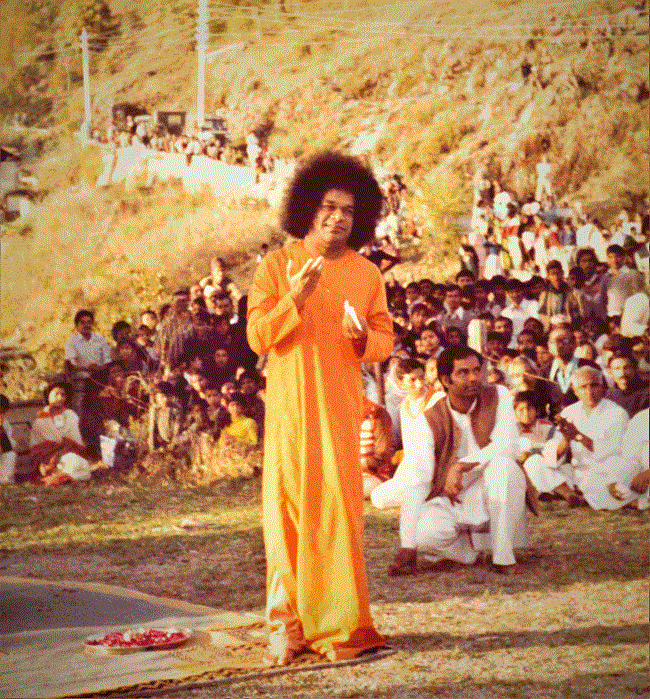
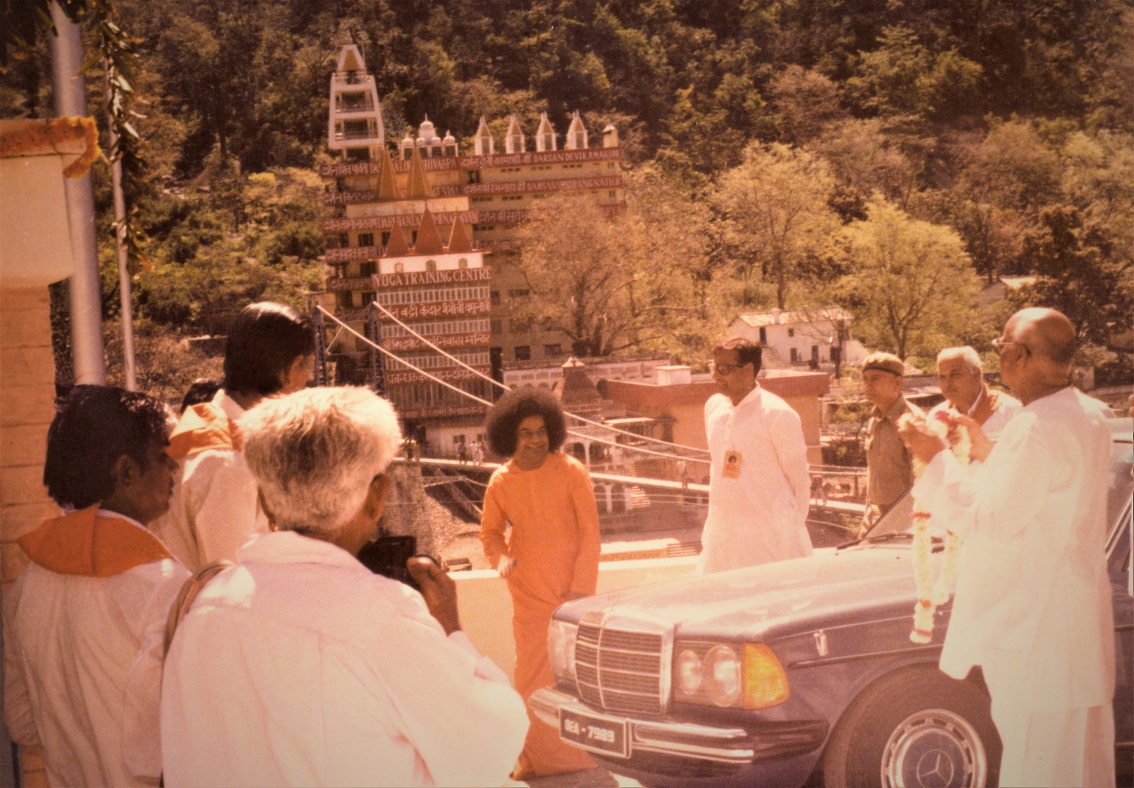
1982
- January 27: Governor of Maharashtra arranges a musical evening in honour of Baba at the National Centre for Performing Arts (NCPA), Bombay
- April 6-11: Baba blesses the Bhoomi Pooja of Sri Sathya Sai School at Delhi; visits Rishikesh, Dehradun, Mussorie, Meerut, Ghaziabad, Panipat and Karnal.
- April 13: Baba inaugurates Shantivan, his residence in Bhopal
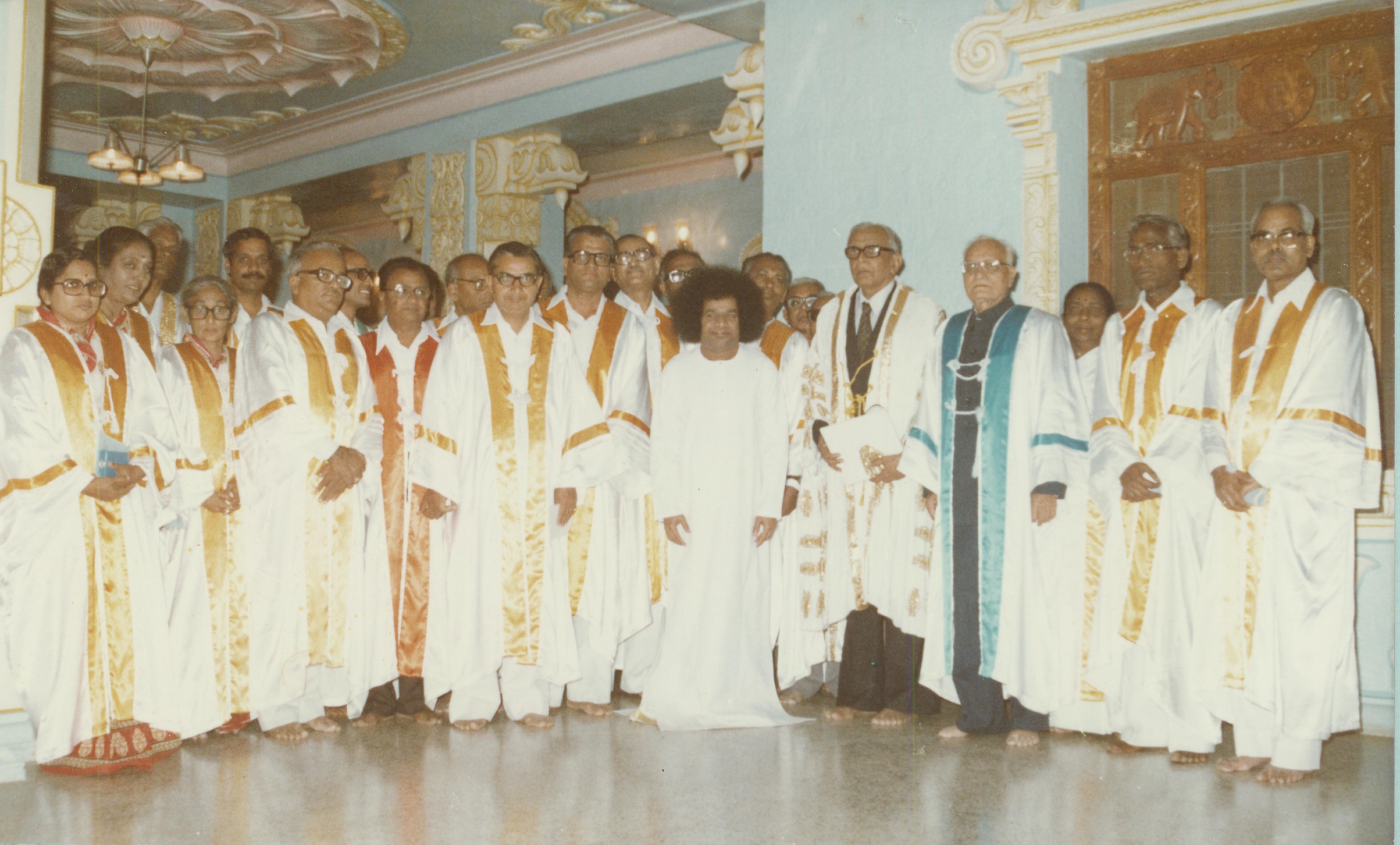
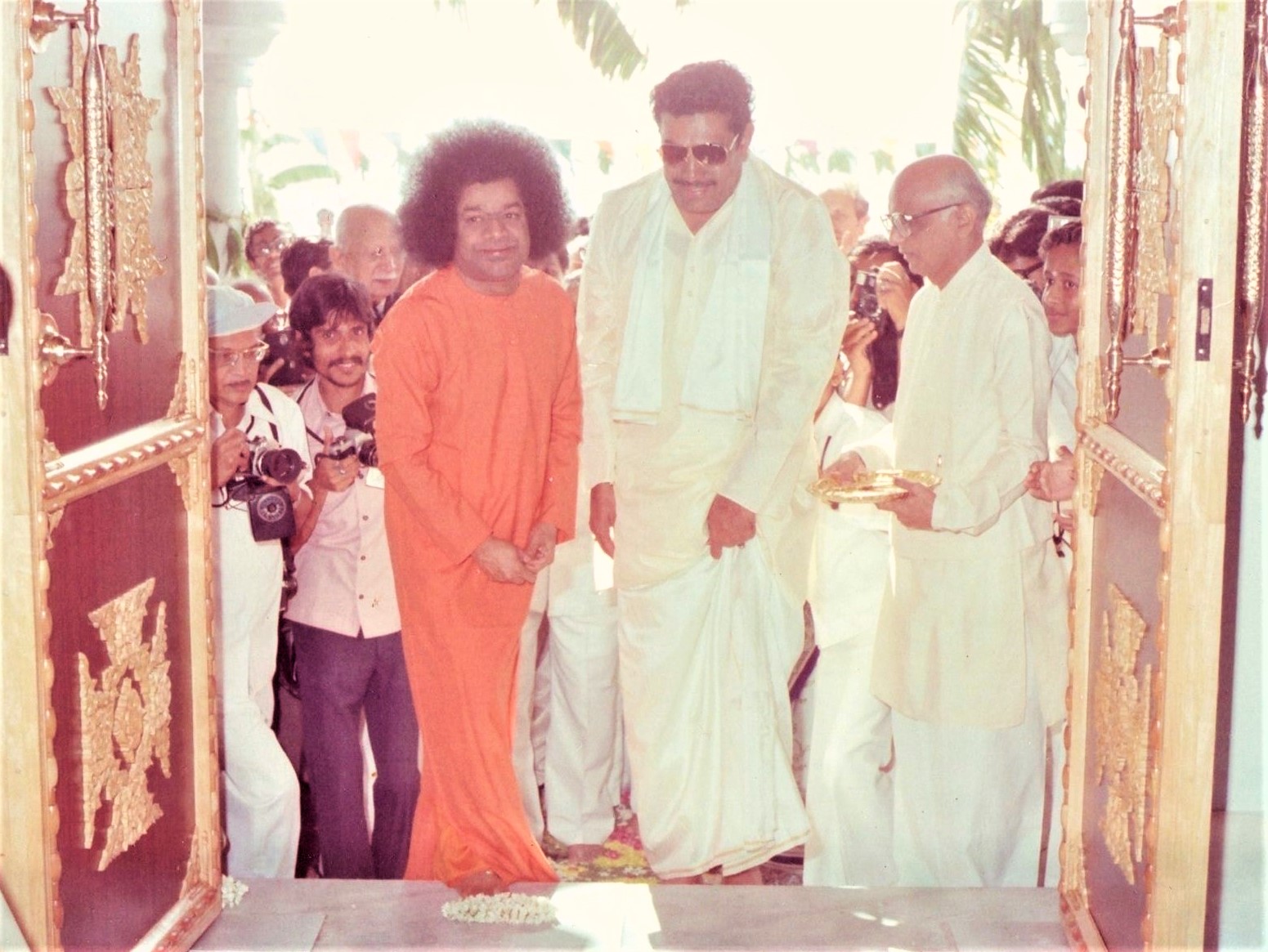
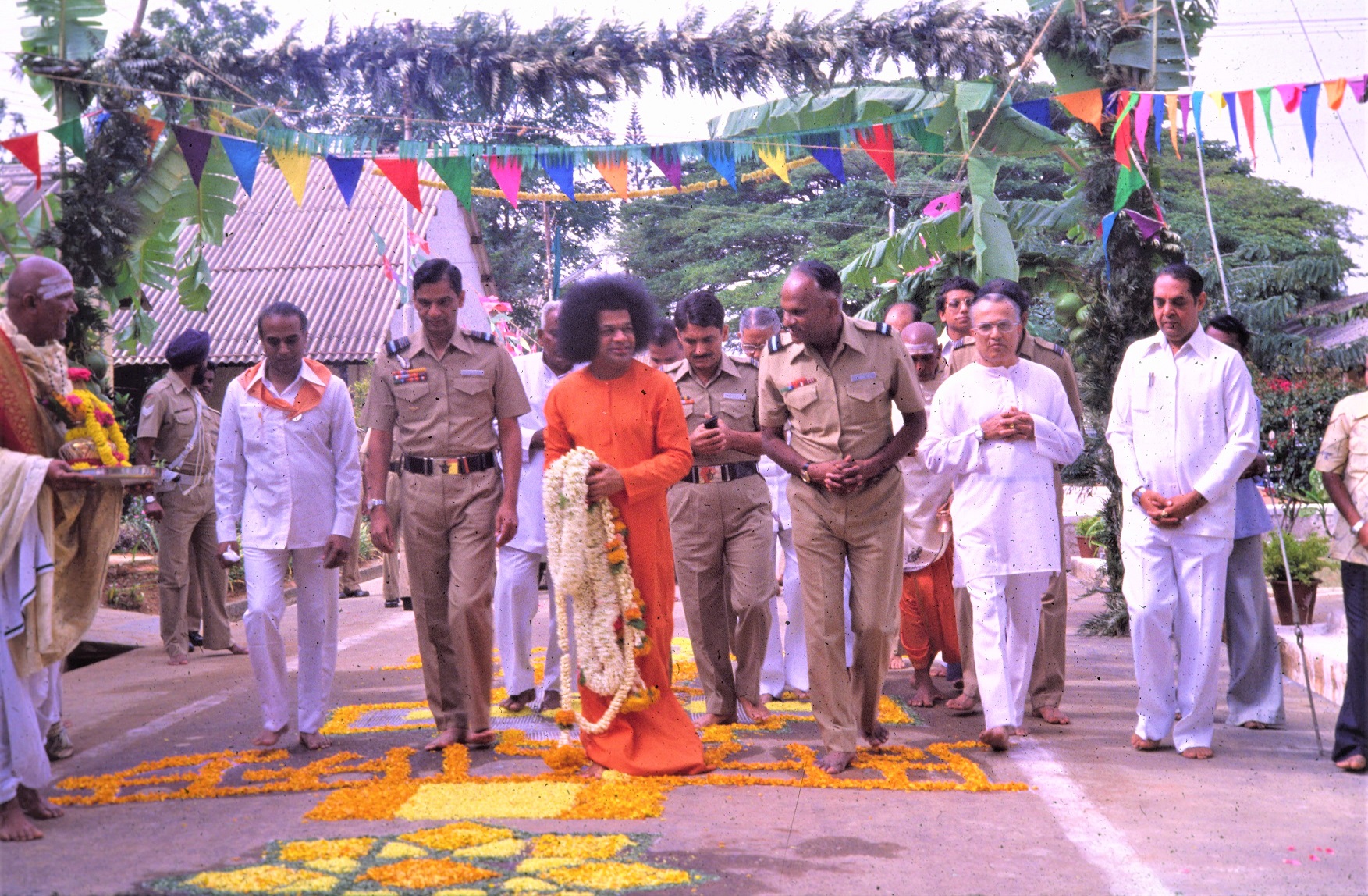
1982
- May 14: Baba visits the Bhaba Atomic Research Centre (BARC) at Trombay
- November 22: First Convocation of Sri Sathya Sai Institute of Higher Learning held at Prasanthi Nilayam; renowned jurist Nani Palkhivala is the Chief Guest. The Administrative Building of the University is inaugurated by Chief Minister of Karnataka.
1983
- April 6: Baba inaugurates the ‘Sathya Sai Shanti Sudha’ Mandir at Guntur; addresses five lakh devotees gathered on the occasion.
- Sri Sathya Sai Books and Publication Trust is established. The Trust takes up the task of publishing books on Baba’s life, mission, and message.
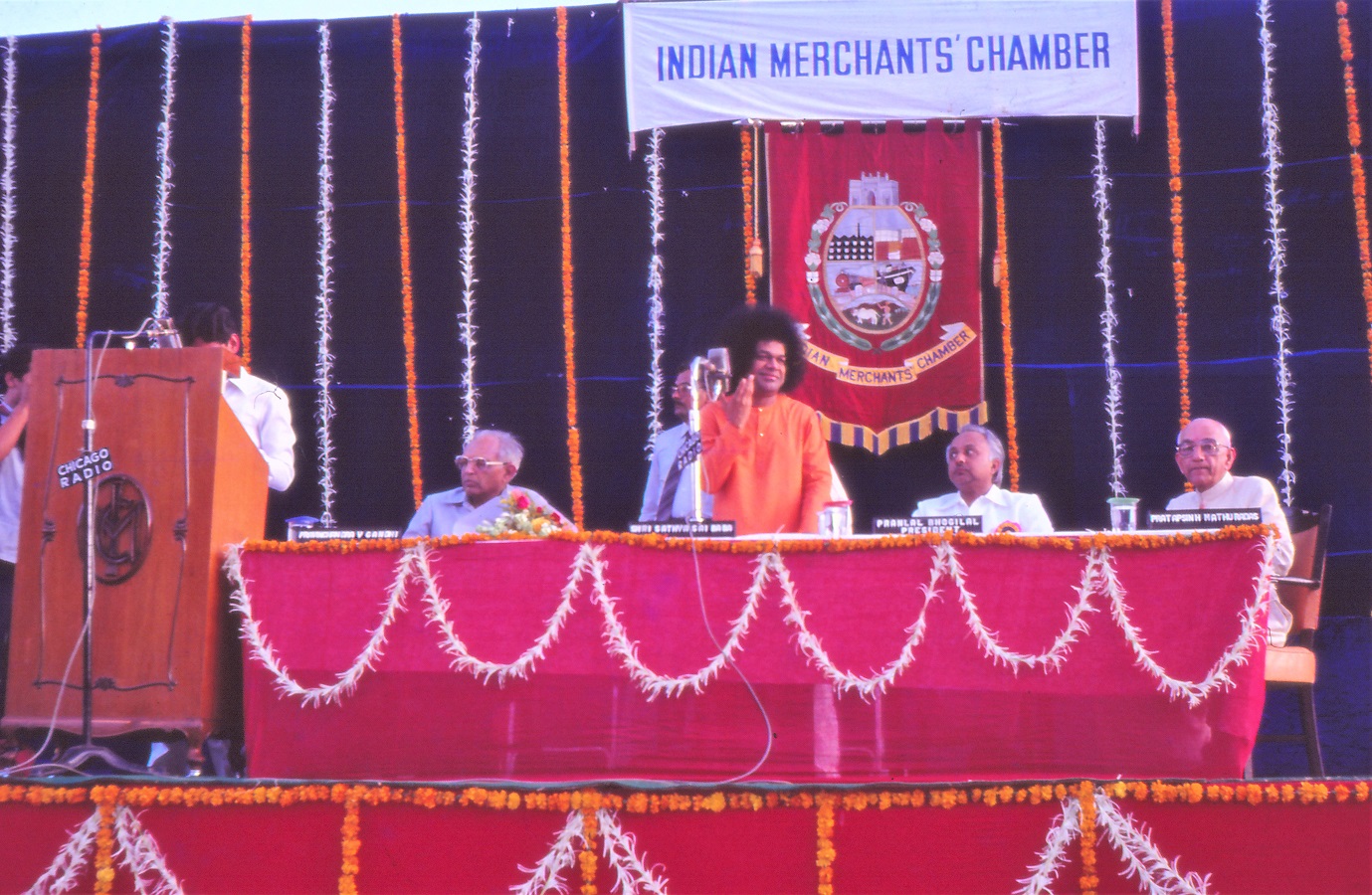

1984
- April 26: Trayee Brindavan, Baba’s new residence at Bangalore inaugurated
- May 14: Baba addresses eminent industrialists and business leaders at the Indian Merchants Chamber programme in the Brabourne Stadium in Bombay
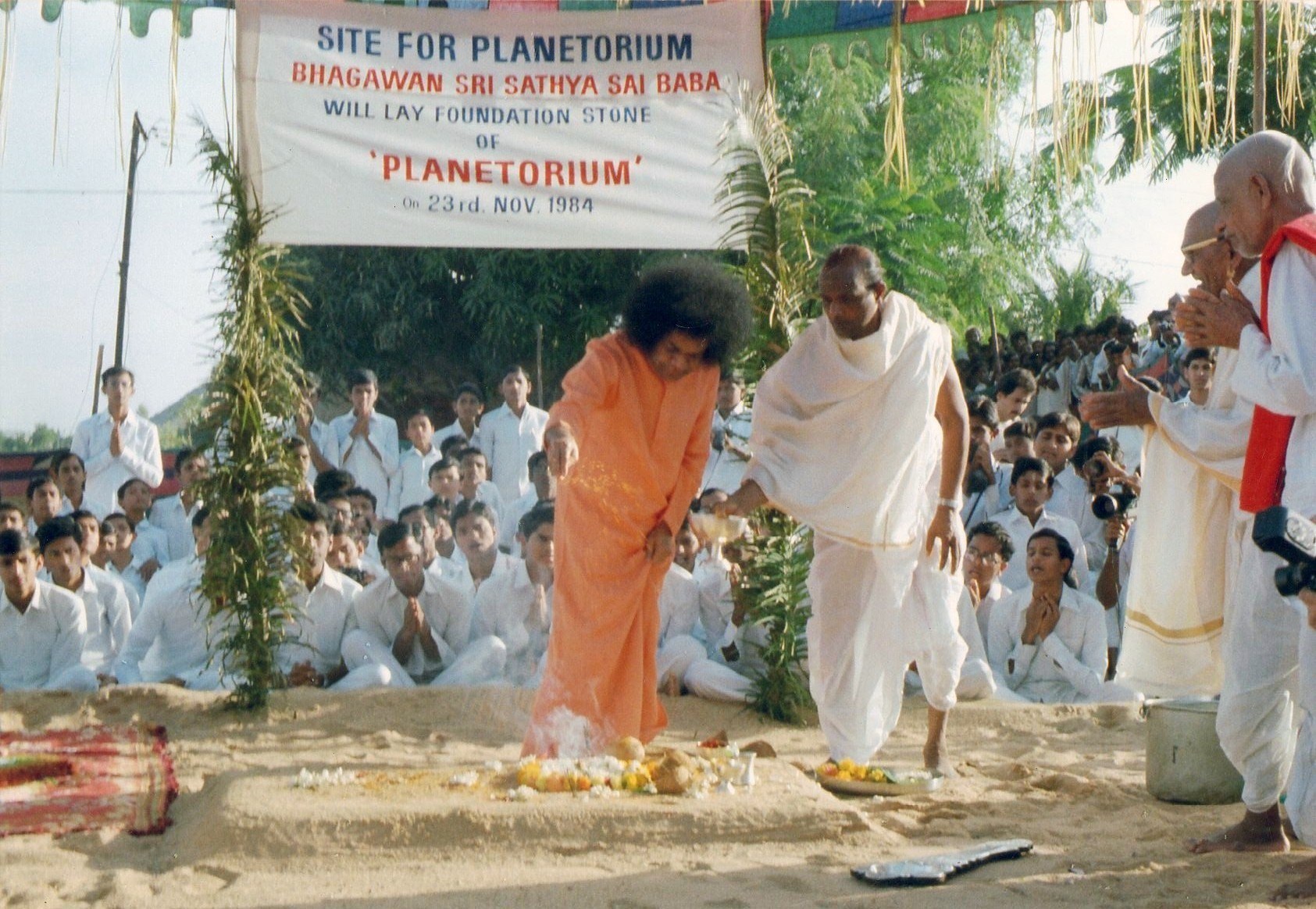
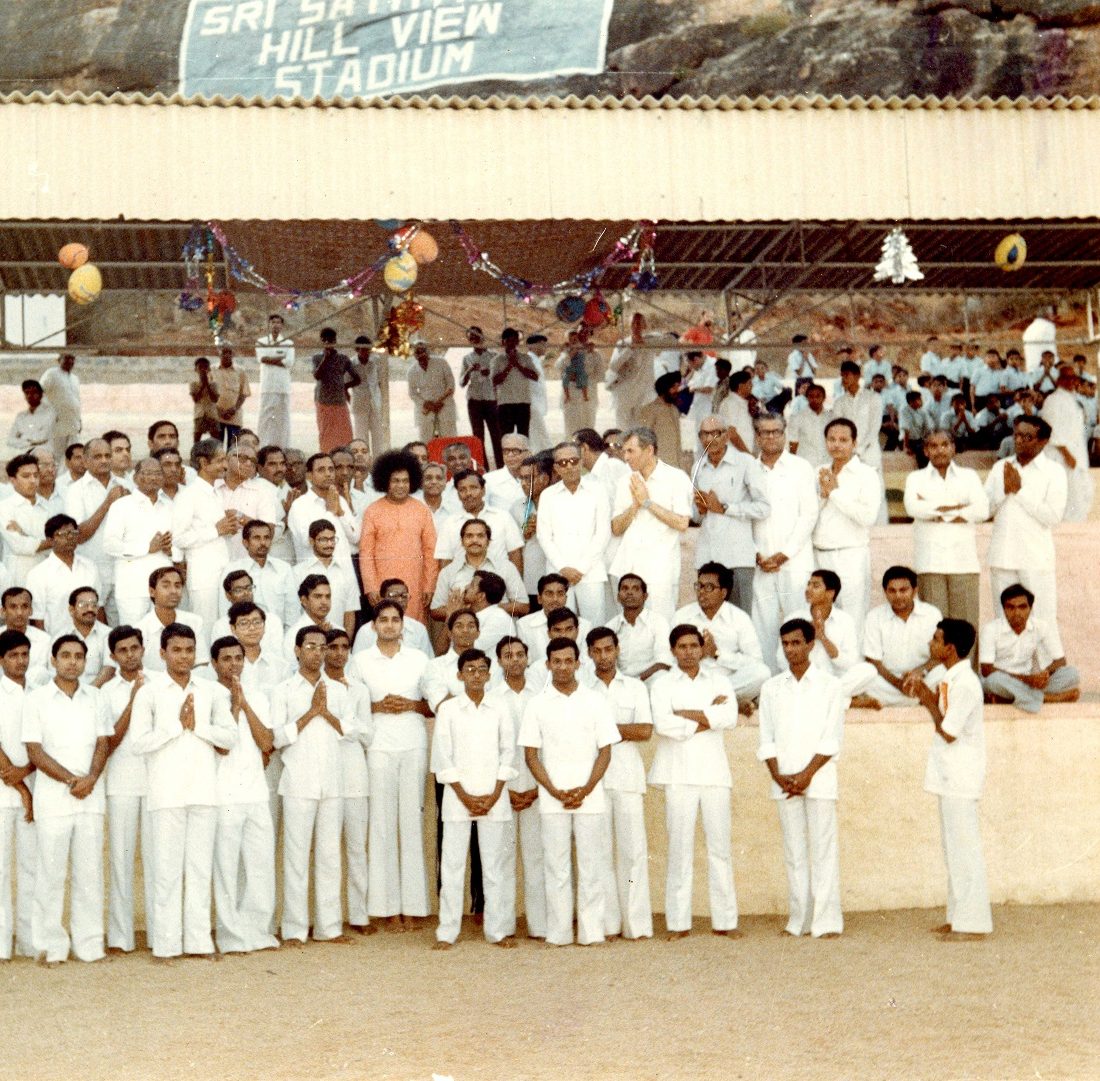
1984
- August 2 – September 16: Baba delivers 34 discourses on the Bhagavad Gita continuously during these six weeks at Prasanthi Nilayam Mandir.
- November 18: First International Seva Dal Conference held at Prashanti Nilayam
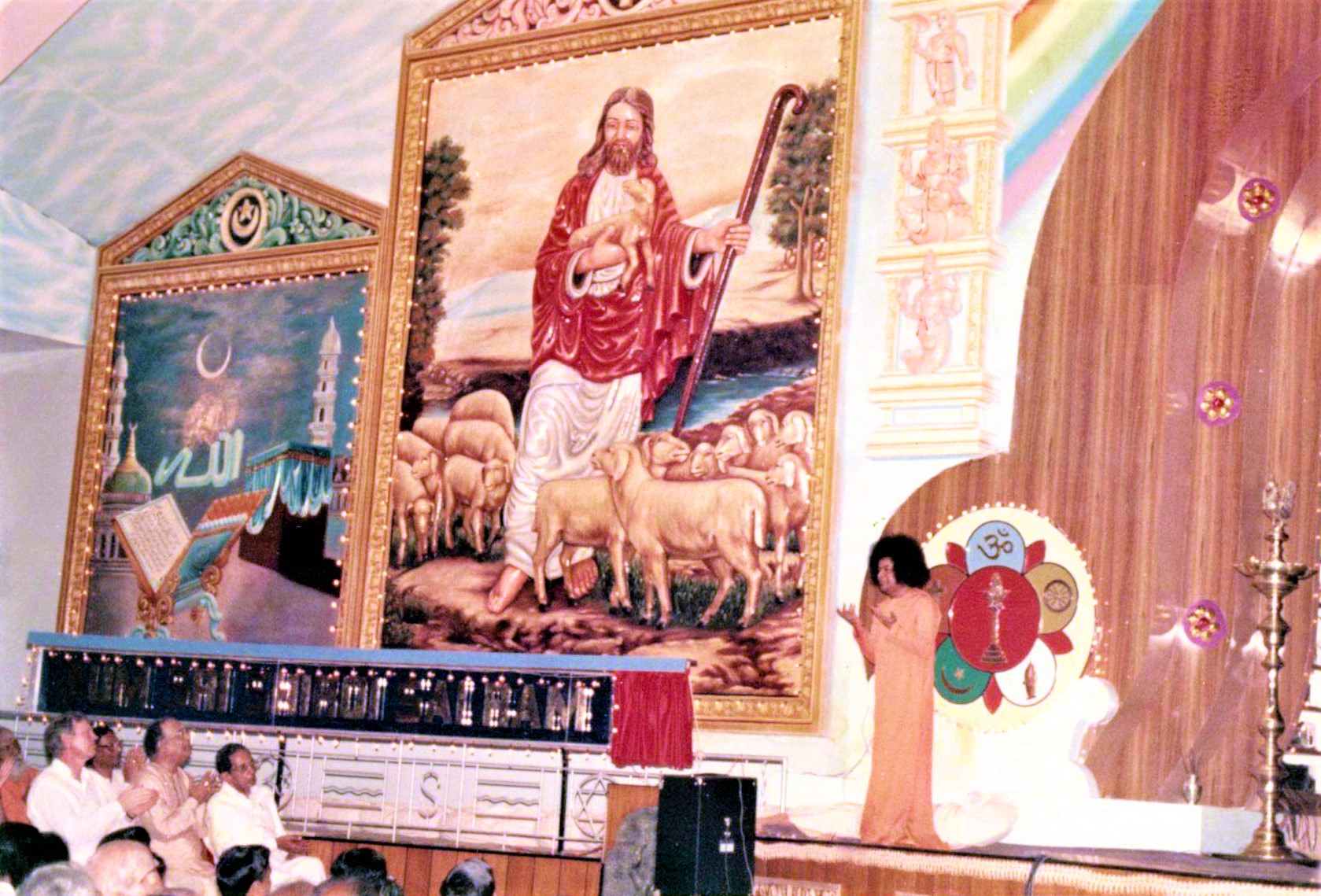
1985
- November 14: Shanti Vedika in the Hill View Stadium at Prashanti Nilayam inaugurated by Baba
- November 17: The 4thWorld Conference of Sri Sathya Sai Organisations commences at Prasanthi Nilayam
- November 22: Sri Sathya Sai Space Theatreand Sri Sathya Sai Institute Central Library inaugurated at Prasanthi Nilayam.

1985
- November 23: 60thBirthday celebrations attended by lakhs of devotees at Prasanthi Nilayam. In His discourses Baba gives the Nine Point Code of Conduct and Ten Directive Principles to be practiced by all members of Sri Sathya Sai Organisations.
- December 9: Governor of Karnataka and Chief Justice of Karnataka participate in the 60thBirthday Celebrations held in Bangalore at Chowdiah Memorial Hall and Raj Bhavan.
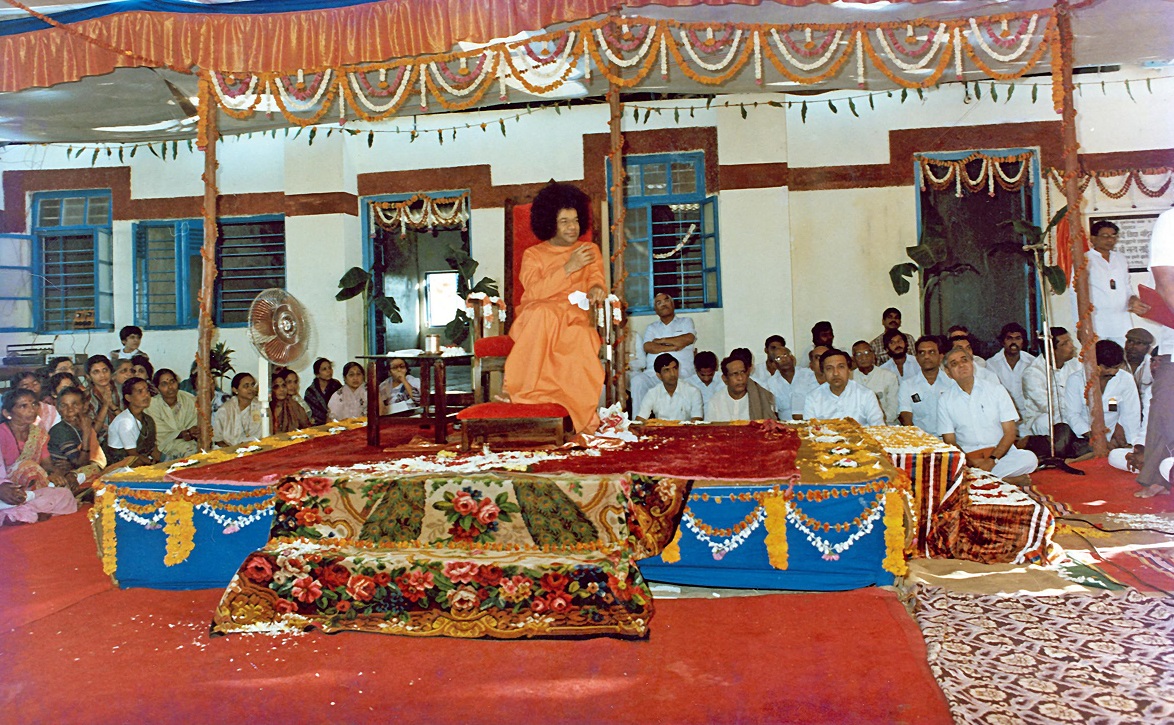
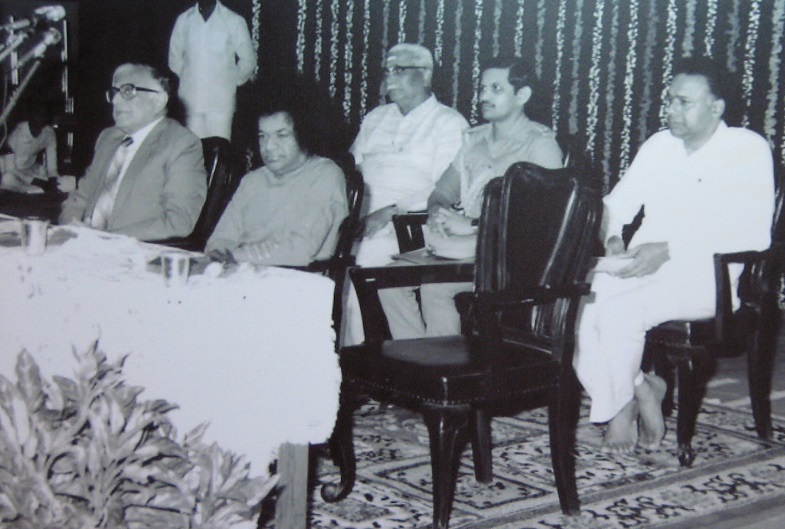
1986
- June 18-25: Baba inaugurates Sai Shruti, his residence at Kodaikanal
- November 4: Beltimo Craxi, Prime Minister of Italy, along with his family came to Prasanthi Nilayam for an audience with Baba.
- November 12: Likhita Japam books containing 60 crore ‘Sai Ram’ Naama written by 3,620 devotees were offered to Baba at Prasanthi Nilayam
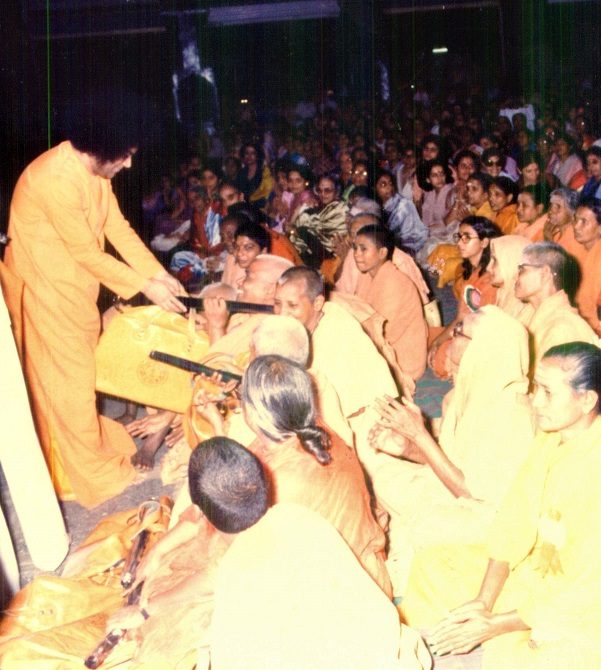

1987
- January 2-4: The Annual Conference of Akhila Andhra Sadhu Parishad held at Prashanti Nilayam
- September 24-26: A National Symposium on ‘Value Orientation in Higher Learning’, the first of its kind on an all-India basis, organised at Prashanti Nilayam with participation of leading Vice Chancellors
1988
- January 7: Sri Sathya Sai Dharma Prachar Parishad launched
- January 11: The first Annual Sports and Cultural Meet of Sri Sathya Sai Institute of Higher Learning held at the Hill View Stadium
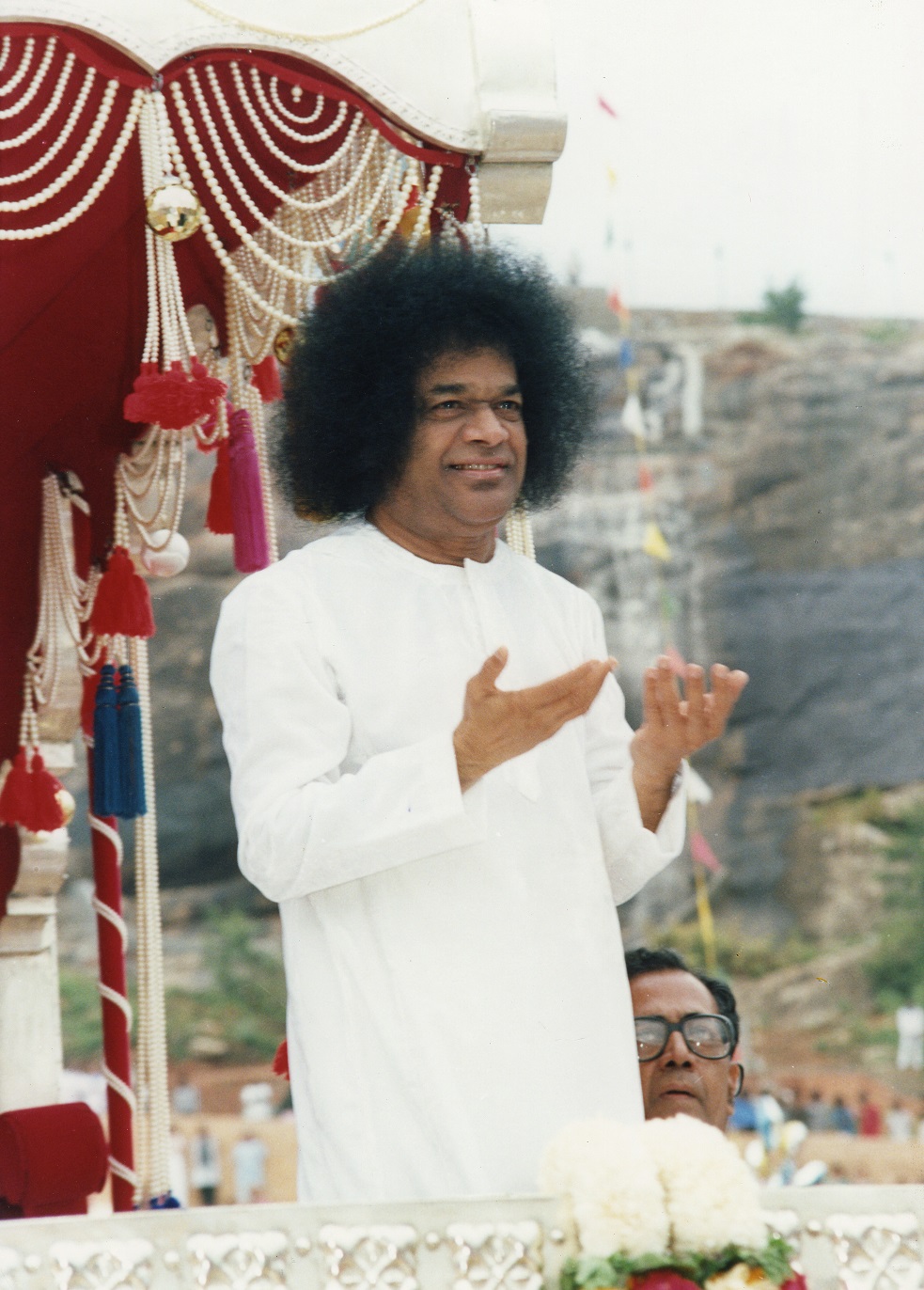

1990
- September 28: On the birthday of Shirdi Sai Baba, Baba reveals many unknown aspects of his life
- November 17: Baba inaugurates the new bus terminal at Prasanthi Nilayam in the presence of the Chief Minister of Andhra Pradesh
- November 19: The 5thWorld Conference of the Sri Sathya Sai Seva Organisation inaugurated at Prasanthi Nilayam
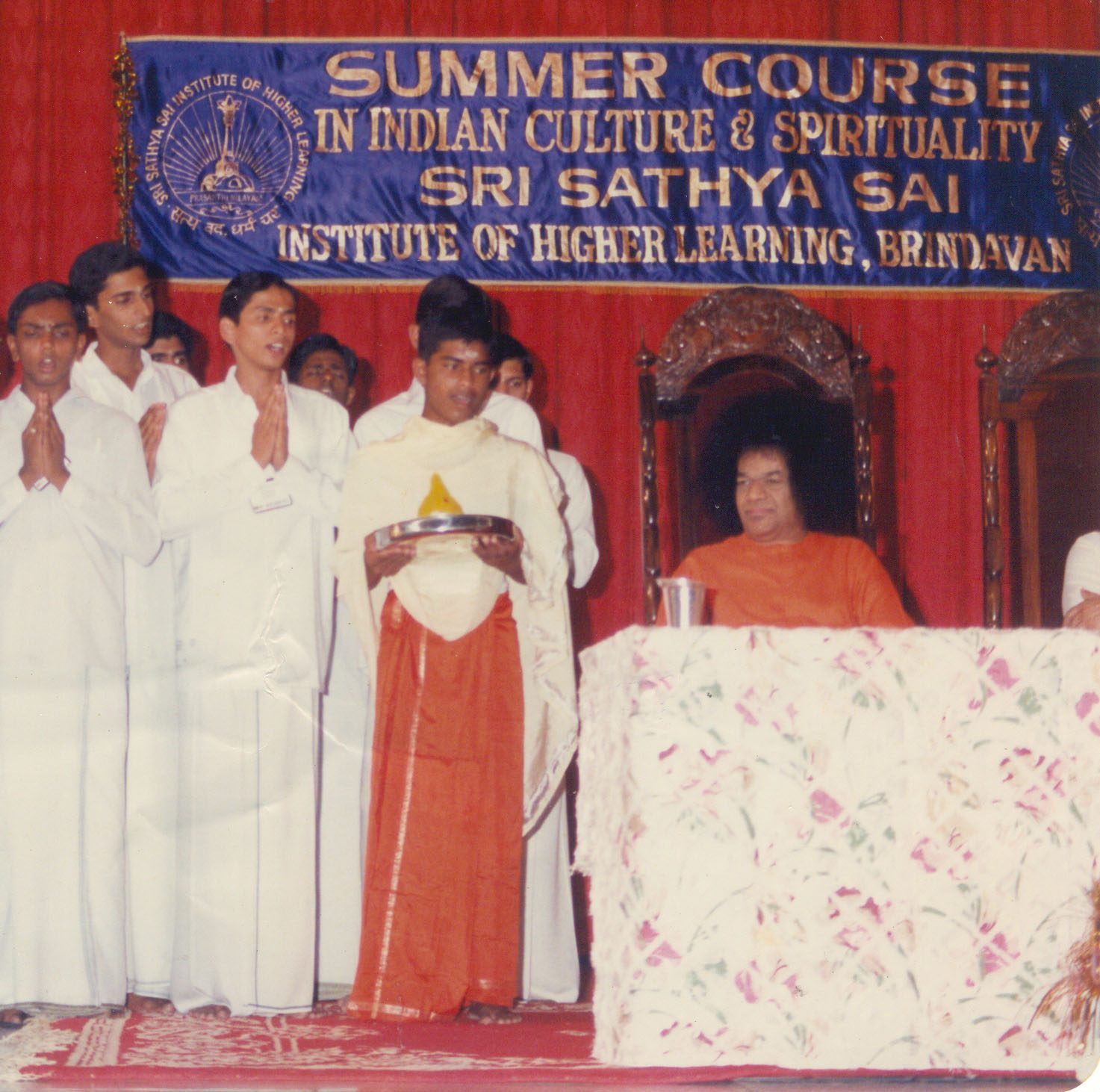
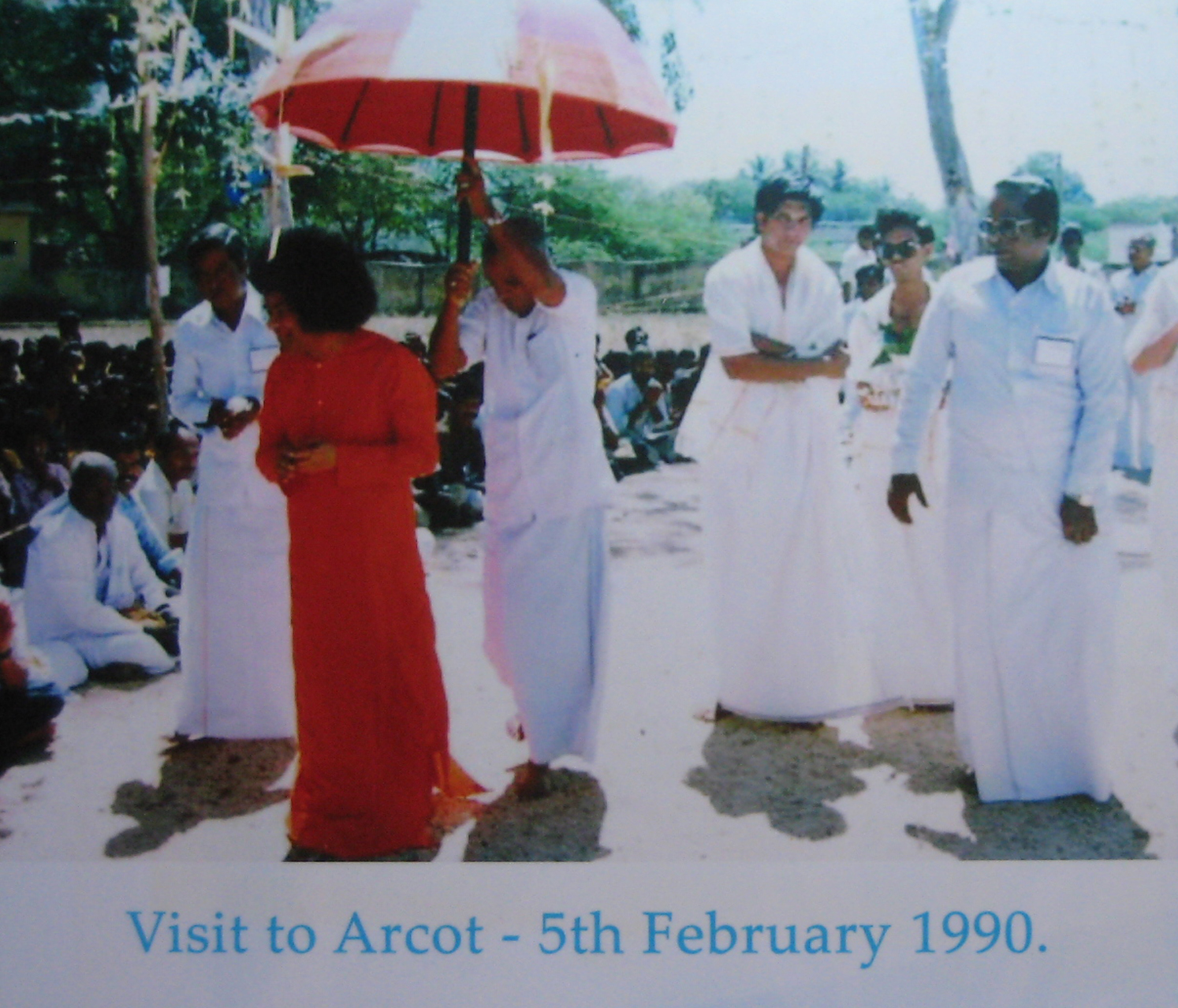
1990
- November 22: Baba laid the foundation stone for a Super Specialty Hospital at Puttaparthi; inaugurates Sanathana Samskruthi – the Eternal Heritage Museumand the 65-feet high statue of Hanuman on the mountain top in the Hill View Stadium on his 65th President of India, R. Venkataraman is the Chief Guest for the 9th Convocation of Sri Sathya Sai Institute of Higher Learning
LIFE
Life & Message
A Summary
Sri Sathya Sai Baba was born in Puttaparthi on Nov 23, 1926 - an auspicious Monday in the lunar month of Kartika, when Lord Shiva is especially adored. He was given the name Sathyanarayana Raju. What intrigued His mother Easwaramma, most was the unbounded compassion her little Sathya had particularly for the poor and downtrodden. Even as a toddler, He insisted that the beggar at the door be served well in spite of their own limited means and would often give His own share to the needy. When He began school, His playmates were inspired by His ability to lead them to be socially responsible, spiritually aware, endowed with individual and national character. His friends were often fascinated by His extraordinary powers of creating things out of thin air, knowing the future, deep understanding of scriptural wisdom and so on.
The inexplicability of His actions greatly disturbed His father Sri Ratnakaram Pedda Venkama Raju, and on May 23, 1940, he angrily accosted Sathya to reveal His true identity. Sathya just took a few flowers and flung them down which arranged themselves to read "I am Sai Baba." Later that year, on the morning of Oct 20, halfway through the school day, Baba suddenly returned home, cast aside His books and dramatically declared, "I am no longer your Sathya... I am Sai. I have my work, I cannot wait any longer." Thus, that day forward Sathyanarayana Raju became Sathya Sai Baba.
From that epochal moment on, kings to commoners started thronging to His presence seeking solace and succour as Baba cancelled an incurable disease of one, sorted out familial problems of another, and likewise. His growing fame, accompanied by rising ridicule from envious quarters, rattled His elder brother Seshama Raju, who wrote a letter cautioning Him of His activities. In His reply, dated May 25, 1947, Baba emphatically stated that He has a 'Task' to 'foster all mankind with bliss', a 'Vow' to 'lead all onto the path of righteousness', and a 'Work' of 'removing the suffering of the distressed', also assuring that He would never give up on those who attach themselves to Him.
Towards this end, in the 1960s Baba germinated the Sri Sathya Sai Seva Organisations in India, through which people across religions, class and caste, could collectively engage in selfless service and foster the eternal values of Truth, Righteousness, Peace, Love and Non-violence, for their own spiritual uplift. In no time the movement grew global to more than 126 countries with Prasanthi Nilayam being its epicentre.
While millions of inspired individuals took to practising selfless love, to create working models for them to emulate, Baba founded the Sri Sathya Sai Central Trust in 1972. Since then this umbrella institution is engaged in the implementation of trailblazing projects like free primary to tertiary-care hospitals, free education from primary schooling to doctoral research, free drinking water to remote villages, free housing rehabilitation initiatives, etc., demonstrating to the world new paradigms to raise society's quality of life inspired by love, service and universal brotherhood. Baba, Himself exemplified this higher life incessantly for 86 years where the power of pure love was in glorious action.
Baba discarded His bodily vesture on April 24, 2011. The devotees miss His physical form, nevertheless, they continue to experience His guidance and grace, as enigmatically as ever.
The Childhood Saga
The Raju family of Puttaparthi was noted for its piety since the days of the renowned sage, Venkavadhootha, a saintly ancestor who was looked upon as a Guru in hundreds of villages around. Not only did the family build and endow the Gopalaswami Temple (dedicated to Lord Krishna), but Sri Ratnakaram Kondama Raju, the grandfather of Baba's physical frame, dedicated a temple to Sathyabhama, consort of Lord Krishna, a deity to whom this type of homage is seldom offered in any part of India. Peasants by vocation, they were known for their musical and dramatic talent and were much involved in the propagation of the sacred scriptures through village plays and musicals. Consequently, the family was given the name 'Bhat Raju' (Bhat - priest).
Sri Kondama Raju was a pious soul who lived out his hundred and ten years of earthly existence in the unceasing contemplation of the Lord. His wife Srimathi (Smt) lakshmamma predeceased him by twenty years. They had two sons who were both named after Sage Venkavadhootha - Sri Pedda Venkama Raju and Sri Chinna Venkama Raju. Sri Pedda Venkama Raju, the elder son, was married to Easwaramma, daughter of Sri Meesaraganda Subba Raju of Kolimigundla of Kurnool district. Sri Pedda Venkama Raju and Smt Easwaramma were blessed with a son and two daughters in that order, Seshama Raju, Venkamma, and Parvathamma.
Some years passed and Easwaramma longed for another son. She prayed to the village gods, performed Sathyanarayana Puja and observed a number of rigorous vows. One day, an extraordinary incident occurred that heralded the descent of the divine into her womb. Easwaramma had gone to the village well to draw water. There, she noticed a strange bluish glow that transformed itself into a luminous orb. The ball of light then glided towards her and entered her being. Shortly thereafter, to the joy of her family, Easwaramma found herself in the family way.
Divine Prelude
After a while, mysterious indications of the impending incarnation occurred in Sri Pedda Venkama Raju's house. For example, there was the twang of the tambura! Since the brothers and the father were all interested in the village operas, there was a big tambura (a string instrument) and a maddala (drum). As the birth of the son for whom Mother Easwaramma prayed, announced itself as imminent, the house was awakened at midnight, and sometimes even later, by the tambura twanging automatically, and the maddala beating rhythmically as if an expert Hand was playing on it! One Shastri (Vedic scholar), whom Sri Pedda Venkama Raju approached for an explanation, said that it was an auspicious occurrence: it meant the presence of a Shakthi, a beneficent Power, conferring harmony, spiritual elevation and joy.
The Advent
23rd of November, 1926, the Hindu year of Akshaya, meaning, the Never-declining, the Ever-full. It was the time of sunrise and the villagers were chanting the names of Lord Shiva, remembering that the day was Karthika Somavara, a Monday of the Holy Month of Karthika, devoted to the puja (worship) of Shiva. That day was made even more auspicious for Shiva worship because the ascendant star was Ardra (the star of Shiva). On this day, when these rare and propitious signs came together, the people thronged the temples of the Lord to offer special pujas and pray for His benediction.
The Mother had also just finished her Sathyanarayana Puja in accordance with her vows, for, even while she was going through the final rituals, the pangs forewarned her. When Easwaramma announced the pangs, word was sent to the mother-in-law, Smt Lakshmamma, the pious lady of the house; but, it became known that she had gone to the house of the priest to perform the Puja of Sathyanarayana; the messenger discovered her there and urged her to return; but she was so confident of the Grace of Lord Sathyanarayana, so steadfast in her devotion, so disciplined in her religious adherence, that she refused to be hustled!
She sent word that she would bring with her the sacred offerings after the Puja and that on no account would she allow her prayers to be interrupted! She finished the entire ritual with full concentration, came home and gave her daughter-in-law the flowers and the sacred water. Easwaramma partook of the blessings of the Lord. Next moment, the Lord was born and the Sun rose above the horizon!
The Divine Child
A very significant event occurred soon after the birth of the child, which revealed the divinity of the baby. One day, it was noticed that the bed of clothes on which the baby was lying was being moved up and down in a peculiar way by something underneath. They watched with bated breath and when they looked under the bed they found a cobra underneath! The snake was playing the role of Sesha to the Seshasai! (Sesha, according to Hindu belief, is the serpent on whose bed of coil Lord Vishnu rests.)
The baby was named Sathyanarayana because there seemed to be a significant relationship between the worship to that God and the realisation of the mother's cherished desire. When the Namakaranam (Naming Ceremony) was performed and the name was whispered in the ear; it seems the baby smiled, for the suggestion to give that name must have emanated unobtrusively from Itself! The embodiment and exponent of Truth could not give Himself a more appropriate name.
The little “Brahmajnani”
Little Sathya soon became the pet of the entire village of Puttaparthi and the farmers and cowherds vied with each other in fondling it and feeding it and playing with its lovely silken curls. Its charming smile attracted everyone. Like a lighted lamp, Sathya moved about the house and laughter tinkled in the street when He lisped His sweet vocabulary of sounds.
The villagers soon started referring to Him as "Brahmajnani", the knower and proponent of Brahman or Godhood.
Even at a young age, Sathya was known for His extraordinary love and compassion towards creation and aversion towards harming any creature. His heart melted at human suffering. Whenever a beggar appeared at the door and raised his cry, Sathya abandoned His play and rushed in, to force His sisters to dole out grain or food. The elders in the house tried to dissuade Him saying, “Look here! You may give him food; but, mind you, you will have to starve." That did not daunt the child; He used to run inside and bring food to the hungry man at the door; and stay away from dinner or lunch, himself. Nothing and nobody could persuade him to come to His plate, which was left untouched!
The Early School Days
At the age of eight, Sathya was declared fit to proceed to the Higher Elementary School at Bukkapatnam, about two and a half miles from Puttaparthi. He had to start early, after a meal of cold rice and curds or cooked ragi (maize), rice and chutney, carry the afternoon meal in a bag, and with His companions make the arduous trek daily to Bukkapatnam.
Sathyanarayana was a precocious child, learning more things than anyone could teach Him and much quicker than most; He could sing all the songs and Stotras (prayers) that were recited at the village operas. He even composed at the tender age of seven or eight, some touching songs for the cast, which was gladly accepted by them for public presentation!
The Pandhari Bhajan group
When He was about ten years of age, Sathya formed a 'Pandhari Bhajan' group in the village of Puttaparthi. The group consisted of about sixteen to eighteen boys dressed uniformly in ochre clothes, each holding a flag in the hand and wearing jingling anklets. They all danced to the tune of folk-songs and ballads, describing the yearning of pilgrims for Lord Panduranga's Darshan. He also added some Bhagavatha songs of His own. It was noticed that He added to these traditional themes, songs on a pilgrimage to a new shrine of which no one had heard, and the majesty of a new Deity of whom they had not even the faintest idea, Shirdi and Sai!
Moreover, it was observed that when an infection of cholera swept like a poisonous miasma over the area and wiped out entire families in the surrounding villages, Puttaparthi did not feel the blast of death. Wise men told one another that the Divine Atmosphere generated by the Bhajan group was responsible for saving their lives.
At Kamalapuram
Sathya had to move to Kamalapuram, a small town about 200 kilometres from Puttaparthi, with His brother Seshama Raju. His parents planned to give Sathya a college education, so that He may become an officer! And hence, they were prepared to part with their beloved son and send Him to Kamalapuram to the Board Middle School there, so that His studies could be continued.
Sathya was a quiet, well-behaved boy and the favourite of His teachers. Once, He sang the prayer song before the curtains went up on a drama in the town and those who heard His sweet voice spread the news that a 'fine musician' had come to town. Prayer songs at functions like public meetings became His monopoly thereafter.
A merchant by name Kote Subbanna who sold medicines, tonics, glassware, umbrellas, etc. came to know of Sathya's talents and approached Him for a ditty to market his new product. He gave Him the necessary information and by evening, Sathya was ready with an attractive Telugu song, which was sung in chorus by His friends and Him. They used to march along the streets, with placards in their hands, singing Sathya's slogan-filled jingle and evidently enjoying their task! A word may be said about Sathya and His involvement in the theatrical activities at school. Sri Thammi Raju, the teacher-in-charge, once asked Sathya, who was only twelve years old then, to produce a play in Telugu. Sathya plunged into the work very enthusiastically. The drama was a great success, not only because the hero of the play was a little boy, a role enacted by Sathya himself, but, chiefly because it had as its theme the eternal sin of man - hypocrisy. The title of the play was "Cheppinattu Chesthara?" meaning "Do we practise what we preach?" Meanwhile, Seshama Raju was transferred to Uravakonda. He decided to take Sathya along with him with the intention of admitting Him at the Sri Karibasavaswami District Board High School there. Accordingly, Sathya accompanied His elder brother to continue His studies at Uravakonda. The town of Uravakonda would be witness to the grand and mysterious events that would mark the momentous transformation of the young child into a great spiritual master who would change the very destiny of mankind.
Mysterious Turn of events at Uravakonda
Sathya was a quiet, well-behaved boy and the favourite of His teachers. Once, He sang the prayer song before the curtains went up on a drama in the town and those who heard His sweet voice spread the news that a 'fine musician' had come to town. Prayer songs at functions like public meetings became His monopoly thereafter. Sathya was sought after by people who had lost articles of value, for He had brought with Him to Uravakonda the reputation for intuitive perception, which revealed to Him the place where anything was! Baba says that in those days, He used to give His friends only the first and last letters of the names of the persons with whom the lost articles could be found. He left them with their own resources to recover the goods.
On March 8, 1940, the whole town was shocked to hear that a big black scorpion had stung Sathya in the twilight hours of the evening. However, Sathya slept that night without any sign of pain!
Everyone felt relieved, only to become anxious once again when the next evening, Sathya fell unconscious and became stiff; He would not speak and breathing appeared faint. Seshama Raju brought in a doctor, who gave an injection and left behind a mixture. Sathya was apparently unconscious throughout the night. The doctor came again in the morning and declared that the boy was out of danger!
An incident happened in the night which showed that Sathya was not 'unconscious' but, that He was actually subconscious! Someone suggested that the local deity be propitiated, because the condition of the boy may be due to some evil spirit that possessed Him. So, volunteers hurried to the temple and offered worship, placed flowers and incense, and broke a coconut at the altar. At that very moment, Sathya, who was to all intents 'unconscious', said, "The coconut has broken into three pieces," and when the volunteers came home with the offerings, they had with them three pieces and not the usual two!
Sathya got up in a day or two and began to behave in an extraordinary way. Baba has said that He Himself initiated the process of manifestation, for He could not wait any longer, playing about as a mere boy, with 'brother' and 'sister' and 'classmates' and other secular bonds. He wanted to demonstrate that He was beyond both 'Visha' and 'Vishaya', that neither the poison of the scorpion nor worldly attractions could ever affect Him.
Meanwhile, Sri Seshama Raju had informed his parents at Puttaparthi about the state of affairs at Uravakonda.
He had written that Sathya was not answering anyone who spoke to Him, that it was a herculean task to make Him accept food, that He was spending the time mostly in silence but, sometimes bursting into song and poetry or reciting long Sanskrit slokas (hymns) and at times, expounding the highest Vedantic philosophy. The parents took about a week to reach the place, because of unforeseen and inexplicable difficulties.
Seshama Raju got nervous as to why the parents had not arrived. He decided to send someone to Puttaparthi to find out the reason for the delay. But, Sathya interposed and said, "You need not send for them now, they will be here in half an hour," and true to His words, they came in, exactly thirty minutes later.
Divine Fortitude
The parents were beside themselves with worry at the condition of Sathya; He sang and spoke and behaved in such a queer manner. It was all so mysterious. At that time, someone gave information to the worried parents that there was an expert exorcist before whom no evil spirit dare wag its poison tail! He will cure Sathya perfectly and make Him fit to go to school, they assured.
The exorcist was a gigantic figure, terrible to behold, with blood-red eyes and untamed manners.
He tried all his craft which he dared not experiment even with strong adult patients! For example, he shaved the head of the boy and, with a sharp instrument scored three 'X' marks on the scalp, from the top towards the forehead. Sathya sat through the pain without wilting. With the scalp injured and bleeding with those markings, the witch doctor poured on the open wound the juice of a lime, garlic, and other acidic fruits.
The parents who were watching the proceedings in utter despair were surprised, for there was not even a tear or a gasp of pain from the boy! But the exorcist was unrelenting and put the boy through even more terrifying trials until the parents could bear to see it no more. They wanted to save the boy from the jaws of that Yama (God of Death) in human form; they had seen and suffered enough. They paid him full fees and also gave some unasked gifts, and thanked him for all the 'learning' he had utilised.
When asked later as to why He chose to go through this diabolical adventure, Baba remarked, "Even after seeing all that fortitude and the miracle of a little boy passing unscathed through all that terror, even now, you are not convinced that I am Baba; how then would you have reacted if I just made the announcement one fine day? I wanted to make known that I am Divine, impervious to human suffering, pain or joy."
Meanwhile, Sri Krishnamachari, a lawyer-friend from Penukonda, heard of these occurrences in the Raju household and came to the village to study the situation and offer whatever help he could. He had a good look and told Venkama Raju, "It is really more serious than I thought; take Him immediately to the Narasimha Temple (Lord Narasimha - the Man-lion incarnation of Lord Vishnu) at Ghatikachalam; that is the last chance". On hearing these words, Sathya said, "Funny, is it not? I am already there at Ghatikachalam and you want to take me to Myself!" The lawyer had no further inclination to cross-examine.
I am Sai Baba
On 23rd May 1940, Sathya rose from the bed as usual, but after some time, He called the members of the household around Him, gave them sugar candy and flowers taken from nowhere. At this, the neighbours too rushed in. He gave them each a ball of rice cooked in milk, flowers and sugar candy concretised by a mere wave of the hand. Meanwhile, Sri Venkama Raju came and he was incensed by what he thought was a trick, hiding things somewhere and producing them by sleight of hand. He wanted the chapter to be closed before it lengthened into a tragedy.
So, arming himself with a stick, he accosted Sathya and asked, "Are you a God, a ghost or a madcap? Tell me!" Prompt came the answer, the Announcement, that had been held back so long, "I am Sai Baba."
At this, Venkama Raju was stunned into silence; the stick slid from his hands. He stood staring at Sathya trying to grasp the implications of that announcement - "I am Sai Baba." But, Sathya continued, "I belong to Apasthamba Sutra; I am of the Bharadwaja Gothra; I am Sai Baba; I have come to ward off all your troubles; keep your houses clean and pure."
The elder brother, Seshama Raju went near Him, and asked, "What do you mean by 'Sai Baba'?" He did not reply but only said this much - "Your Venkavadhootha prayed that I will be born in your family. So, I came." The father felt that Sai Baba was a Muslim spirit speaking through the boy and so, he asked, “What are we to do with you?" Prompt came the answer; "Worship Me!" "When?" "Every Thursday! Keep your minds and houses pure."
One Thursday, someone challenged Sathyanarayana and asked Him, "If you are Sai Baba show us some proof, now!" Baba replied, "Yes, I shall" and asked for some jasmine flowers. With a quick gesture, He threw them on the floor and said: "Look." They saw that the flowers had formed while falling, the Telugu letters, 'Sai Baba'!
Divine Omnipresence
On an invitation from some townsmen in Hospet, Seshama Raju decided to take Sathya on a picnic to see if it might improve the mental health of the boy. Hospet is a few miles away from the ruins of Hampi, the capital city of the Emperors of the ancient Vijayanagara Kingdom in what is now the state of Karnataka.
There, they visited the temple of Lord Virupaksha, the patron deity of the Vijayanagara royal family. While the others in the party went into the temple to offer worship at the sanctum sanctorum, Sathya stood outside admiring the height and majesty of the Gopuram (tall pyramid-shaped roof of a temple). When the priest waved the flame of camphor before the Lingam (ellipsoid structure worshipped as Lord Shiva), they saw to their utter amazement, Sathya there inside the shrine! He was standing in a place of the Lingam, smiling and accepting their salutations.
Thinking that Sathya may have slipped into the shrine evading everybody's notice, Seshama Raju went outside to verify whether He was still there.
Yes, indeed Sathya was there, leaning on a wall and staring at the horizon! He rushed inside the sanctum sanctorum and, yet again, he found Sathya standing there and blessing everybody.
This incident confirmed their faith in Sathya as a Divine Manifestation. They offered special Puja (worship) to Him that day. Hospet was on its toes with expectation and excitement. The story that He was seen as Virupaksha had spread to that town long before they reached it. The next day He cured a chronic tuberculosis patient by His touch and made him get up and walk a mile; He materialized a variety of articles for the devotees and the enthusiasm of the people knew no bounds. Bhajan and Namasankirtan (singing the name of God) continued far into the night.
The Mission Begins
On the 20th day of October 1940, the day after they all returned from Hampi, Sathyanarayana started for school as usual. However, within a few minutes, He returned to the house. Standing on the outer doorstep, He cast aside the books He was carrying and called out, "I am no longer your Sathya. I am Sai". The sister-in-law came from the kitchen, only to be blinded by the splendour of the halo around Baba's head! He addressed her, "I am going; I don't belong to you; Maya (delusion) has gone; My Bhaktas (devotees) are calling Me; I have My Work; I can't stay here any longer."
When the brother hurried home on hearing all this, Baba only told him, "Give up all your efforts to 'cure' Me. I am Sai; I do not consider Myself related to you".
In spite of repeated pleas, Sathya would not step into that building again. He moved in, into the garden of the Excise Inspector Sri Anjaneyulu's bungalow, and sat on a rock in the midst of the trees. People came into the garden from all directions bringing flowers, fruits, incense and camphor to worship Him. The garden resonated with the voices of hundreds singing bhajans (devotional singing) and following the lines of the first prayer that Sri Sathya Sai taught them.
"Manasa Bhajare Gurucharanam Dusthara Bhava Sagara Tharanam "
(O Mind! Meditate on the Feet of the Guru, which will take you across the wearisome sea of Samsara or worldly existence.)
A photographer came with a camera to capture a beautiful picture of the young Swami. He wanted to remove a crude stone that was right in front of Him, but Baba did not heed to the prayer. He clicked nevertheless and lo! When the photo was developed, the stone had become an image of Shirdi Sai Baba!
A few days later, Baba left Uravakonda for Puttaparthi. There, He shifted to the house of Karnam (the village headman) whose aged and devout wife Subbamma attended on Him with love and affection and welcomed all devotees into her spacious house; she spared no effort to make their stay happy and comfortable. Baba often speaks about her dedicated service, working incessantly from dawn to dusk, cooking and making other arrangements for the hordes of devotees who began to land in Puttaparthi every day. As the number of devotees swelled, a mandir (temple) was constructed in February 1947, where He began to reside and grant darshan. On 23rd November 1950, Prasanthi Nilayam (The Abode of Supreme Peace) was inaugurated, which remains till today the central venue for Baba's darshan and the festival celebrations that take place in His Divine Presence.
Sri Sathya Sai Avatar
This was the story of the Advent of the Avatar and the early years of His life and mission, a mission that would bring millions to His Lotus Feet to taste the bliss of Divine Love and thus transform their lives. In a letter He wrote to His brother Sri Seshama Raju way back in 1947, Sri Sathya Sai Baba emphatically declared the grand purpose for which He has come.
He said:
I have a Task: To foster all mankind and ensure for all of them lives full of Ananda (Bliss).
I have a vow: To lead all who stray away from the straight path, again into goodness and save them.
I am attached to a Work that I love: To remove the sufferings of the poor and grant them what they lack.
I have a reason to be proud, for I rescue all who worship and adore Me.
The decades that have rolled by since that epochal letter was written have been witness to the grand manner in which His vision has taken shape. The world-class super-speciality hospitals that offer tertiary level medical care free of charge, schools and colleges that impart values-based education, the mammoth drinking water supply projects and the numerous other service projects undertaken by Him stand as a testimony to His selfless Love and His compassion for humanity. However, even more, significant than these activities have been His tireless efforts towards spreading the message of spirituality and inculcating love and brotherhood throughout the world. Through the Sri Sathya Sai Centers and the Education in Human Values (EHV) programmes, thousands all over the world have sanctified their lives by putting into practice His precepts, and by participating in service programmes such as Narayana Seva (feeding of the poor) and free medical camps. Truly, the Sathya Sai Avatar has heralded a golden era in the history of mankind.
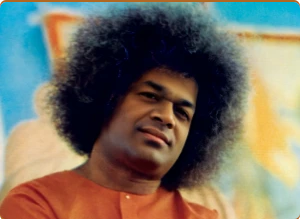
Sri Sathya Sai
Life & Message
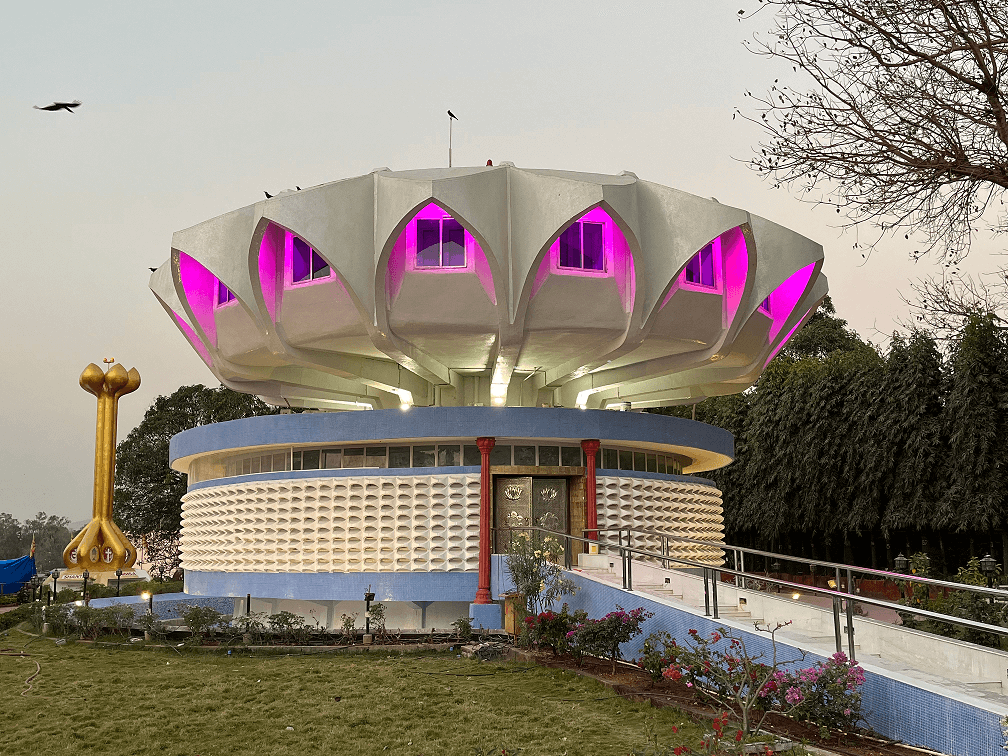
Dharmaskhetra
The Sathya Sai Center for Spirituality & Service in Mumbai
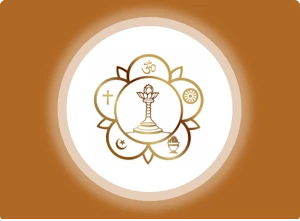
Sri Sathya Sai Trust
Founded in 1967, the first Public Charitable Trust founded by Baba himself
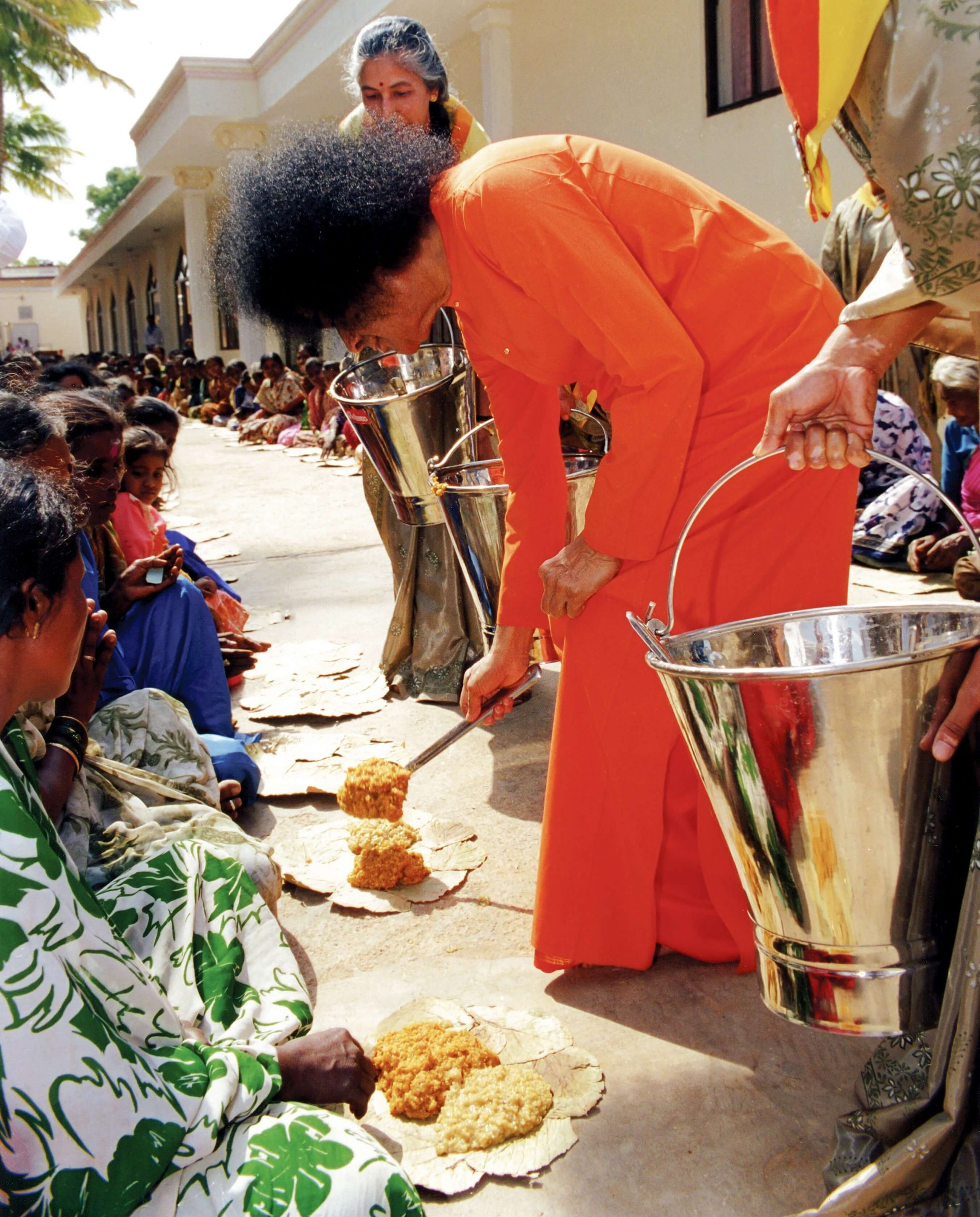
Service Activities
An enriching opportunity to participate and transform
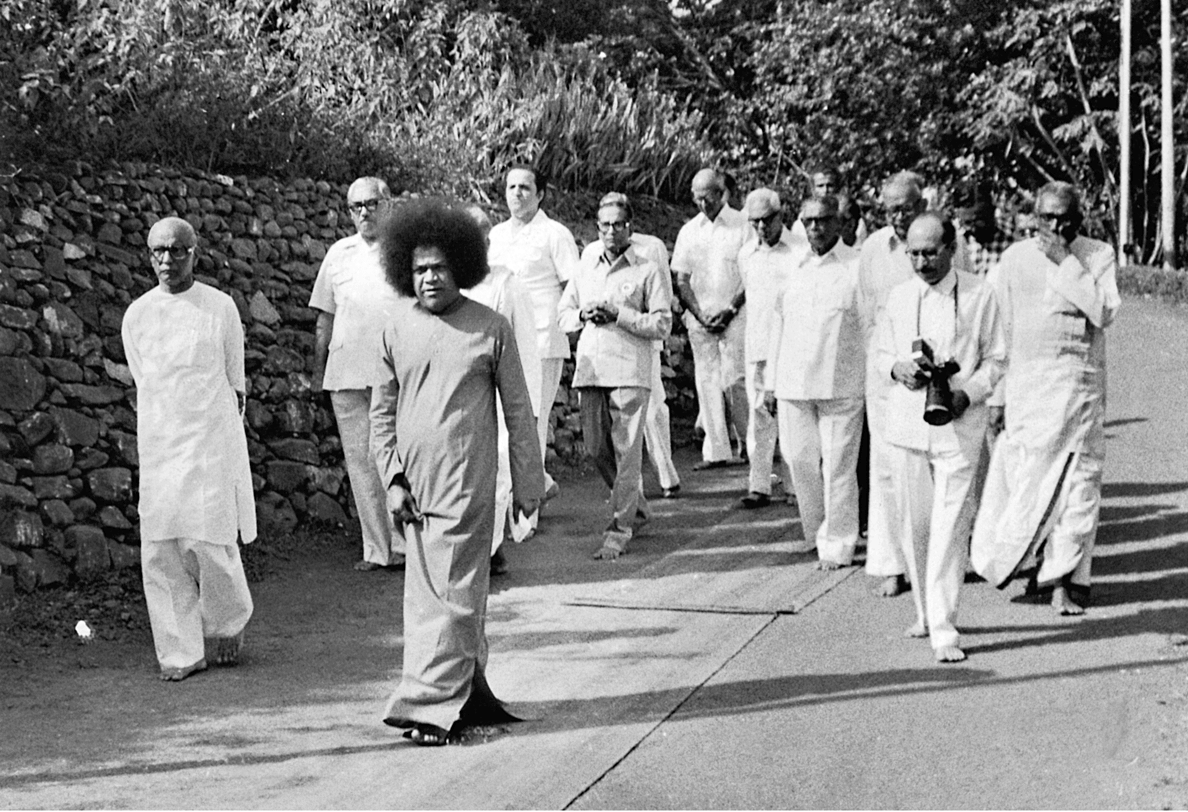
Baba's visits to Mumbai
A timeline of Baba's visits to Mumbai from 1960 to 2009

Divine Discourses in Mumbai
A compendium of discourses delivered by Baba during his numerous visits to Mumbai
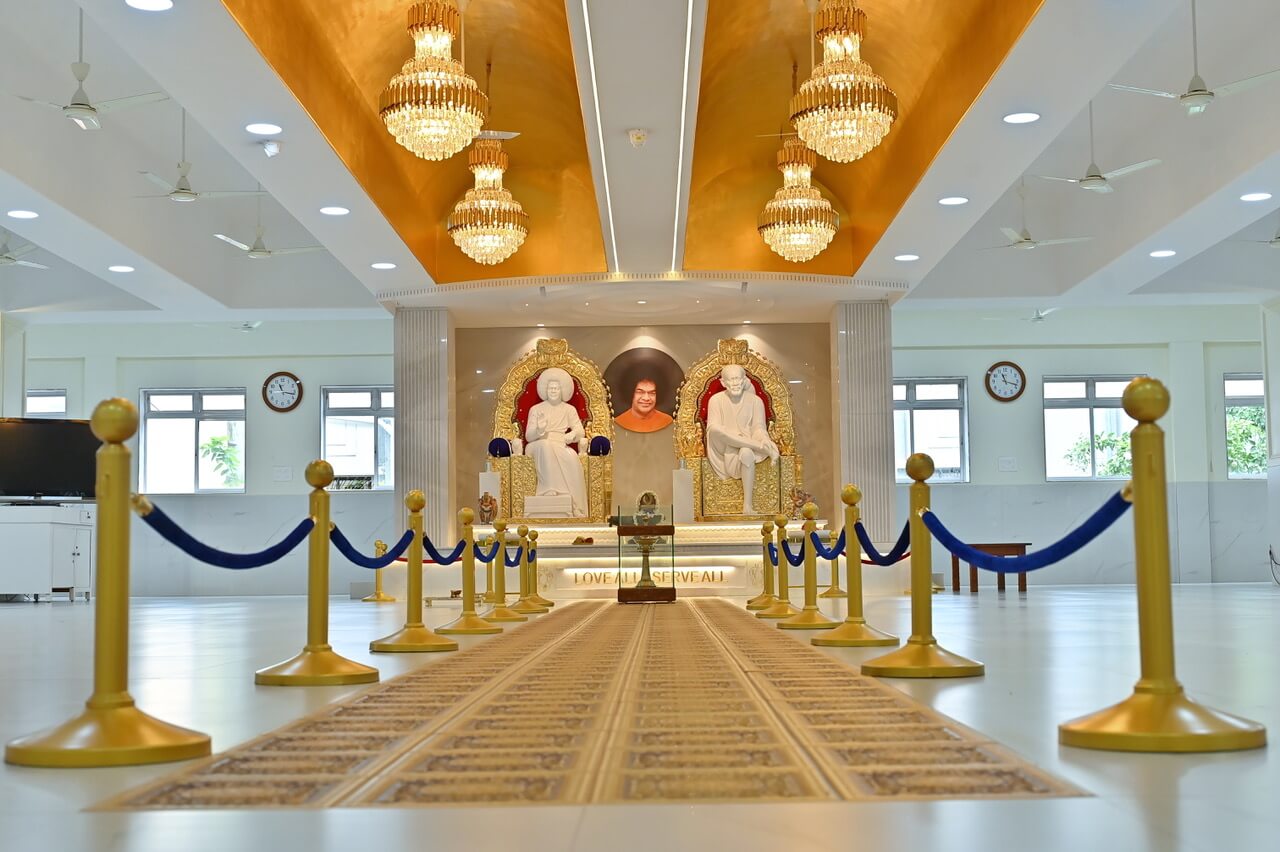
Sai Prem
The Sathya Sai Center for Spirituality & Service in Vashi, Navi Mumbai

Media Gallery
Down memory lane, a digital album of Baba in Mumbai
Volunteer
Medical Care
Are you a healthcare professional with a heart for service? We invite you to become a part of our team dedicated to providing much-needed medical care to those who lack access.
Your expertise can be a beacon of hope in the lives of the underserved.
Other individuals who would like to dedicate their time and energies to help us manage our facilities and be part of this journey are also welcome to join us
Nutrition, Education, and General Administration
Your unique skills and passion for making a difference can find a meaningful outlet here. Whether it’s nurturing young minds through education,
ensuring proper nutrition for vulnerable communities through our Narayan Seva community kitchen, or contributing to the smooth functioning of our
initiatives through general administration, your commitment can create a lasting impact.

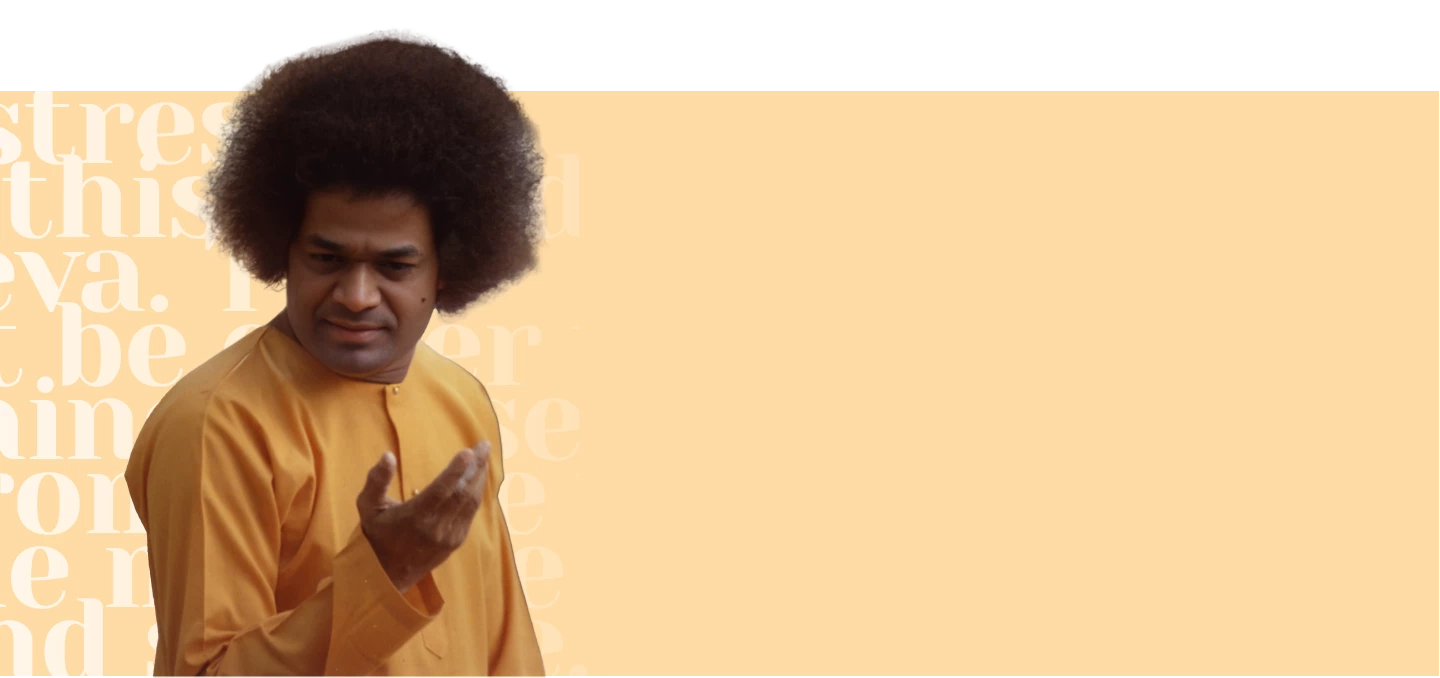
(1).png)